POST

History made in f ur sets
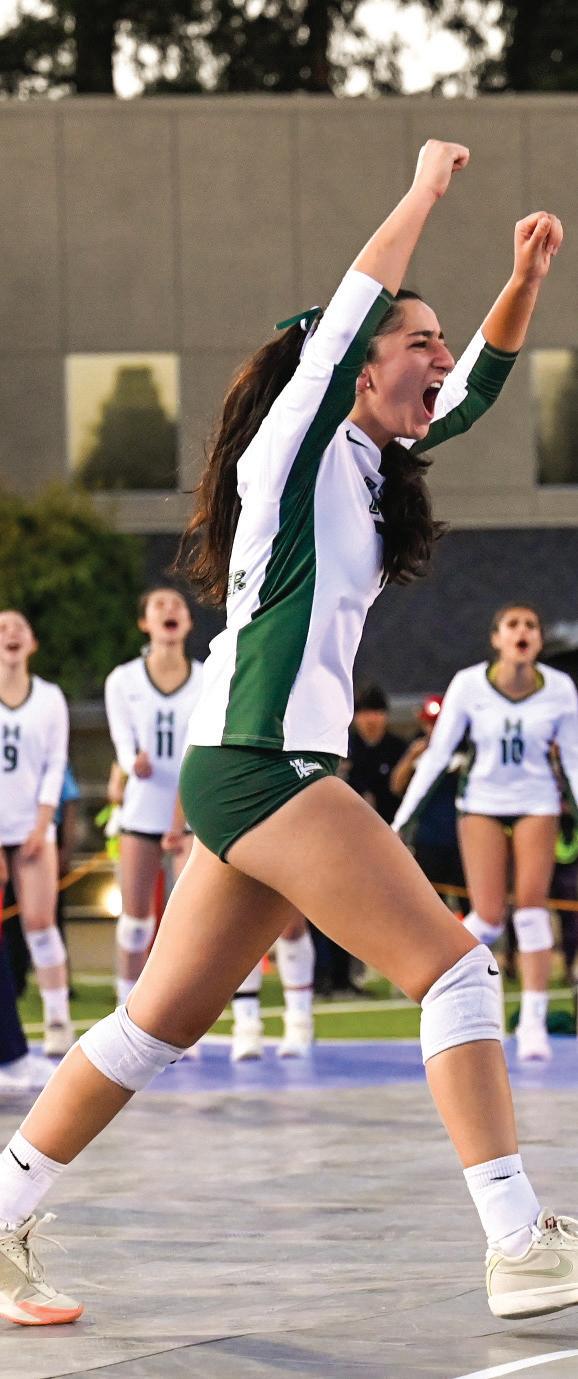
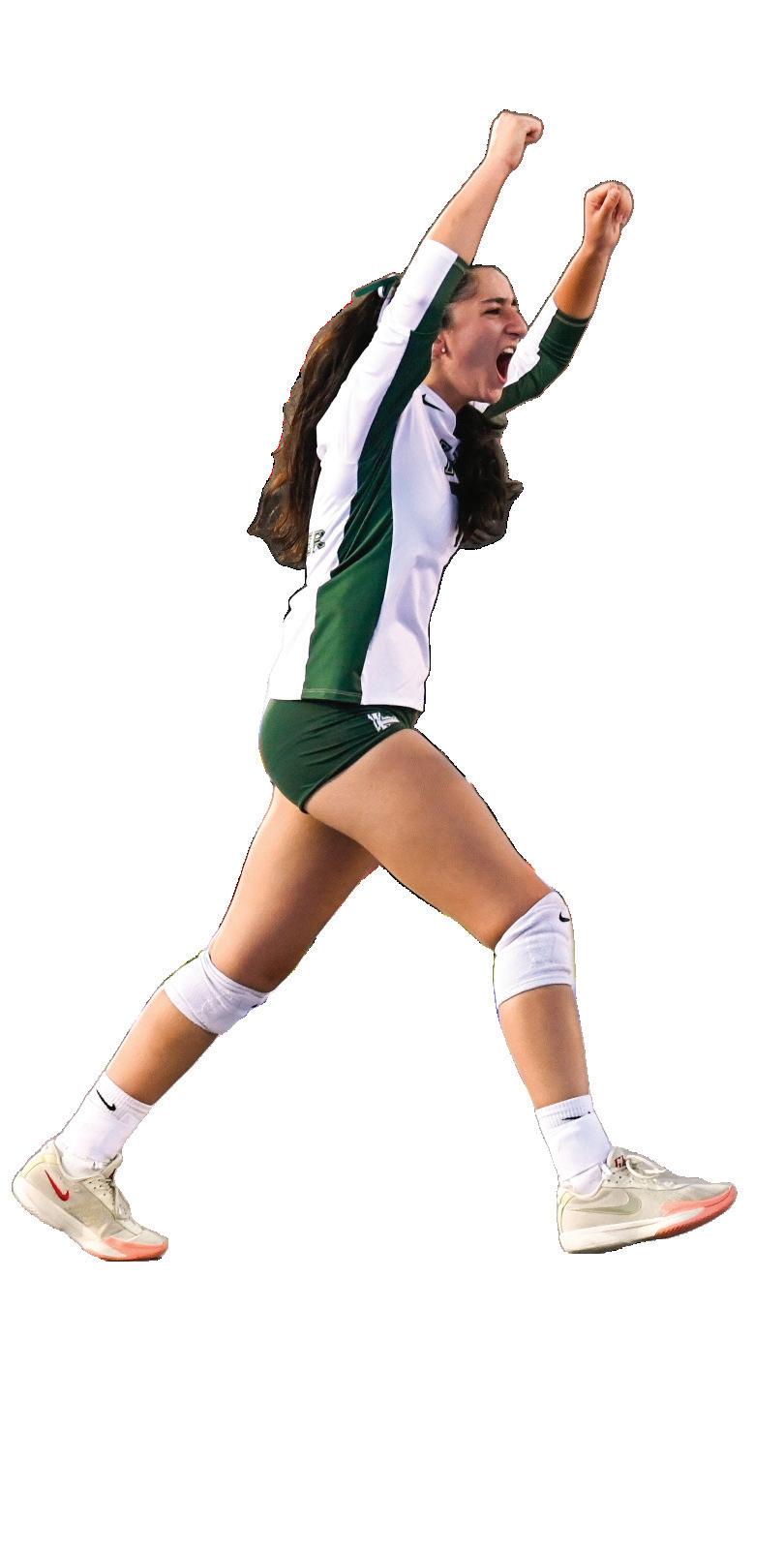

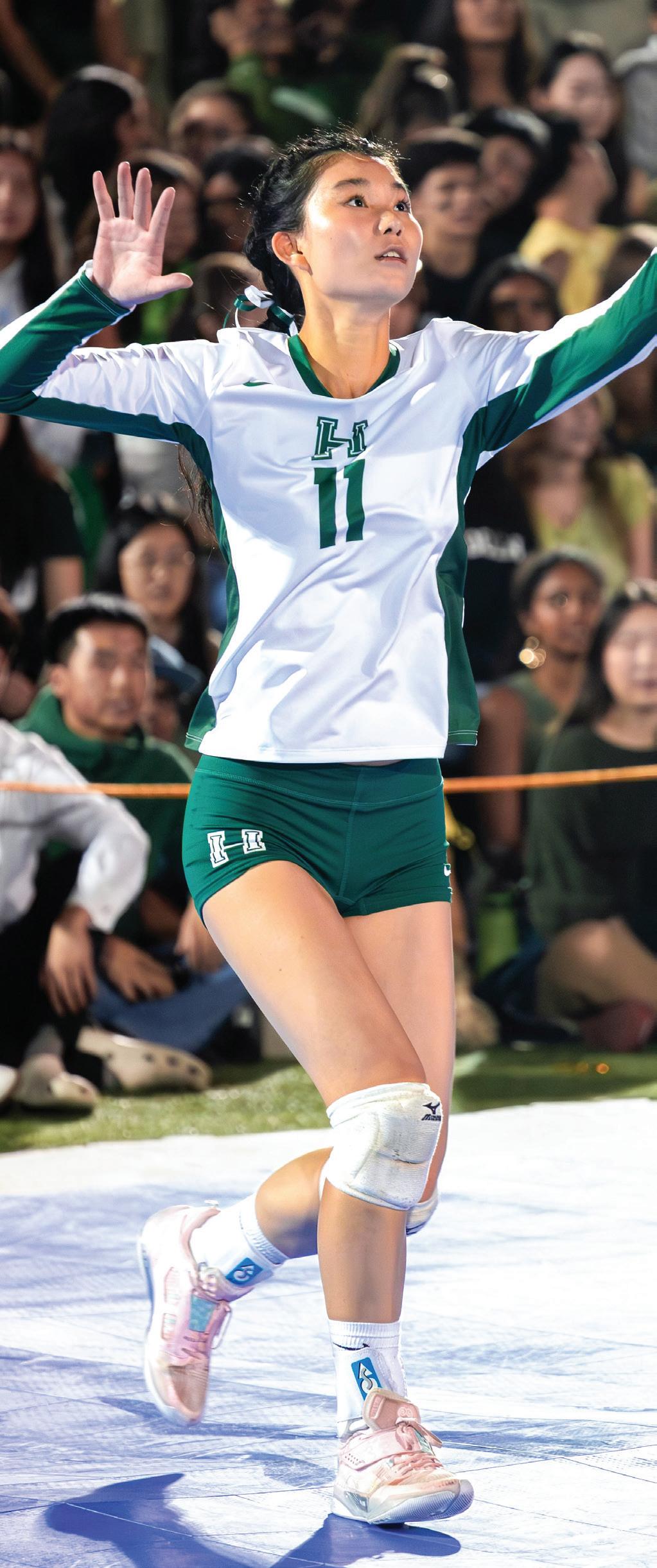

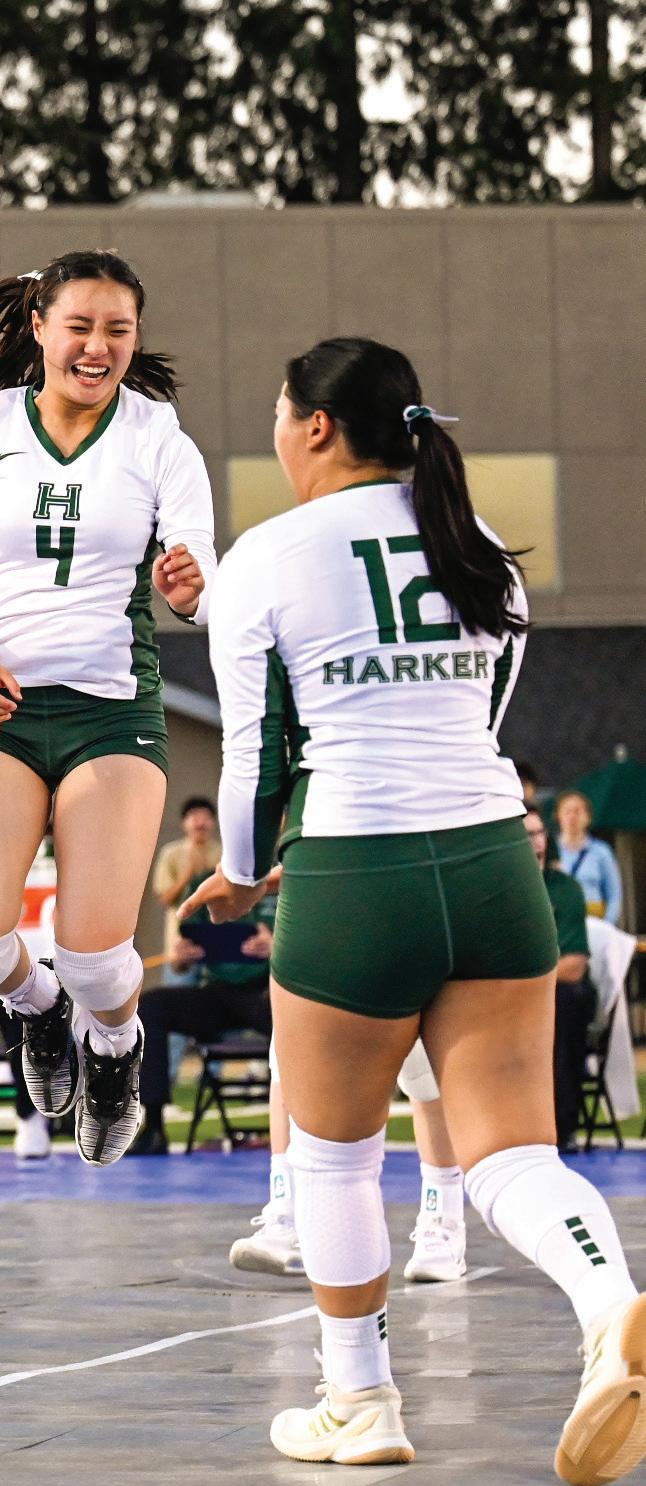

For the first time in school history, the varsity girls volleyball team competed in the homecoming game against Branham High School at Davis Field on Saturday. The team won in four sets, marking Northern California’s first outdoor high school volleyball game.
“It was really surreal that we got to have this experience because not many schools are able to do this,” varsity
girls volleyball opposite hitter Annabel Huang (11) said. “I’m really happy we beat Branham in four sets because last time we beat them in five, and it was really close. The energy throughout the game was incredibly exciting.”
The volleyball match replaced the traditional football game, which was cancelled due to safety concerns over a small roster.
Varsity girls volleyball setter Brooke Kubose (12) recalled her enthusiasm when
she learned that the team would play at the homecoming game.
“My initial reaction when our team found out was just smiling so big,” Brooke said.
“We went to the lower school for a sports assembly, and when they announced there was a volleyball match, all the little girls were really excited, which made me so happy. I also knew all my friends would be in the crowd at the game, and that really meant a lot to me.”
This year’s homecoming featured familiar highlights,
with pregame performances and cheerleading all taking place as usual. The “halftime show” between the second and third sets of the match included the crowning of seniors Sophia Ou and Timothy Deng as homecoming royals tug-ofwar between the sophomores and seniors and routines by Harker Dance Company and cheer. In the preliminary tugof-war rounds, the juniors defeated the frosh, and the seniors took the win against the sophomores.

SETA brings members together through birdfeeder painting
ashley mo & nathan yee
Students for Ethical Treatment of Animals (SETA) hosted a hands-on birdfeeder painting activity to promote animal care on Oct. 1 in English teacher Christopher Hurshman’s classroom.
Attendees utilized a variety of paint and colored markers to design blank wooden and acrylic birdfeeders. Many students experimented with colors and designs, creating decorations like flowers and abstract patterns.
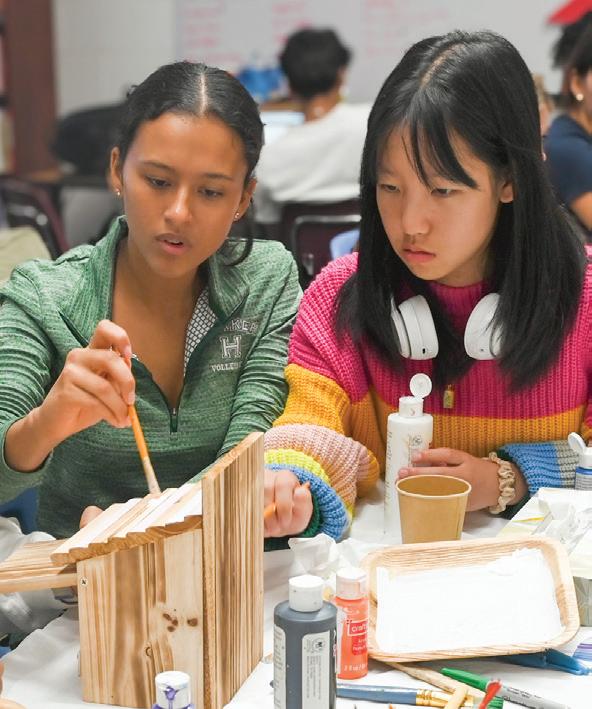
DECORATED DWELLINGS Frosh
Aanya Solanki and Maggie Hu paint a birdhouse together.
“Working on the design was my favorite part,” attendee Nila Gunaratnam (9) said. “We started painting and chose a floral theme. It was also satisfying painting the stripes on the roof.”
Participants will fill the feeders with birdseed and hang them in spaces on campus like outside the Main and Shah buildings in a future meeting.
“I’m excited to take care of animals by making different things like bird houses and bird feeders.

SOFE JALIL (10)
SETA CLUB DIRECTOR
”Director of External Affairs
Sofe Jalil (10) hopes SETA events will improve the longstanding issue of campus squirrels rummaging through potentially hazardous trash and compost bins.
“I’m excited to take care of animals by making different things like bird houses and bird feeders because around campus, we have squirrels and they aren’t really being taken care of, and they eat wherever they want,” Sofe said. “It’s not something we really care about, and my main goal is to bring this problem to light.”
Students showcase Harker Day booths
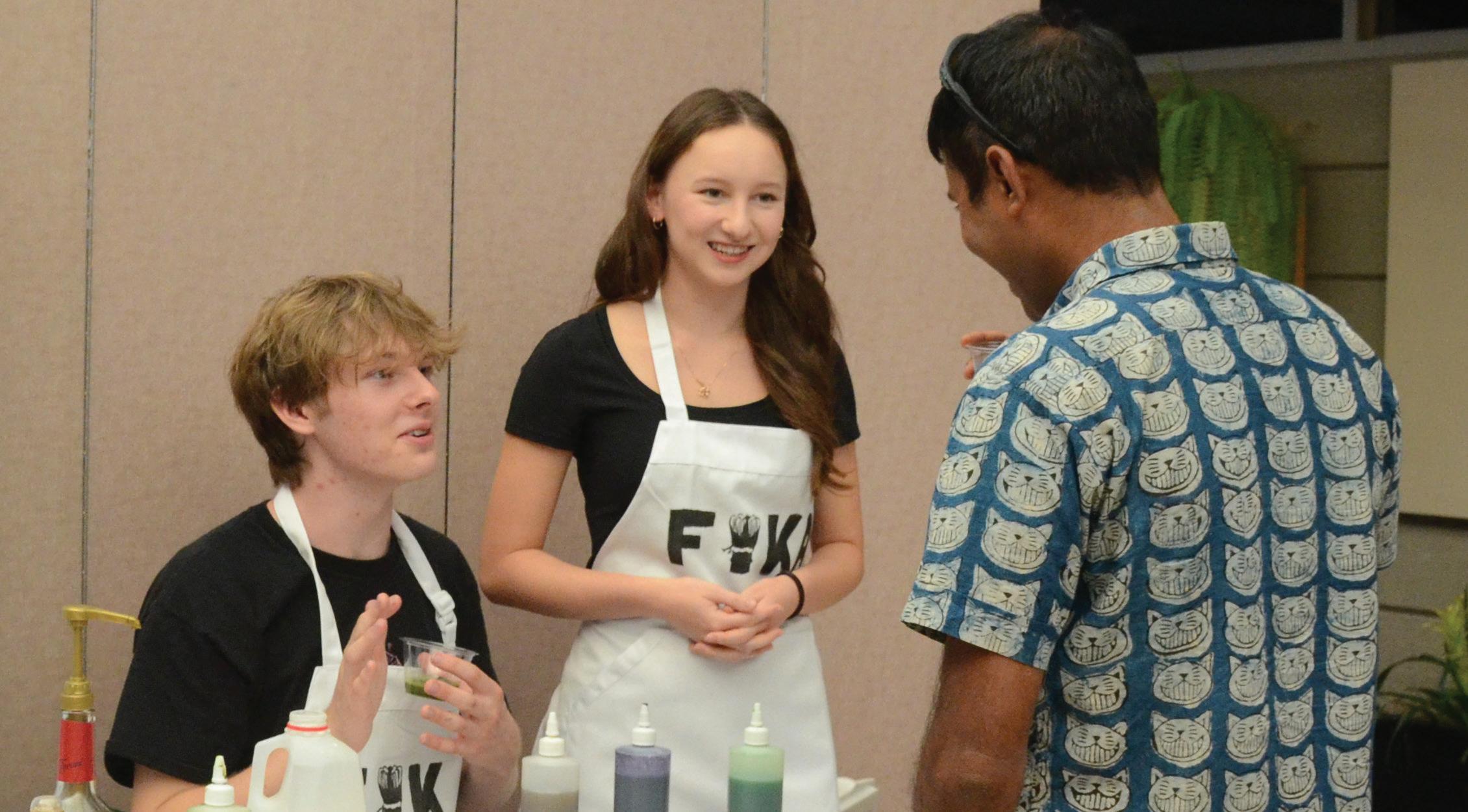
INNOVATIONS Juniors Stellan Lindh and Nicole Dean
cynthia xie & grace wu
Upper school students hosted fundraisers, booths and other activities at the Harker Upper school during the fifth annual Harker Day on Saturday.
Students hosting club booths welcomed visitors to explore their initiatives at Nichols Atrium and the Quad starting at 11:30 a.m. Many organizations featured handson activities, like practicing Chinese calligraphy with Chinese National Honor Society and creating smoothies with the Green Team’s smoothie bike.
Frosh Aaron Lau volunteered at the Tri-M booth, teaching participants how to create instruments out of simple materials like popsicle sticks, rubber bands and tape.
He expressed his joy in helping other students discover music through these crafts.
“Teaching kids origami has been really fun because they are very enthusiastic about learning.

AXEL SZOLUSHA (11)
JNHS BOOTH ORGANIZER
”“A really good way to learn music is to do it yourself, and this is a fast and easy way to be able to learn music,” Aaron said.
“It’s not a formal education of music, but people just get to have a fun experience with it.”
Annual festivities bring community together
suhani gupta & dyuthi vallamsetty
The Harker community enjoyed festivities ranging from games to food trucks and banner painting from 11:30 a.m. to 4:30 p.m. at Harker Day on Saturday.
Director of Community Service and Student Activities
Kerry Enzensperger ran a dog adoption center, encouraging attendees to meet and adopt unhoused dogs as part of the Tiny Paws Pug Rescue organization.
“Being the community service director, I feel it’s really important to practice what I preach,” Enzensperger said. “I volunteer with this organization, and they were willing to come out here with us to show adoptable dogs. It’s great exposure to have them seen by our families.”
Along with the dog adoption program, faculty members also ran various games throughout the day, including life-sized tetris, foosball, air hockey and ring toss.
Middle school learning specialist Kristen Morrelli, who attended her first Harker Day this year, manned the ring toss station.
“My favorite thing is seeing how excited the kids get with really simple games,” Morrelli said. “I’m just watching the families smile and have a fun day out here. Everyone’s in a happy mood, so that’s really nice.”
Lower school mathematics teacher Mira Vojvodic supervised the foosball table and reflected on seeing familiar faces.
“I love seeing my previous students come to say hello,” Vojvodic said. “My favorite part of the day was when my students from three years ago came and hugged me. The whole community comes together, and it’s really lovely to see that.”
For many students, Harker Day acted as a welcome break from the usual routine of school.
The Japanese National Honor Society (JNHS) upheld their strong value of service by helping younger students create origami. JNHS officer Axel Szolusha (11) voiced his excitement at spreading Japanese culture through a simple and entertaining activity.
“Teaching kids origami has been really fun because they are very enthusiastic about learning, and it’s really enjoyable to see them be excited about it,” Axel said. “There’ve been a lot of kids who actually wanted to take paper home and do more origami at home, so that’s been fun to see.”
Along with clubs, the Class of 2029 continued the annual tradition of frosh fundraising during Harker Day by selling pizza and drinks in front of the Zhang Gymnasium. Frosh Annika Pendse shared the best
strategies that her advisory used to have more people buy their products.
“The best tactic is to make it more enticing. The pizza and soda deal for $1 is actually a top seller,” Annika said. “Screaming at people and saying how many flavors you have for the soda is a great tactic. Also, because people really need water and they don’t know where to find it, you can sell it to them.”
Green Team officer Sasha Nazarenko (11) helped operate the club’s smoothie bike activity.
“I’m hoping the kids we talked to today will, going forward, be a little bit more conscious about the environment,” Sasha said. “I hope they enjoyed all the cool activities we had at our booth that directly relate to the environment.”
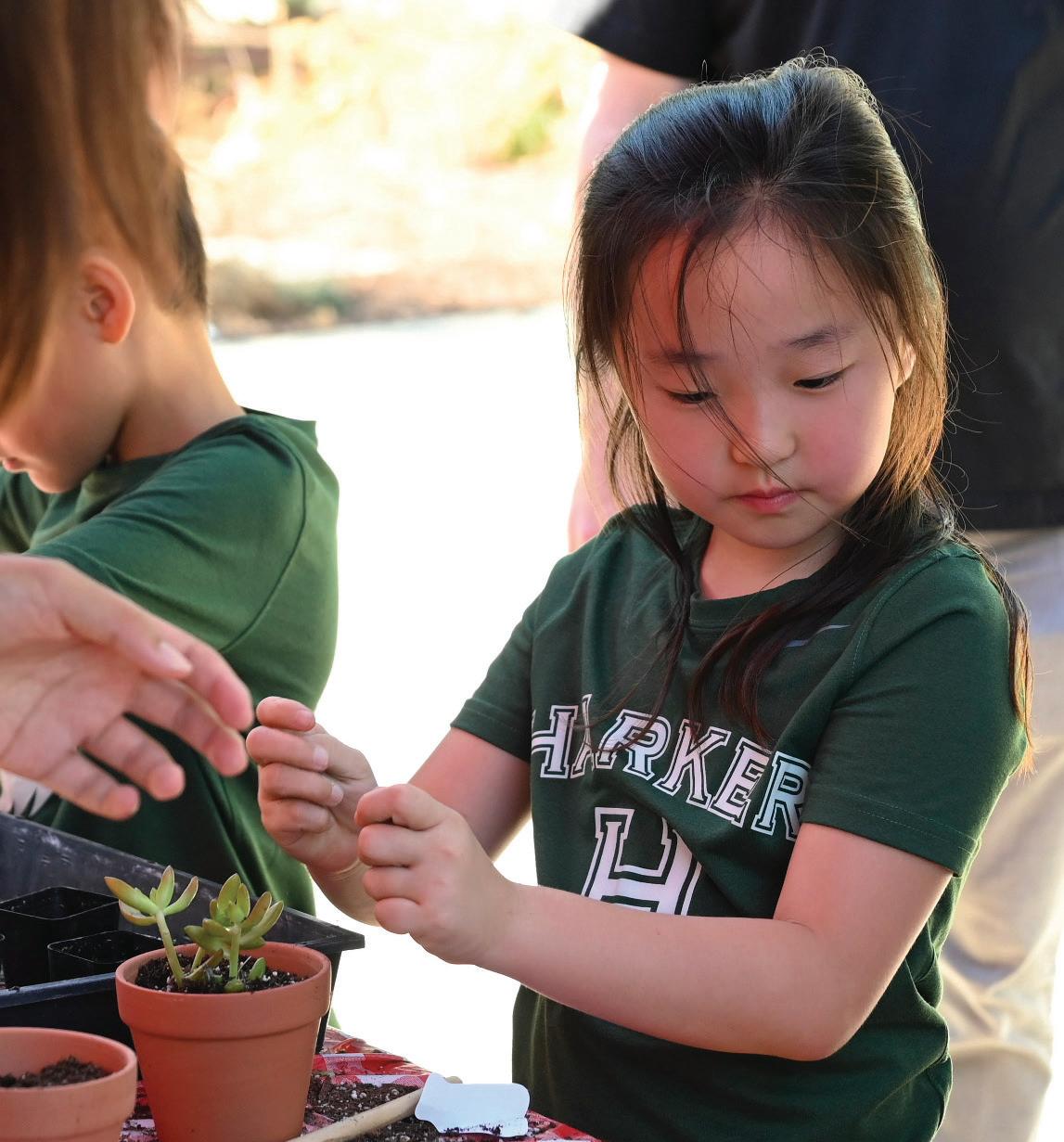
“It’s the one day when I can really be a kid,” seventh grader Max Brown said. “I don’t have any homework to worry about. I really enjoy Harker Day because I can basically do whatever I want and have fun.”
Harker Day also welcomed alumni through the reunion event in Manzanita Hall. Alum Hillary Brooks (15) came with her daughter Margot to experience the campus after graduating.
“My 10th high school reunion this weekend is wild,” Brooks said. “This place has such special memories for me — it’s so special to bring my daughter to the place I went to high school.”
National Honor Society inducts new members
National Honor Society inducted new members from the Classes of 2027 and 2028 during its annual ceremony on Monday in the Nichols Auditorium.
NHS adviser Christopher Davies, along with copresidents Selina Wang (12) and Shimeka Sahu (12) and vice presidents Hannah Jiang (11) and Aanya Aggarwal (11), highlighted the four pillars of NHS membership: scholarship, leadership, character and service, while officers lit candles for each pillar.
“Character is the force within an individual that distinguishes each person from
oneself, nor hope to attain the respect of others. It is this force of character that guides one. Character is not achieved and not received — it is the product of a constant thought in action and the daily striving to make the right choice.”
Current NHS members shared their volunteer experiences and explained the influence of their work in the local community. Junior Audrey Hu described her work teaching science and art to children with the San Jose Public Library, while senior Nikhil Sharma described his experiences teaching dance at a YMCA and the West Valley Library.

Junior Megha Unny spoke about volunteering at an organization called Speak Up for Kids, where she works with children to help them gain confidence skills through music lessons.
“When I met my first student, I realized it didn’t really matter if my lesson plans weren’t professional because the amount of joy he got from our classes just made me so happy,” Megha said.
“My student has mild cerebral plasticity, so it’s really hard for him to play instruments.
I asked him, ‘Do you have any
Journalist Mark Murray levels up photography
sharma & ashley zhou
Photojournalism instructor
Mark Murray visited Harker journalism from Sept. 29 to Oct. 2.
Murray serves as Executive Director of the Association of Texas Photography Instructors and has worked with Harker Journalism for years as the high school program’s Journalist-inresidence, offering workshops and one-on-one critiques for student journalists.
He guided classes through hands-on photo shooting, photo analysis, Lightroom practice and discussions about storytelling.
“The thing I’ve been stressing this week is how your job as journalists is to show your readers what they missed or what they didn’t get to see,” Murray said. “Especially with Harker Day coming up this weekend, I hope you take that to heart and figure out how to create as interesting a story as you can.”
Murray’s advice offered students fresh perspectives on photography. Sports Editor Lily Peng (11) noted the impact of his workshops.
“He shared a lot of really useful tips, especially about cropping and removing
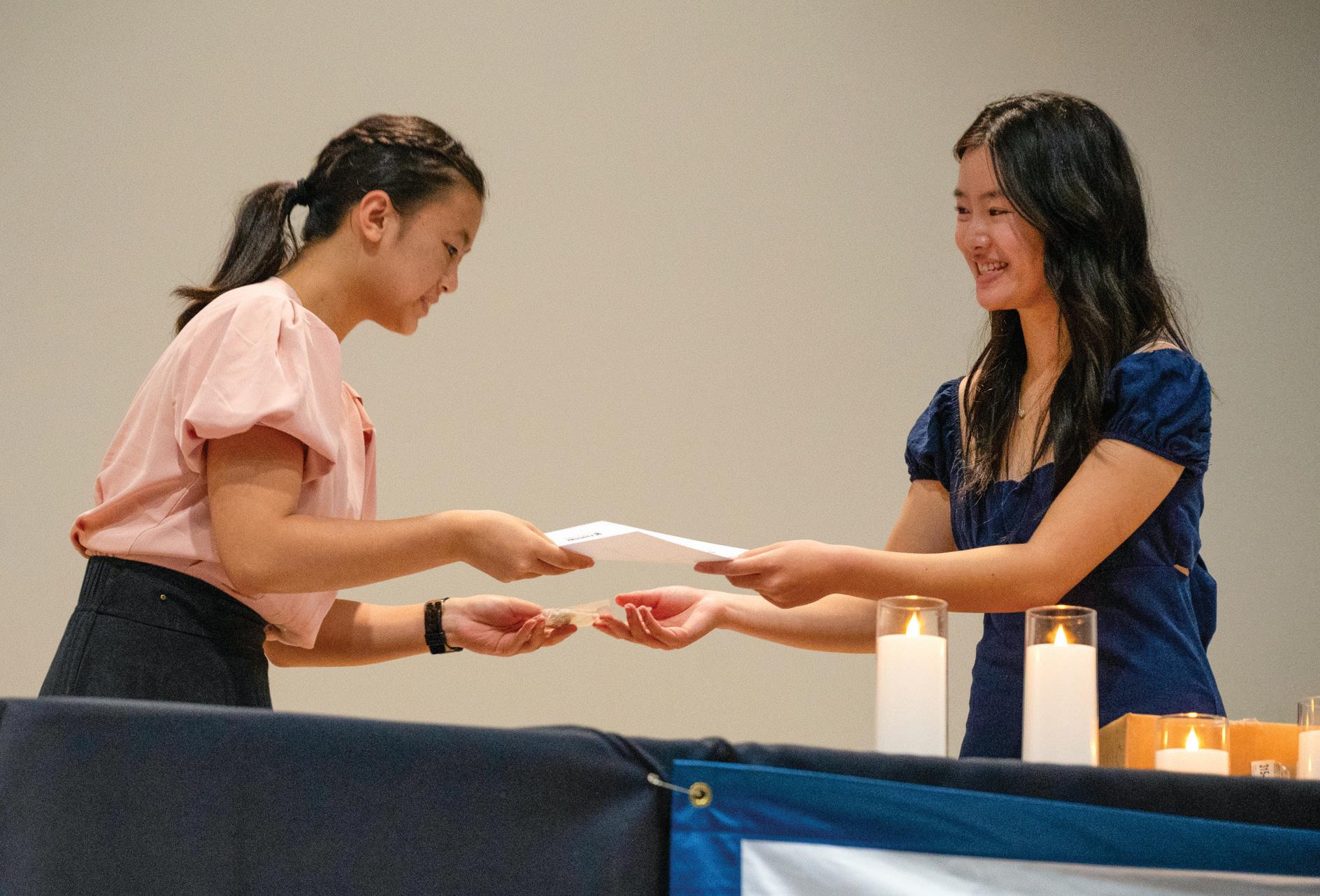
experience with singing?’ He looked at me with the cutest smile and said, ‘Sometimes I sing in the shower.’ It made me more happy that I was able to make a difference in his life and get him to start singing outside of the shower.”
Officers read out the name of the new inductees and handed them a certificate before each took photos with Davies.
“Members of our chapters serve as role models for other students,” Davies said. “Chapter members are leaders on campus. We volunteer at the upper school open house, help organize Harker Day, assist with the Eagle Buddies and provide ushers for graduation. We volunteer all
over the South Bay in a wide variety of organizations. We are proud of the positive impact.”
“It made me more happy that I was really able to make a difference in my student’s life.

MEGHA UNNY (11)
After the student speeches, Davies introduced
Milk Tea Monday
distraction from photos,” Lily said. “The photo reviews after school were my favorite part — I learned tricks I can apply to my photography in the future.”
Murray praised Harker’s journalism, highlighting the program’s consistent excellence.
“I’ve always admired the tenacity and drive that you bring to storytelling,” he said. “You do it exceptionally well, and the awards you’ve received are an indication of that. It’s something you’ve taken to heart, and now it’s a tradition.”
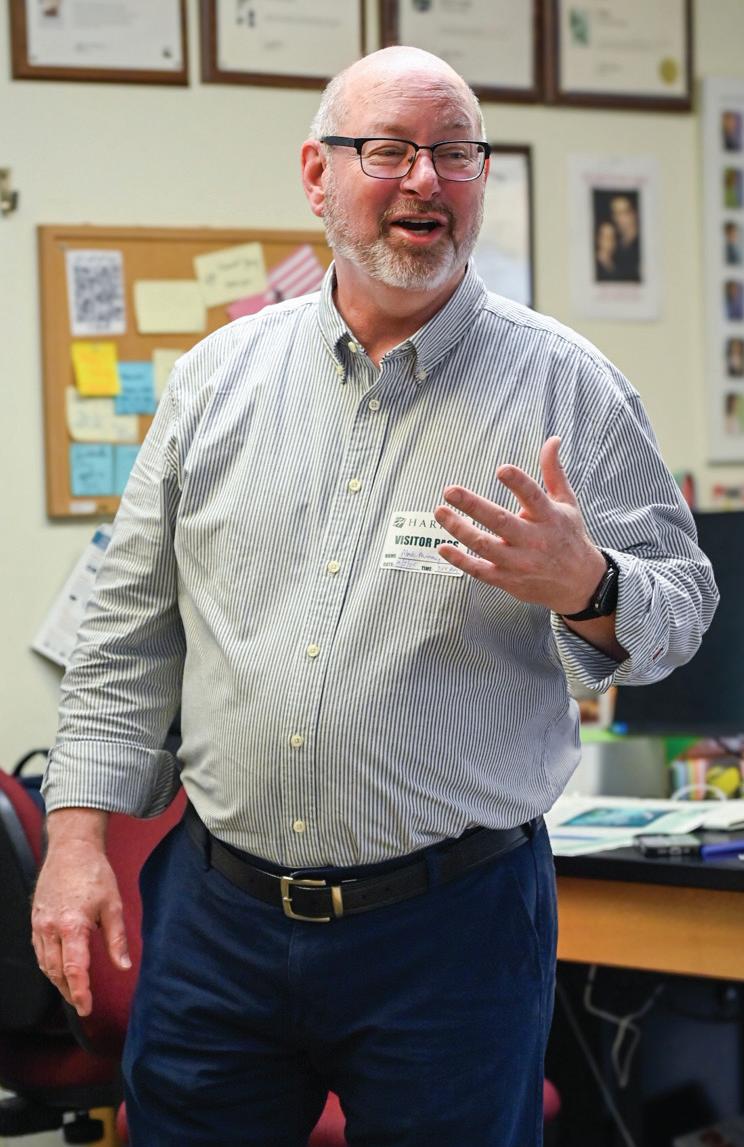
mathematics teacher Bradley Stoll, this year’s faculty speaker at the ceremony. Stoll emphasized the importance of service and shared personal stories of volunteering to highlight how small acts help contribute to a meaningful difference.
“What I try to do is more on the street service side,” Stoll said. “We used to go to a house and gather every Wednesday evening, and [my close friend’s] parents served meals to about 50 people. We had done a meditation there, and she would make meals for us, and it was one of the most incredible acts of service I’ve ever seen anyone do.”
bridges sweet drinks with sustainable mission
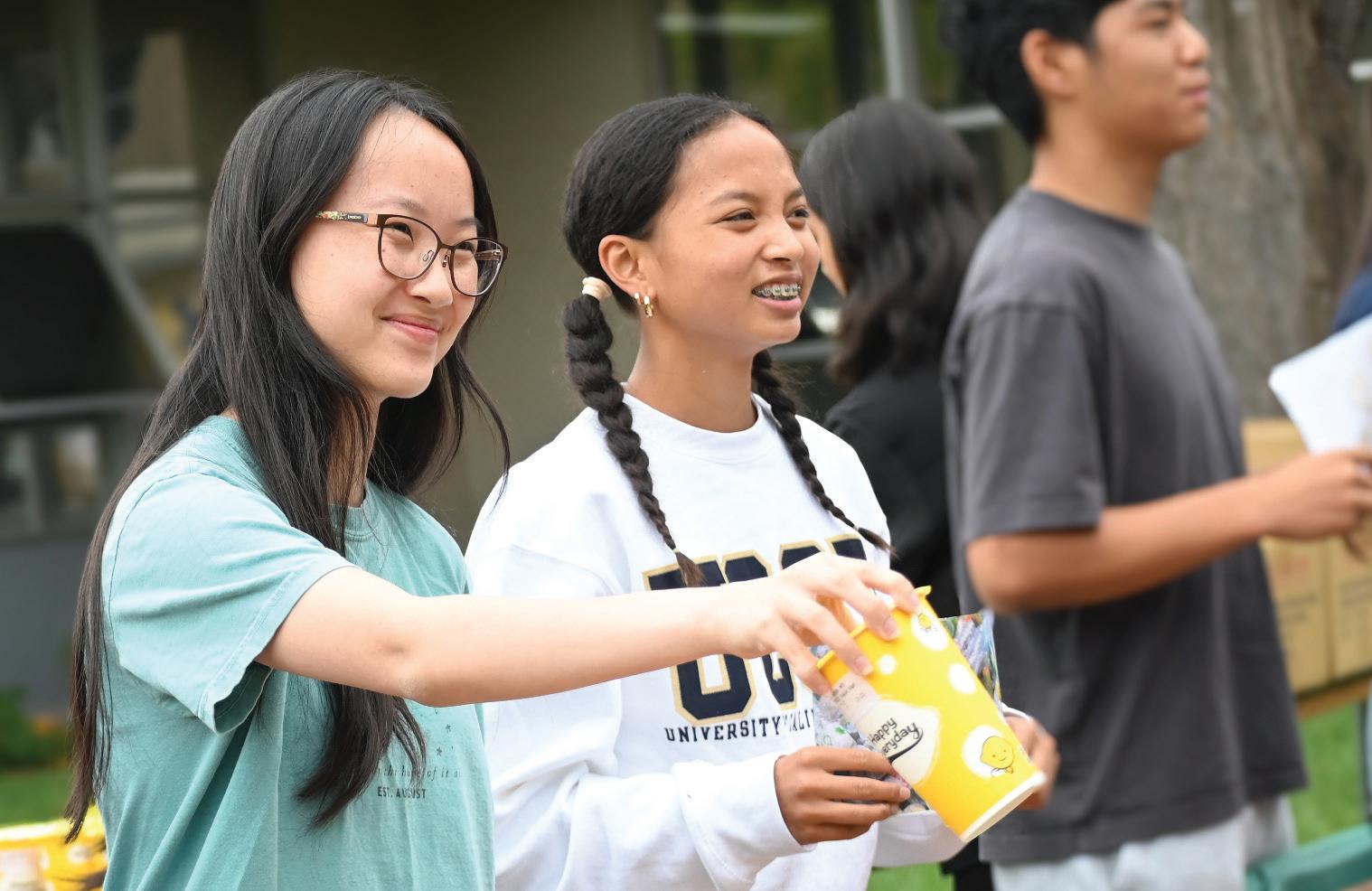
ASB and Green Team’s first “Milk Tea Monday” on Sept. 29 drew 160 participants to the Quad.
They sorted sample trash to earn boba as part of a sustainability initiative.
Organizers included this extra step of categorizing trash to raise awareness about proper recycling and composting practices on campus. Sophomore Eden Alhuwalia noted that the hands-on practice made her more mindful about ecofriendly habits.
“The trash sorting activity wasn’t too difficult, but it definitely made me more aware of what goes where,” Eden said. “It showed me how small actions like sorting properly can actually make sustainability on campus much more achievable.”
Those who succesfully completed the activity were rewarded with a choice of two drinks: a classic milk tea with honey boba and a passionfruit tea with lychee jelly.
Senior participant Koby Yu appreciated the chance to try a tasty drink in the middle of the school day.
“It honestly made my day a lot better,” Koby said. “It’s just so nice to walk back to my lunch table with a refreshing milk tea. Somehow having boba during the middle of the day feels so much more fun than going across the street to get it after school.”
Students registered to receive boba using a Google Form that went live on Sept. 12, with 40 spots available for each grade level. The sign-up was filled on a first-come, firstserved basis.
Because of the limited supply, the registration form closed quickly and left some unable to sign up. ASB Vice President Amishi Gupta explained that ASB is considering alternative systems to make future events more equitable.
“We were discussing ways of having priority for other people who have not already gotten boba at a prior Milk Tea Monday,” Amishi said. “Or we might cut back the number of Milk Tea Mondays but distribute it to all students on that day.”
In the future, ASB will continue to connect Milk Tea Monday events with other campus initiatives.

U.S. government shuts down
Congressional Democrats and Republicans failed to pass a new funding plan, forcing a government shutdown on Oct. 1. Republicans demand to cut healthcare subsidies, while Democrats resist. This echoes a previous standoff this year when Senate Minority Leader Chuck Schumer accepted a Republicansupported bill to cut government spending. The shutdown will suspend approximately 750,000 federal workers.
U.N. delegates walk out on Netanyahu speech
Dozens of delegates, including those from Iran and the U.K., exited the United Nations General Assembly hall in New York during Israeli Prime Minister Benjamin Netanyahu’s speech on Sept. 26. Netanyahu condemned recent decisions by France, Canada and other major countries to recognize Palestinian statehood and emphasized that Israel is not committing genocide in Gaza.
Amazon’s “flying rivers” deteriorate
Deforestation and global warming are weakening moisture streams flowing from the Atlantic Ocean across the Amazon basin. Brazilian scientist Carlos Nobre, who helped coin the term “flying rivers,” estimates that these rivers provide half the rainfall near the Andes Mountains. Researchers warn that the Amazon will transform into a savannah without stronger protection from governments.
Pro-E.U. party wins Moldovan elections
President Maia Sandu’s proE.U. Party of Action and Solidarity secured 50.1% of the vote in former Soviet republic Moldova’s Parliament elections on Sept. 28. They scored 101 representatives despite accusations of Russian interference, like bribery and cyberattacks, which Moscow has denied all allegations of.
The results of the election could determine whether the country joins the E.U. or returns to Russian influence.
Nepal names first female prime minister
Former Nepalese Chief Justice Sushila Karki became interim prime minister on Sept. 12. Youth-led protests forced the former Prime Minister KP Sharma Oli to resign earlier that month. The demonstrations against government corruption and nepotism resulted in over 50 deaths, including protesters shot by police.
Proposition 50 brings redistricting to ballot

California voters will decide on Proposition 50, California’s state plan to redraw congressional election maps, on Nov. 4. This comes after Gov. Gavin Newsom signed the proposition on Aug. 21.
Redistricting is the redrawing of state district lines that determine how our House of Representatives legislators are elected, typically done after the Census results every 10 years to keep district populations balanced for fair representation.
Newsom’s proposal will redefine districts in the middle of the typical decade-long period and is a direct response to Texas’s redistricting efforts to add five Republican seats.
“The political state of our country is becoming more polarized because [Newsom’s] actions felt like a response to Governor Abbott of Texas,” sophomore Elaine Huang said. “Newsom has this reputation in
California where he is very antiTrump, but at the same time, he still has some very conservative values, so it was an interesting moment for Californians.”
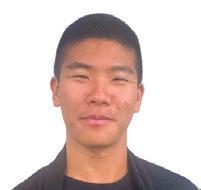
In California, a citizen-led group separate from politicians called an independent citizen commission holds public meetings to gather opinions before drafting and voting on a new map. Prop. 50 represents a distinct departure from the established process, which was designed to remove partisan influence from their redistricting decisions.
“In the state of California, you have to apply to be on the redistricting committee,” AP Government and Civics teacher Carol Green said. “They’re looking for political diversity, so we can only have so many registered Republicans and so many registered Democrats, and the rest have to be registered independent or third party.”
Individual states have power to determine their legislative processes for redistricting. Thus, some legislators modify redistricting for their own goals, as demonstrated in Newsom and Abbott’s leveraging of districts to gain House seats. The term gerrymandering describes the improper usage of the process to benefit a certain political party.
“The federal check doesn’t deal with political gerrymandering,” Green said.
“The Constitution leaves elections to the states, so for the most part, gerrymandering is legal and mostly depends on rules are set up per state.
If the people of the state want to change that, they’ve got
California residents hold rally to vote ‘yes’ on Proposition 50
Demonstrators rallied for voting rights at the intersection of Hanover Street and Page Mill Road on Sept. 29 evening.
Participants held signs encouraging people to vote ‘yes’ on Proposition 50, a measure

California’s congressional districts. Organizer Scott Herscher has brought together a group of people who consistently gather with signs and banners to make their voices heard at demonstrations.
Herscher explained his intention behind starting these events after noticing widespread political apathy.
“Democracy only works as much as the electorate is willing to work for it, and if we don’t work for it, the electorate is not going to work either,” Herscher said. “People got lazy and stopped putting work into maintaining our system of government. Unless people get out of their comfort zones and take to the streets in large enough numbers, we’re going to be stuck with what we have now.”
A regular demonstrator, Ashley views Prop. 50 in relation to recent districting in Texas, where the state’s leaders had


to change who their elected officials are.”
Newsom’s plan will require a special election in November, where California voters will decide whether to approve new maps. If passed, the redistricting would take effect for the 2026 midterm elections, prompting states to rush the process to potentially shift the balance of power in Congress.
Ballot measure contribution totals as of Sept. 28 and a poll by Emerson Polling on Sept. 19 indicate California citizens are in favor of passing Prop. 50.
“It’s really a fighting fire with fire situation,” Civic Discourse Club President Timothy Deng (12) said. “If democracy is under threat in other states, are we going to fight that by putting democracy under threat in our own state? I worry that adopting these undemocratic tactics is only going to further degrade American political culture.”
redrawn the congressional district maps without public input, a move she criticized as gerrymandering in an unfair way.
“Constituents in Texas didn’t get a chance to pick when it came to gerrymandering, but we are actually getting a choice to vote,” Ashley said. “As Californians, we should stand up for our fellow Texans. They lost five seats, and we’re taking five, so it’s like standing in solidarity with our red states.”
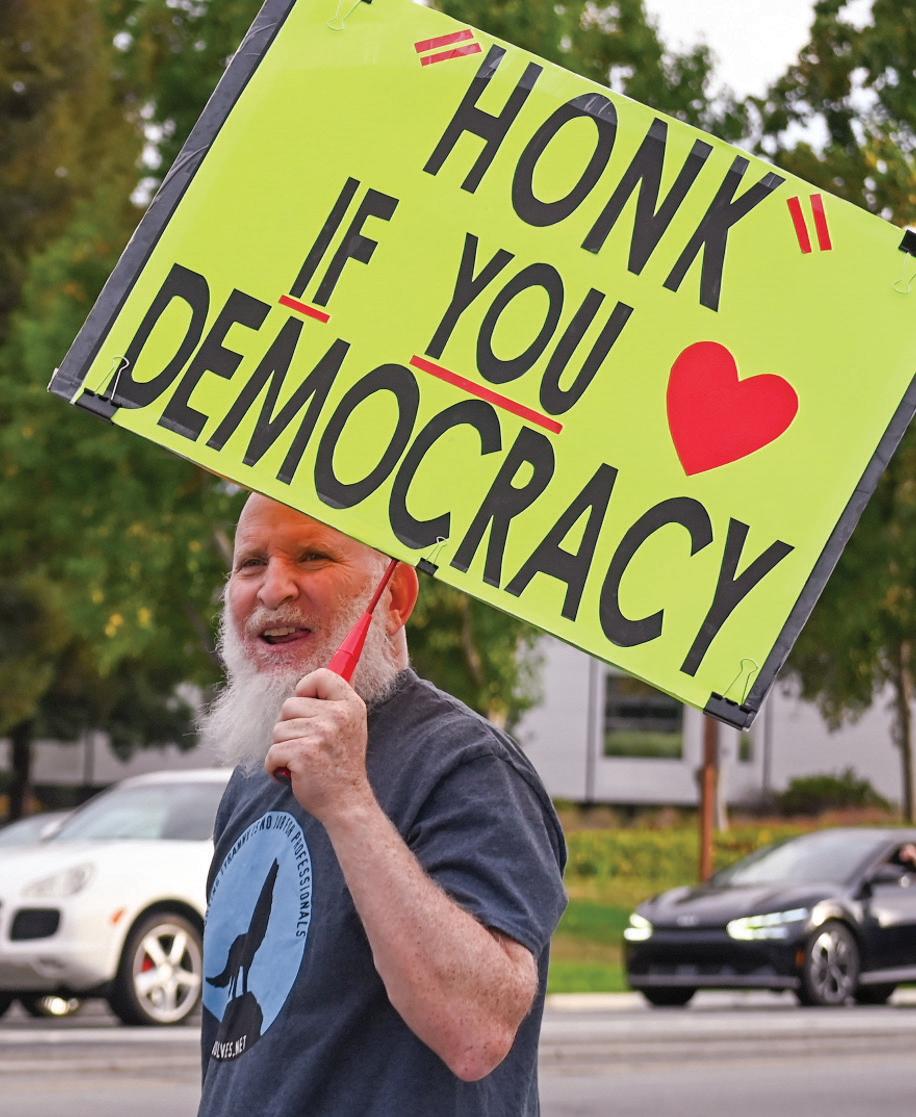
Another participant, who asked to remain anonymous due to security concerns, echoed Ashley and emphasized the national implications.
“I think what’s going on in California is good because if the Republicans control the House, there will be more money to give to Israel to continue the war in Gaza,” the source said. “Finally, the Democrats are being more aggressive and playing by the Republicans’ rules. There’s enthusiasm around ‘yes’ on Prop. 50.”
Modernization meets mistrust
Wi-Fi rollout sparks questions over transparency
CONCERNING
Students across all Harker campuses returned to find a new Wi-Fi system in place this fall: a single unified network, HarkerApproved. To connect, students were required to install a digital certificate, a piece of software that verifies a device belongs to a specific user.
While the overhaul was implemented to modernize infrastructure and improve cybersecurity, it also raised questions about privacy, with many students feeling unsure about what information the certificate could access. In a Schoology survey sent to upper school students with 163 respondents, 61.7% reported being moderately to extremely concerned about their browsing being monitored. Only 8.6% are not concerned at all.
It’s like the logging you have at home from your ISP — they know where you go online.

JESSE LARA DIRECTOR OF INFORMATION TECHNOLOGY
“When I first installed it, I heard some people saying things like, ‘It’s invasive, it’s root-level access,’” senior Laura Treves
said. “I tried to figure out what it was and to learn more because I was worried about the security of it, like if some outsider could access my data. There was the feeling of, ‘What can it see? What can it track?’”
“A lot of this stems from needing a more modernized hardware,” Lara said.
According to Information Technology staff, Harker has always had the ability to review internet logs, similar to how any internet service provider (ISP) can track user activity. These logs record which websites are visited, at what time and from which IP addresses.
The new certificate links each device to a specific user account and assigns it to the correct network — student, staff or guest — which makes it easier to confirm which user accessed a particular site in situations where an investigation into internet activity is required.
“It’s like the logging you have at home from your ISP — they know where you go online,”
Director of IT Jesse Lara said.
“If we were directed to, we could check who accessed a certain website at a specific time. Because of the certificate, it’s now easier for us to confirm with certainty, for example, that Dan went to YouTube at 11 o’clock. What he did on YouTube, though, we can’t see.”
Only Lara, Network Manager Dan Riemer and his two team members can access logs, and they only do so upon direction
CONNECTIONS New Wi-Fi raised concerns over tracking and security. “I was worried about the security of it, like if some outside could access my data,” senior Laura Treves said.

by administrators, usually in connection with academic integrity investigations. The certificate does not give the school real-time monitoring ability or capture private content like typed text, downloaded files or watched videos.
“We are only looking at those logs if we are directed to do so,” Lara said. “I’ve been here 25 years. I think I’ve been asked twice over that course of time where they wanted to know who, when and where. Back then it was more difficult to do so. It’s easier to do now, but it also protects the student: If the student says they didn’t do it, this actually helps to prove that.”
Visit harkeraquila.com for more.
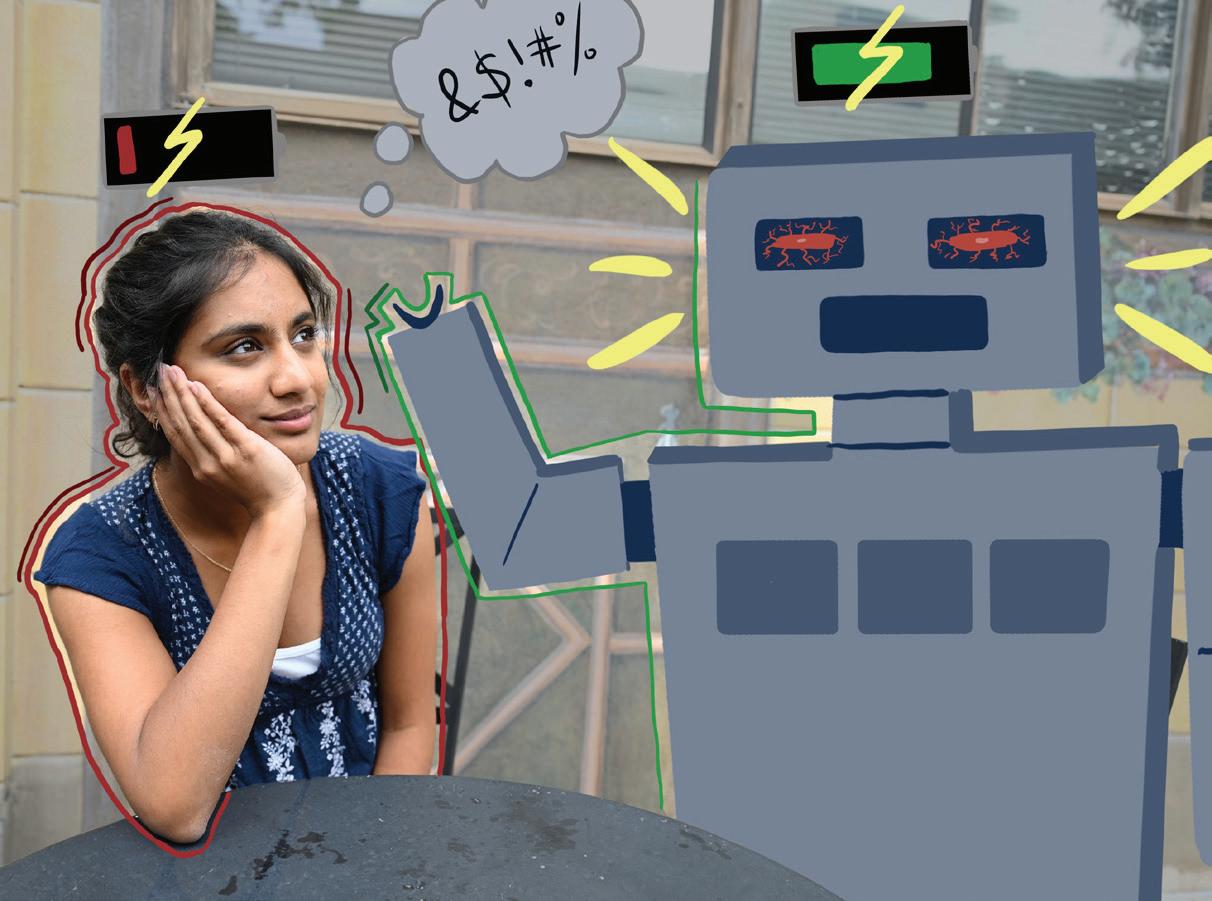
Influencer Stanzi Potenza posted a YouTube Short on Aug. 20 captioned “POV: You’re a clanker in 2050.” In this video, she portrays a waitress belittling a “clanker” which arrives at her restaurant, creating a 1950s Southern aesthetic with the setting and accent she adopts. While the video received
generally positive reception, some commenters criticized how it mirrors 20th century racism towards Black people. Moreover, she uses the word “wireback” to refer to robots, a term derived from the word “silverback,” which was once used in the past to dehumanize Black people.
“It feels like people are trying to commodify actual oppressed people’s suffering and turn it
into something that they can joke around with,” Language and Linguistics Club officer
Jessica Hu (12) said. “The use of ‘clanker’ is primarily by people who are not of a minority status, and they want to have a reason to insult people. It’s like they want the opportunity to say their own minority-associated slur.”
For some, the trend of demeaning robots may be an outlet for them to express their resentment towards minorities in a socially acceptable way, Jessica says.
“They think what’s happening is that they don’t have the freedom of speech to demean minority groups,” Jessica said. “But they still have the feelings of hatred in their heart, so they instead need to project those feelings onto some other topic.”
Potenza’s video contributes to a trend where creators denigrate robots and AI as “clankers” and similar insulting words, contributing to over 26,000 posts under the tag on TikTok and 5,000 posts on Instagram. While use of the term “clanker” itself may be rooted in more racially
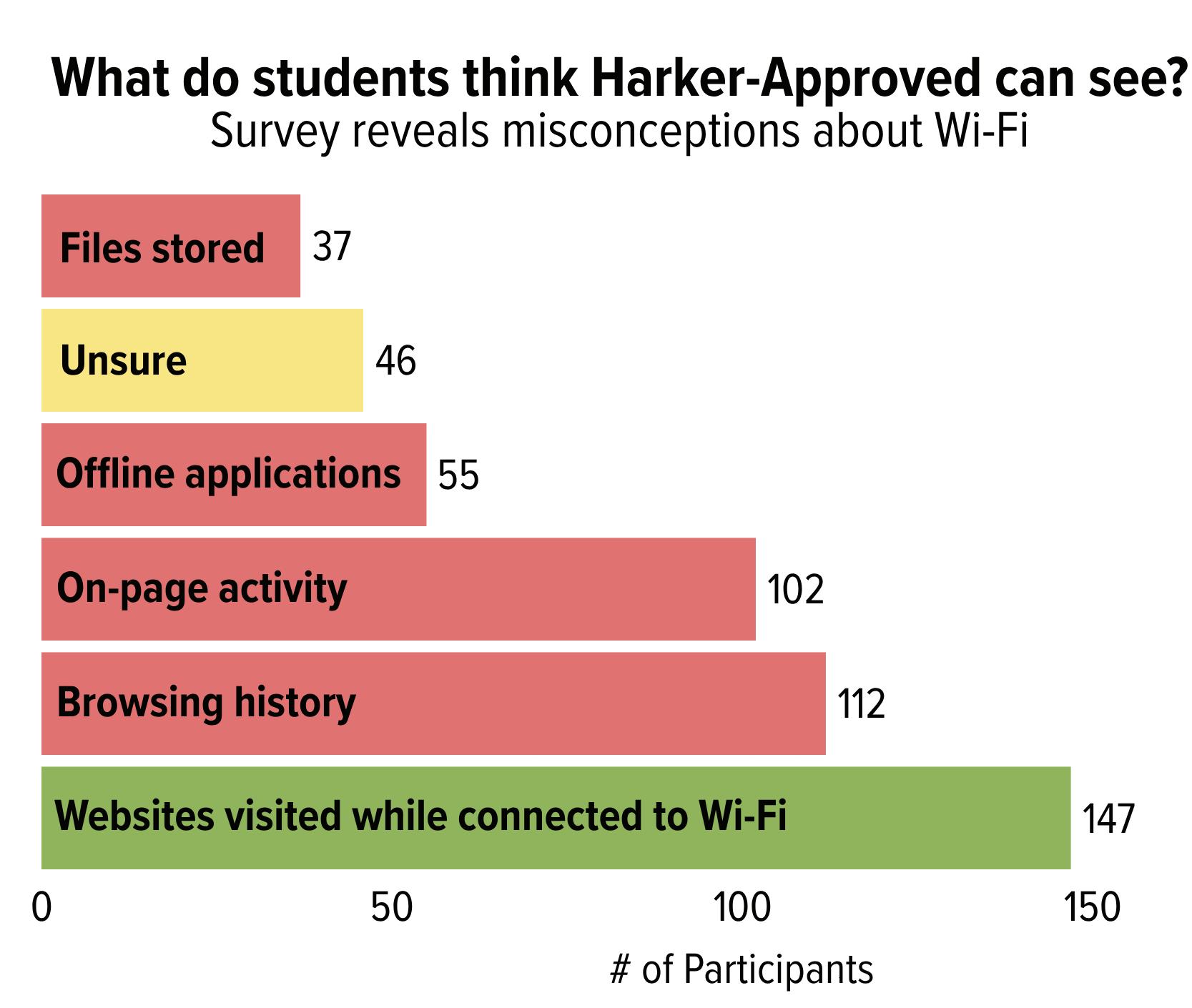
WI-FI MYTHS In a multi-select survey of 160 upper school students, 147 correctly chose that the Wi-Fi logs websites visited. However, many still believed that files, applications and browsing history could be seen, revealing confusion.
“Clanker” stems from growing fatigue with technology
loaded sentiments, resentment of AI stems from a genuine discontent with its ubiquity.
People are turning oppressed people’s suffering into something they can joke with.

JESSICA HU (12)
LINGUISTICS CLUB OFFICER
“Of course, AI is a fantastic technology and there are a lot of really good applications,”
AI Club officer Tarush Gupta (11) said. “But at the same time, there’s a lot of ‘slop’ posted on the internet. As a result, people are starting to get disillusioned with the world of AI.”
While AI began as an exciting new technology, much of the general population has grown jaded, with the increasing visibility of AI’s mistakes, low
quality outputs and overhyped corporate promises on the internet.
Although AI generally lacks the competence of a human worker, it may be capable of automating enough tasks to upset the job market in certain sectors — another source of fear and resentment towards AI. A Stanford paper indicates that AI has already caused a 13% relative decline in entry-level work, particularly customer service and software engineering. Employees at companies like Microsoft, Google and SAP face layoffs as corporations embrace automation and shift resources and new hires towards AI.
These two sentiments — that AI is incompetent, and that AI is taking jobs — are not mutually exclusive. Rather, corporations may be incentivized to replace human labor with AI to cut costs of wages, even if it produces inferior results.
“It’s not the AI, since AI is not sentient,” English teacher Susanne Salhab said. “It’s the corporations that made the AI.” Visit harkeraquila.com for more.
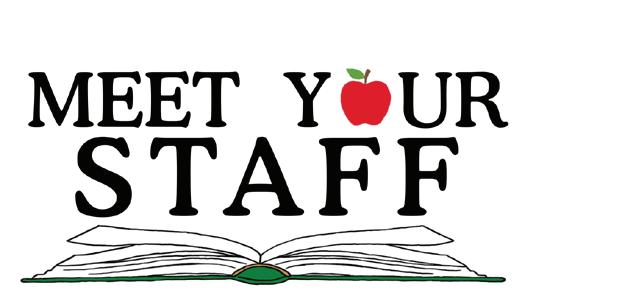
Fishing for deeper understanding Mike Pistacchi brings nature’s complexity, lessons to the classroom
In the San Ignacio Lagoon within the Baja California region of Mexico, gray whales swim up to canoes full of tourists, rubbing their heads against the boats as if to ask the people to pet them. While others are busy taking photos, biology teacher Mike Pistacchi reaches out a hand to pet the mother whale nearing his boat. The whale swims away briefly and returns with her calf, peeking through one eye as she lets him pet it. That moment left Pistacchi in awe, serving as a lesson to observe and interact with nature first-hand.
“What makes fishing great is when you do catch a fish, it’s a wonderful feeling because you understood how nature worked
MIKE PISTACCHI
”Pistacchi’s fascination with the natural environment stemmed from childhood fishing trips with his father. Over time, it began to take on a great meaning to him: To Pistacchi, each successful catch symbolizes being in tune with nature and understanding how different parts of the ecosystem interact with one another.
“I’m not the kind of fisherman that just sits there, throws bait in the water and stares at the sky all day,” Pistacchi said. “No matter where I’m at, whether it’s at the ocean or up in the mountains,
I’m paying attention to things like weather and tide and what kind of insects are out and all the things that would affect that ecosystem. What makes fishing great is when you do catch a fish, it’s a wonderful feeling because you actually understood how nature worked.”
Pistacchi’s daughter sophomore Mara Pistacchi commended his attentiveness to the natural world, a quality she noticed through canoeing and fishing trips together.
“He’s always been into nature and the outdoors,” Mara said. “We’ll go hiking sometimes and he’ll spot birds or snakes. In our backyard, he would see birds, so we built a nest and got baby birds and sparrows.”
As a child, Pistacchi felt more comfortable socializing in nature, hiking or enjoying outdoor activities with others. Decades later, he still finds the same comfort in the natural world and believes that there is always something to learn from being outside.
“I’ve learned that the natural world is unbelievably complex,” Pistacchi said. “Even 40 years of being deeply immersed in it, I still feel like I’ve got 100 years to go before I really understand what’s happening out there. It’s humbling every single time you try to achieve something in nature, whether it’s surfing and catching a wave, or fishing and catching a fish.”
On some fishing trips, Pistacchi reels in one fish after another as he watches whales and sharks swim in the ocean around him. Even after many years of fishing, he still runs into days where not a single fish bites. Nevertheless, Pistacchi treasures these experiences as lessons for future fishing expeditions.

“The hardest part is keeping in mind that even when you’re not successful, you’re learning,” Pistacchi said. “There’s the days where everything comes together, and then there’s many days where it’s not. In life, your failures are as important as anything. You’re watching, you’re learning and you’re figuring out what you did wrong every time you have a bad day.”
Having gone fishing with Pistacchi in the past, media Arts teacher Joshua Martinez admires Pistacchi’s persistence in the hobby, as well as how his empathy has positively influenced him in both his
New birdfeeders attract campus birds, inspire wildlife interaction
In the early hours of dawn before students and faculty start their day, birds gather at school, from Patil to Shah Hall to Graduate’s Grove.
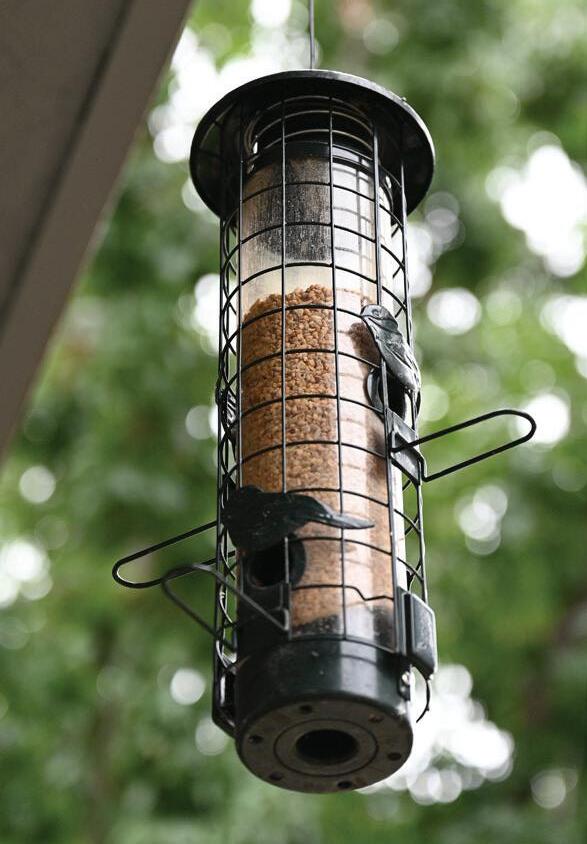
While many people overlook the nature on campus as they rush to classes, several bird lovers have embraced wildlife by installing feeders, helping animals thrive.
Director of Learning, Innovation and Design Diane Main installed four birdfeeders behind Manzanita Hall over the summer. After developing a keen interest in birdwatching, she started noticing more birds in the area where she lives and works, especially when going on walks on the weekends at Parkway Park in Santa Clara. Because of her growing passion, she installed a Bird Buddy, a smart bird feeder equipped with an attached camera that captures photos and videos of birds, enabling the owner to track and identify the species that have visited their feeder.
“I saw some of the other feeders on campus, and I wanted to set up a feeder with
a Bird Buddy, but I needed it to be in an area where it was off limits to people,” Main said. “I wanted there to be a space that we could have here on campus where you can sit quietly and observe, whether it’s the squirrels or the birds or the occasional neighborhood cats that come through.”
Several different species of birds fly around campus, including house finches, chestnut-backed chickadees and mourning doves. The camera often captures them when they visit to eat. Serving as her passion project, birdwatching has become an integral part of Main’s mindfulness and selfcare routine.
“Often when there are lots of birds in a place, that means that place is doing well environmentally,” Main said.
“If there aren’t a lot of birds, you know there probably isn’t enough nature. We’re very lucky
personal and professional life.
“Mr. Pistacchi is a person who genuinely cares about people, and that is inspiring to me to approach all circumstances with the positivity and evenness of a classic water dweller,” Martinez said. “He’s very calm, generous and sees the best in people.”
In addition to fishing, Pistacchi surfs, hikes, backpacks and gardens. No matter the hobby, he embraces the lessons of determination he learned from fishing.
“In science, you’re building those hypotheses and you’re understanding the world around you,” Pistacchi said. “When I’m
gardening, my wife and I have a hypothesis that tomatoes are gonna grow great if we do these things. For surfing, I have a hypothesis about where the waves are going to break. You get confirmation or denial of your understanding, and then you learn and you try again.”
Pistacchi extends this trialand-error approach to teaching in the classroom. To him, each class session is a learning opportunity for not only the students but also himself.
“I love teaching for the same reasons I love fishing, and it’s because humans are infinitely complex,” Pistacchi said.
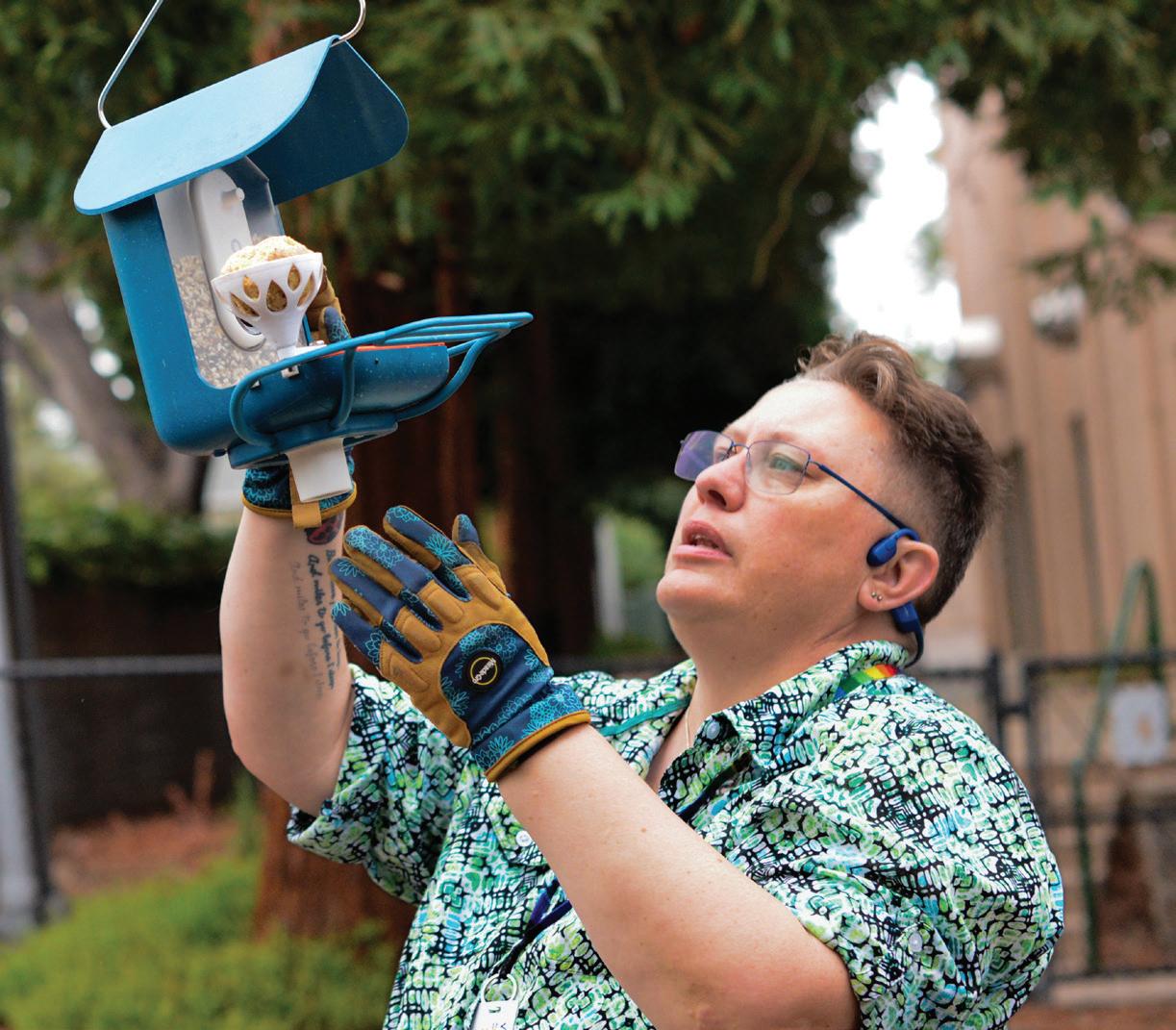
where we live. In the morning, when I go walking for exercise, I hear sometimes up to 15 different species of birds.”
Currently, Main’s feeders are filled with black oil sunflower seeds, Nyjer seeds and millet, though she tries to change up the food options every so often. The
seeds are particularly popular for birds, as the oil in the shells provides an energy source.
Despite the work required to maintain a bird feeder, many find that birdwatching provides a sense of calmness. Sophomore Chian-Shin Du had a bird feeder at her house and believed it helped her mental health.
Performers level up on stage
Performing arts groups from all campuses took the stage at the annual Harker Day performances themed “Game On” on Saturday.
Lower School technical director Danny Dunn organizes the show each year, coming up with the theme and integrating all the performing groups into a cohesive script. Beyond the choral and dance acts onstage, the Harker Day performance also serves to honor Harker’s departments and faculty.
“There is always some unsung hero of the community that deserves little moment in the limelight. I chose counseling this year because there’s a debate on video games – whether they are healthy or unhealthy,” Dunn said. “Counseling seemed the most logical option because they gave a long list of reasons Between the larger acts, the fourth-grade Picnic Players performed brief, comedic skits that connected the various performances under the gaming theme. Their opening scene depicted children teasing their mother for her old-fashioned video-game choices.

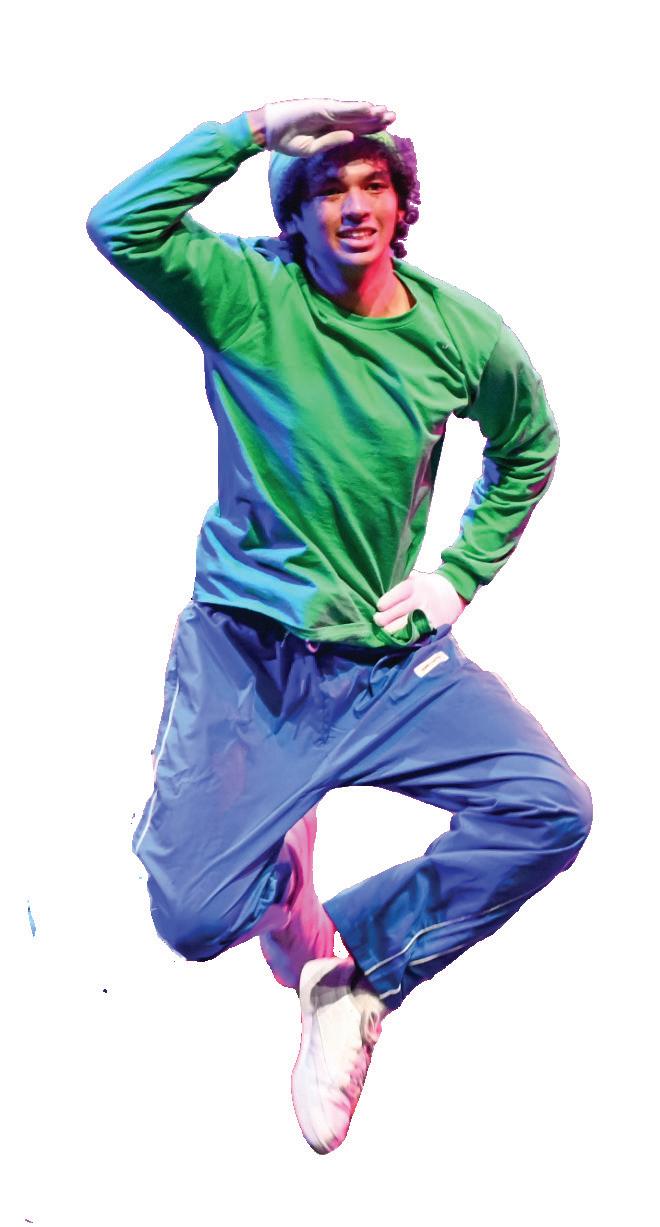
Kinetic Krew kicked off the performances with a highenergy hip-hop routine that set the tone for the entire evening. Their music choice — a bold, bass-heavy trap remix of the Super Mario Bros’ theme song — brought a mix of nostalgia and modern edge.
Director of Dance Rachelle Haun designed Kinetic Krew’s costumes and props, transforming dancers into Super Mario Bros’ characters like Mario, Luigi and Princess Peach. Audience member sophomore Janvi Trivedi appreciated how the props made the dance more dynamic, recognizing the creativity and work that went into the performance.
“One of my favorite performances from the show was definitely Kinetic Krew,” Janvi said. “The way they incorporated the props into their performance was really
“The way they incorporated the props into their performance was really amazing.

JANVI TRIVEDI (10)
AUDIENCE MEMBER
amazing, and it made the show all the more engaging and got that gaming theme across, which is something I really enjoyed about their performance.”
Frosh Festival Chorus member Lucy Wang, who sang “Baba Yetu” from the video game
Civilization IV, also mentioned the sense of community and accomplishment she received from the performance.
“My favorite part of the performance is the point when all the people in the choir sing together,” Lucy said. “There’s something very special about when it happens, when it’s all just right. It sounds really cool, and it’s just really fulfilling.”
Audience members valued the show’s combination of creativity and collaboration.
Priya Mysore, mother of senior Downbeat member Ishan Mysore, appreciated the creativity and connection the show brings each year.
“The amount of effort that goes into putting on a show like this, where everyone’s coming together, the whole school, the entire Conservatory, is amazing,” Mysore said. “Harker Day performances bring the community together. Music unites everyone, so for us, that’s why we come.”
Oregon trip brings Shakespearean plays to life
Thirty students attended the Oregon Shakespeare Festival in Ashland, Ore. from Sept. 26-28.
Attendees watched shows and prefaces, engaged in discussions and workshops and had free time to explore
Ashland, from coffee shops to bookstores to restaurants.
“We got lots of different lunches and saw the little shops,” sophomore Samantha Teach said. “It’s very local, and it was really nice to just chill with friends for a weekend.”
On Sunday morning, Oregon Shakespeare Festival
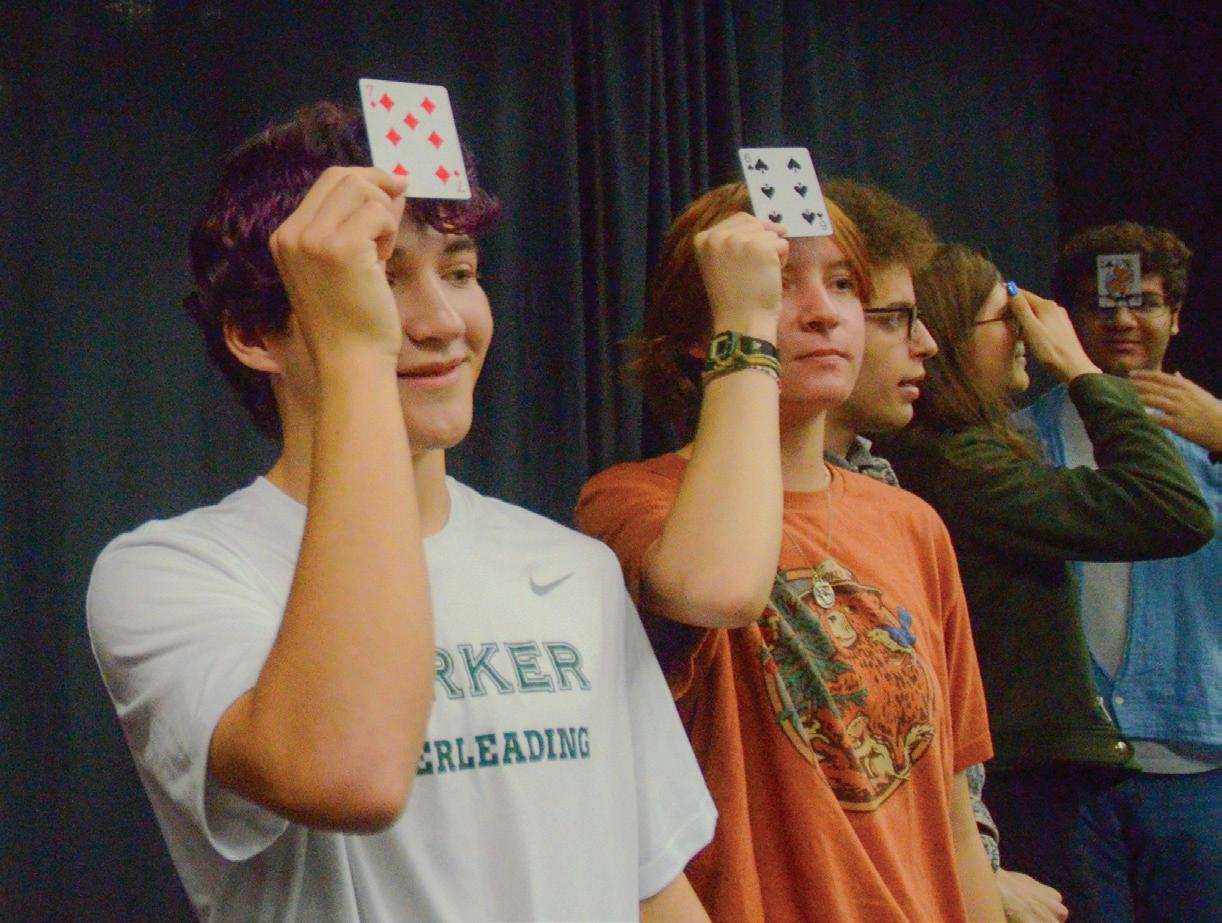
actor Tim Turner led a workshop allowing students to explore the significance of characters’ status. Turner, who attended the Festival as a high school student, strives to inspire students to engage deeper with texts through the workshops he teaches.
“I’ve done so many of these workshops, and you can always feel it in the audience when you’re performing when there’s a high school student group,” Turner said. “It’s one of the best productions when you have that energy.”


Taylor Swift album listeners share impressions
Taylor Swift released her 12th studio album, “The Life of a Showgirl,” on Oct. 3. Compared to the darker, more introspective mood of Swift’s previous album, “The Tortured Poet’s Department,” “The Life of a Showgirl” showcased more upbeat pop tunes with a litany of provocative and playful lyrics. The album also featured singer and songwriter Sabrina Carpenter on the title track. Tune in as Harker Aquila interviews four members of the community to share their takes on the newest album, from their favorite songs to initial impressions.
“
My favorite part of the album is the new vibe. It was a subdued happy album but lovey-dovey.

ALICE LUO (11)
TAYLOR SWIFT FAN
My least favorite song was “Eldest Daughter” just because I don’t really like sad songs.
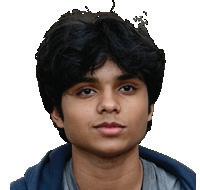
RIVAN NAIR (10)
TAYLOR SWIFT FAN
One of my favorite songs is called “Wish List.” I feel like it’s very cheeky and just very joyful.

AMBER WANG (10)
TAYLOR SWIFT FAN
COSTUME CAPTIVATION

Senior Taylor Summers, a student in the Shakespeare senior English elective and a member of the Harker Conservatory, hopes to bring the deep analysis of plays to both their English class and their work in theater.
“Seeing a play performed is completely different than reading a play; there’s all kinds of emotion and
Costumes from previous shows at the Oregon Shakespeare Festival were exhibited for students to view.
character that it conveys that just text in a book does not,” Taylor said. “The plays [we saw] all have very complex relationships in them, and seeing the plays definitely will help me going forward in understanding and acting out more complex relationships.”
To me, it’s like she was trying to combine styles, but it felt like the same old beats over again.

JENNIFER SANDUSKY
TAYLOR SWIFT FAN
Family, food with full moon
The Mid-Autumn Festival celebrates the first harvest by the light of the moon. Although the festival originated in China, many East Asian cultures follow similar traditions on Oct. 6, the 15th day of the eighth month on the lunisolar calendar.
Chinese National Honor Society President Grace Fu (11) described her experience with moon-gazing, a tradition during Zhong Qiu Jie.
“In Chinese culture, the moon is really important,” Grace said. “Sometimes when I’ve been having bad luck for a while, my mom will take me outside and we’ll look at the moon together and say a little prayer.”
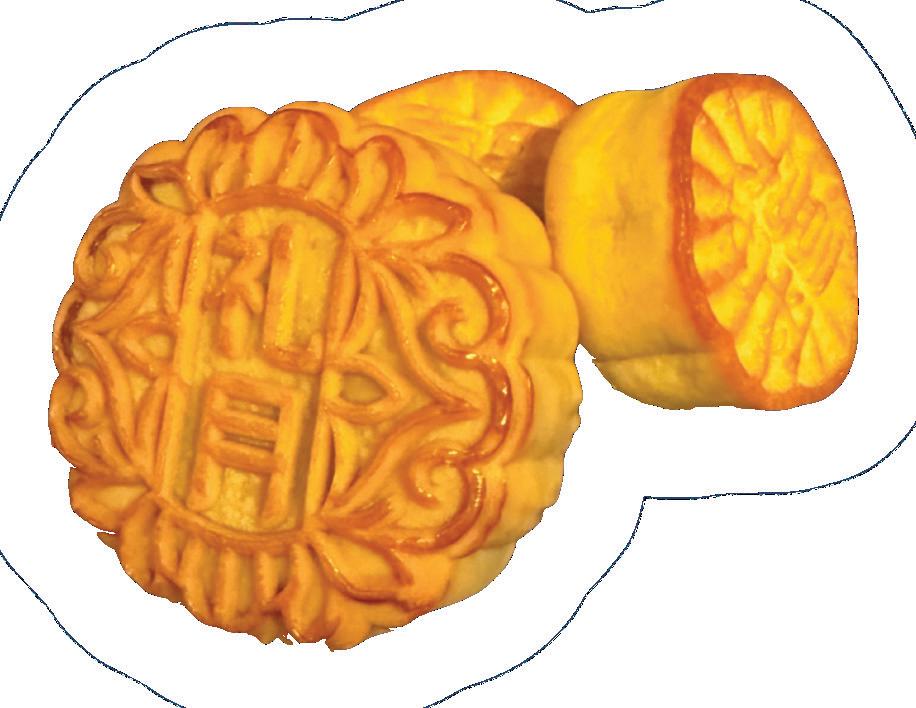
MOONCAKES These intricately designed pastries symbolize family reunion and harmony.
During Chuseok, Koreans perform ancestral rites and visit relatives’s graves. KoreanAmerican Student Association President Amber Wee (10) shared that traditions extend beyond simple expressions of gratitude.
“Most people assume that Chuseok is like Thanksgiving, but it’s also a time when distant relatives come, and we can honor our ancestors too,” Amber said. “You can spiritually eat with your old family members and grandparents.”
Food lies at the heart of these celebrations, uniting families and honoring tradition. China’s mooncakes filled with lotus or red bean paste, Japan’s dango, or rice dumplings, and Korea’s songpyeon, small rice cakes with sweet nutty fillings, all embody togetherness.
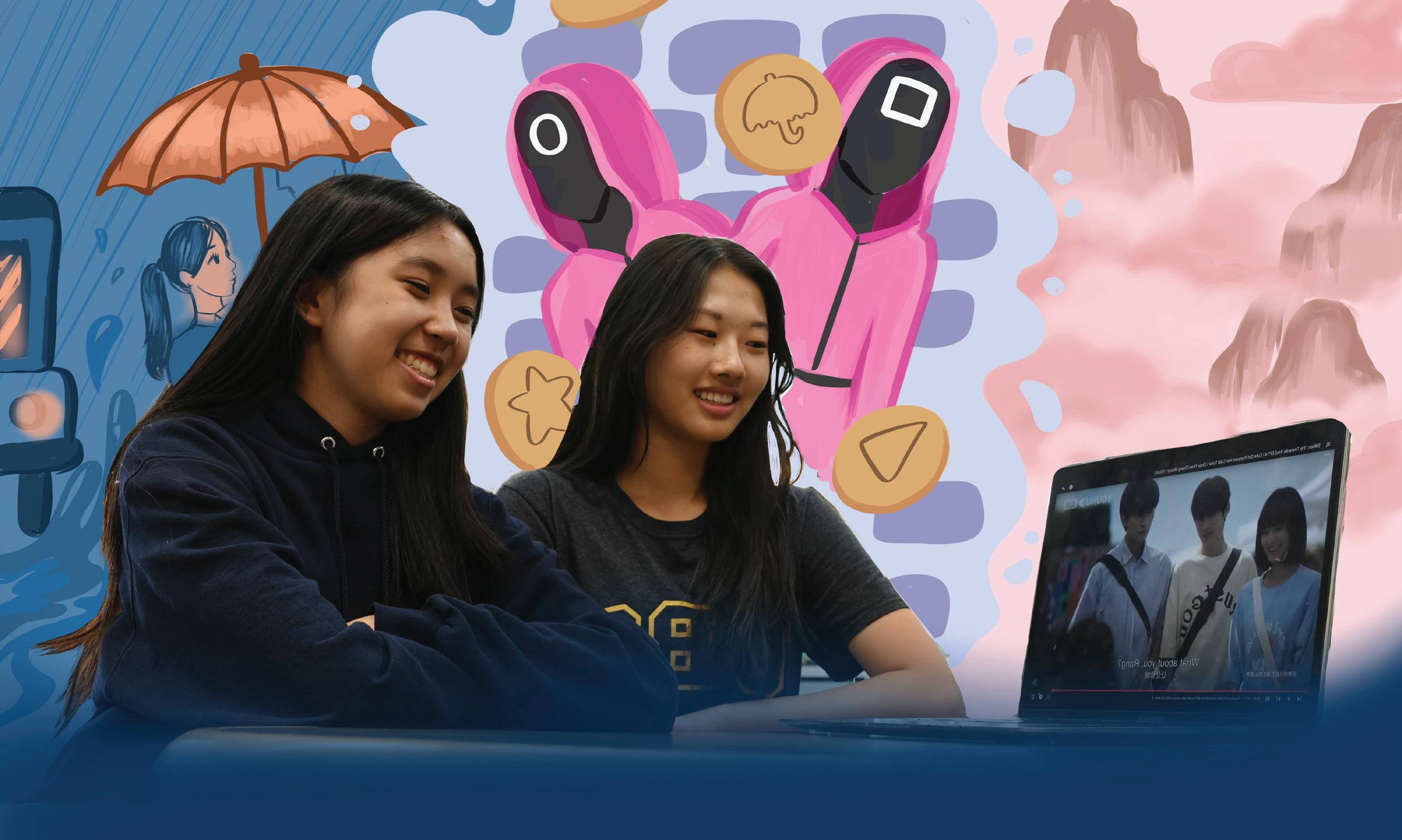
Chinese, Korean shows gain global popularity
After a long day laboring over homework, junior Isabelle Niu stretches, ready for a break. She instantly drifts towards the Chinese drama “When I Fly Towards You.” In scenic shot after shot, a world of school uniforms and million-dollar smiles unfolds around her as she follows the characters navigating their tumultuous journeys.
Following the release of international hits “Squid Game” and “Parasite” in the past six years, the entertainment industry has seen a rise of C-dramas and K-dramas in the West as a part of the Korean Wave of K-pop and K-dramas. Isabelle attributes this popularity to the fan culture and focus on aesthetics.
“In C-dramas and K-dramas, there’s a higher emphasis on visuals,” Isabelle said. “In addition, there’s a huge emphasis on actors’ chemistry, since a lot of the audiences for K-dramas and C-dramas are fans of the actors.”
Production quality is another major element of Korean and Chinese dramas. By 2015, the average production cost per episode was 400 million won (around $300,000), and in 2018, “Mr. Sunshine” reached a record high of 1.67 billion won (around $1 million) per episode.
“High-quality production, exceptional acting and cultural heritage are key factors in their popularity.

XIUYU GAO MANDARIN TEACHER
Mandarin teacher Xiuyu Gao added that these shows offer a unique experience that appeals to those who want to educate themselves on Chinese culture.
“The popularity of Chinese-language dramas stems

matter,” Gao said. “High-quality production, exceptional acting and, in certain genres, cultural heritage of these shows are key factors in their popularity.”
Frosh Haniel Baek appreciates how Korean dramas take the time to flesh out characters and build connections between them.
“Korean shows are much more slowed down in pacing, so there’s a lot of suspense and episodes,” Haniel said. “As a Korean, I’m proud that these shows are popular because there is now Korean culture internationally. I feel more seen and proud of my culture.”
believes that this diffusion of Chinese and Korean culture helps dispose of preconceived biases, allowing people to view East Asia in a more positive light. Now, even while being an ocean apart from the source material, she can reconnect with her culture and share it with others.
“People are becoming welcoming towards Korean, Chinese and Asian things,” Isabelle said. “With the emergence of C-dramas or K-dramas, the western world is more willing to immerse themselves in Asian cultures by trying the food and traditions.”
Good and sweet: Jewish community welcomes new year
krupnik
Rosh Hashanah and Yom Kippur mark the beginning of the Jewish year in the month of Tishrei, which typically falls in September or October.
“The High Holidays are a time to reflect and refresh yourself for what’s to come.

ALISON WESTGATE SOPHOMORE
Jewish communities celebrate Rosh Hashanah and Yom Kippur, known as the “High Holidays” for their deep spiritual significance, from sunset to nightfall, this year from Sept. 22-24 and Oct.1-2, respectively.
The High Holidays provide an opportunity for reflection and repentance, as well as celebration and connection, wishing for a shanah tova u’metukah, Hebrew for “a good and sweet year.”
Rosh Hashanah marks the beginning of the Jewish year and lasts two days. It is traditionally marked by blowing the shofar, an instrument that is made from a ram’s horn, and eating foods which represent sweetness and prosperity.
Yom Kippur is traditionally observed through attending services, fasting and abstaining from luxuries such as bathing and wearing leather or perfume.
For sophomore Alison Westgate, an integral part of the High Holidays is spending time with the community at her synagogue.
“The High Holidays are a time to reflect and refresh yourself for what’s to come,” Alison said. “Yom Kippur is more about
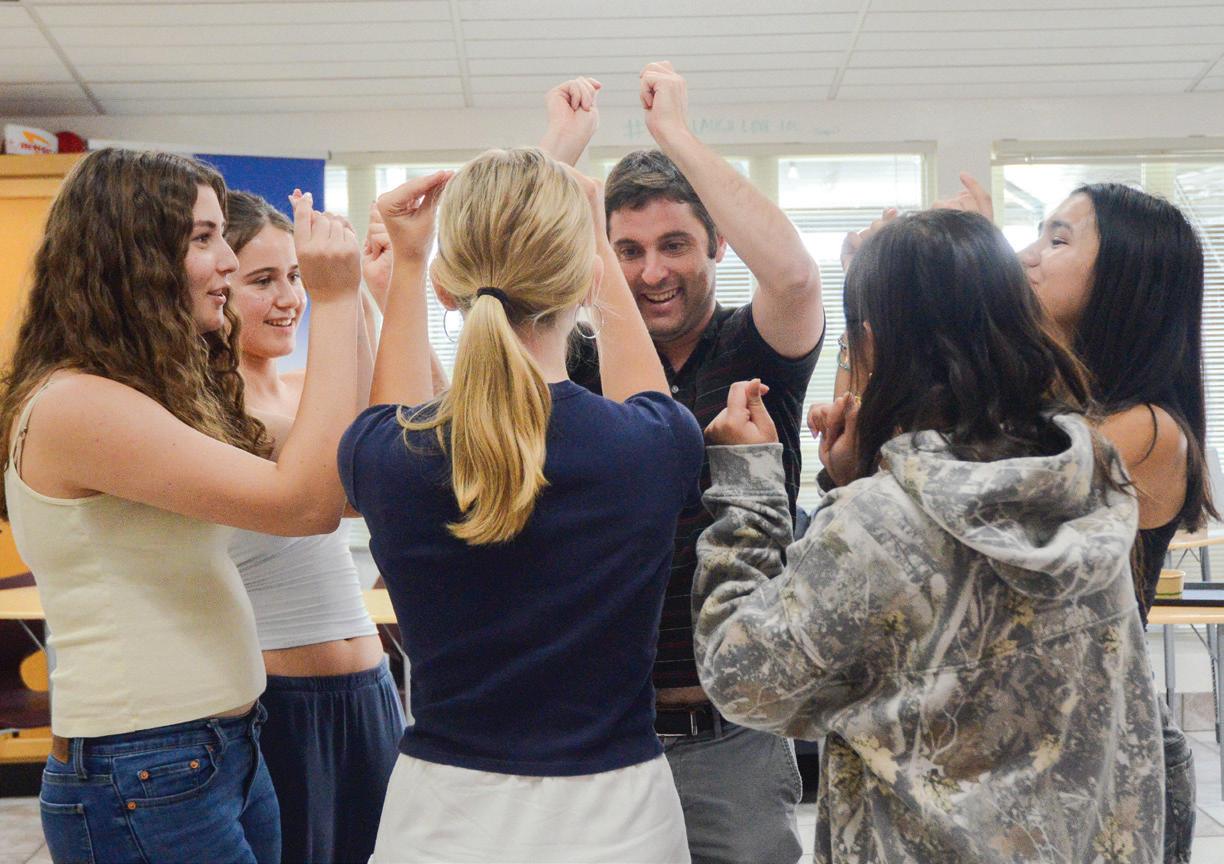
reflection. It’s more of a serious holiday, but Rosh Hashanah is about wishing for sweetness. It’s traditional to use a lot of honey in your cooking, so you can make honey bread, apples and honey or round challah.”
Ten days of repentance occur between the start of Rosh
Hashanah and the end of Yom Kippur. During this time, Jews apologize to those they have wronged and seek forgiveness heading into the New Year in a practice known as teshuvah.
“When I was younger, my best friend and I would always go to the park on Yom
Kippur and do teshuvah,” economics teacher Samuel Lepler said. “It’s a wonderful tradition to clear the air of all sorts of resentments and admit what you’ve done and forgive other people.”
Jewish Affinity Group officer Abby Rose Sachse (11) shared how her experience celebrating the High Holidays at her Jewish elementary school differs from how she celebrates them now. Despite this, she still finds meaning in the High Holidays and wishes more non-Jewish people understood their significance.
“A lot of people know more about Hanukkah, but Hanukkah is not one of our super religious holidays, whereas the High Holidays like Yom Kippur are some of the most serious days in the year,” Abby Rose said. “I wish there was a little bit more understanding about which [holidays] are more important.”
Free speech fails First Amendment promise

When a political activist is assassinated and a president openly threatens journalists with lawsuits and censorship, I have to ask: Is free speech still free?
I believe these are not isolated incidents, but rather symptoms of a deeper problem: Citizens of America increasingly criticize speech because it is unpopular, inconvenient or offensive.
The First Amendment declares that Congress cannot make laws abridging freedom of speech or press, promising protection for satire, protest, dissent and debate: the foundations of democracy. Yet in practice, that promise is slowly dying as recent events display how fragile expression is,
with a key pattern emerging:
The right to speak does exist in theory, but its practice is shrinking by the day. The result is a widening gap between the freedom guaranteed on paper and the reality actually experienced by citizens.
While speaking at Utah Valley University, Charlie Kirk was shot and killed by 22-year old student Tyler Robinson on Sept. 10, with the motive of ending his conservative views against gay and transgender rights. Kirk’s assassination represents not just a tragedy but a direct attack on the premise of public discourse itself. Although his conservative rhetoric was highly inflammatory to many, that did not justify murder.
Kirk built his brand on face-to-face debates with

opponents. However, in a democracy, you argue with people you dislike — you don’t kill them. His death was a warning to everyone who speaks their mind. It tells us that words
“If free speech in America is abridged by acts of violence, it is hanging by a thread.
”
can now be met with bullets, not just government intervention. If free speech in America is abridged by acts of violence, it is hanging by a thread.
Days later, Jimmy Kimmel’s late night show was abruptly
pulled from air after he joked about the Republican Party’s response to Kirk’s assassination. Federal officials had already publicly suggested consequences for Kimmel’s words, and networks quickly caved. Although Kimmel was eventually reinstated on Sept. 18, he should have never been taken off the air for his statements in the first place.
Satire is supposed to be untouchable: The whole point is to make the powerful uncomfortable, to spark change or to simply amuse the public. If comedy can be censored so easily, how can we differentiate genuine criticism from manufactured authenticity?
Once satire is treated as a
liability, every joke and monologue risks being filtered not for truth but for political acceptability. And as an audience member, I can’t help but wonder if I am hearing real critique, or only the version that passed a quiet test of loyalty. If a comedian who built up his brand and audience for over 20 years can be taken down for a joke, what message does that send to the rest of us? To me, it says: Stop talking, play it safe and never question authority. That’s not free speech, that’s fear speech.
These actions do not defend our Constitution. Instead, they twist the term of “free speech” into something that is completely unrecognizable. Visit harkeraquila.com for more.
Find courage to stir controversy, invite nuance
As I’m sitting at my lunch table, someone makes a comment that I don’t quite agree with, and I hesitate. Should I say something? Should I offer my perspective or respectfully question the person? By the time I’m done analyzing the potential ramifications, the conversation has moved on, and I stay quiet.
As I consider, with a drop of regret, my decision to bite my tongue and keep my opinions to myself, I reflect on the culture decisions like mine breed.
“Are other people also hesitant to voice their perspectives?”
I wonder, “And what would happen if respectful, nuanced debates were more normalized?”
While discussions and debates form an integral part of classes like history and English, I’ve noticed they are starkly lacking within the broader school ecosystem. As members of the community, we can all choose to bring the values of respect, curiosity, passion and
conviction from the classroom into our daily lives.
The few times I have experienced this, those interactions have been all the more meaningful. One time last year, while we were waiting for class meeting to start, a member of my advisory turned to me and said, “I was scrolling on Instagram and saw a reel you liked, and I was just wondering: Are you pro-choice or pro-life?” I froze. Was I really about to get into an abortion debate sitting in the middle of Patil Theater?
Should I try to avoid the question or brush it off?
After a second of consideration, I decided to be upfront about my opinion. She respected my opinion and asked some follow-up questions. Many, however, do not reciprocate that openness or desire for understanding.
I’ve experienced classmates avoiding me or refusing to talk to me due to disagreements between us. I’ve received angry, provocative direct messages

SPEAK UP The act of avoiding disagreement often creates surface-level conversations between students, leaving empathy unheard. When the fear of offense outweighs curiosity, meaningful conversation ceases.
on Instagram in response to stories sharing my thoughts or my reposting of controversial topics. I’ve found out about people talking badly behind my back, misrepresenting my views
or ascribing views I do not hold to me. While all those are frustrating and hurtful, the true problem lies deeper: People’s refusal to engage with
anyone who disagrees with them exacerbates ever-present echo chambers. By avoiding, attacking or ridiculing those who disagree with them, people close themselves off.




Camera sees first Living moments just for likes
“Everyone put your hands in the air!” In a packed, laser-lit concert venue, hundreds of hands reach up toward the ceiling. Instead of carefree palms waving to the rhythm of the music, nearly every hand clutches a phone or camera, straining to record the performance. Concertgoers’ eyes fix to their phone screen, desperately trying to capture the best angle to post on social media.
Nowadays, whether it’s at a concert, shopping center or restaurant, phones and cameras are everywhere. Rather than focusing on the present and experiencing each event live, people often record and take pictures with the intention of watching them back at a later date.
“Filming detracts from happiness,” junior Laya Sunkara said. “You’re not focusing on this thing that you’ve been so excited about, and you’re not focusing on those emotions and absorbing them while they’re lasting. You’re trying to preserve them for later without realizing that you’re not enjoying them in the moment.”

memories for later access, English teacher Pauline Paskali cautioned against constant recording.
“If all we do is focus on experiencing the world through a lens, it’s a loss of our connection to the world, to people, to being able to look someone in the eye and talk to them to see their nuanced expressions,” Dr. Paskali said. “If you’re looking through a lens or an iPhone, you’re focused on the composition — the lens doesn’t see what you see. What you see in person is part of what makes us human beings.”
“Taking photos adds more depth to the interaction you’re having, because it’s
meaningful enough that it’s worth remembering.

enjoys incorporating those outside of his friend circle.
“Taking photos definitely doesn’t detract from the focus of the conversation,” Lucas said. “If anything, it adds more depth to the interaction you’re having, because it’s meaningful to the point where you think that it’s worth taking a photo and remembering. You’re having more people interact with each other, and that moment of ‘smile’ just spreads joy.”
For Dr. Paskali, wanting to photograph and record experiences is inevitable in today’s digital world, and she believes that there’s nothing wrong with wanting to share that with others on social media platforms.
She offers a compromise: taking a few pictures or videos to look back on at a later date, but then putting the phone away to fully engage with the people and that experience.
authenticity
When at an event with other people, prioritizing filming over face-to-face interaction may also weaken social connections.
Although filming seems like a harmless way to document

LUCAS CHEN SENIOR ”
While some feel recording dilutes experiences, senior Lucas Chen sees the process of capturing his life through film as an enhancement. He started a social media account at the start of senior year with the goal of documenting connections and memories with all the members of his class. He
“If you’re trying to experience a moment and if you’re fortunate enough to be in a beautiful place or listening to beautiful music or at an art exhibit or at a dinner with your friends, your presence is probably more valuable than anything else,” Dr. Paskali said. “If you’re worried you’re going to forget, then take a quick snapshot and then just put the phone away. You would have a more meaningful experience if you’re present to the people and the experience around you in the moment.”


Manufactured Camera eats Social media undermines
suhani gupta, chelsea xie & cynthia xie
“The camera always eats first.” Junior Laya Sunkara jokes as she arranges food carefully at a restaurant to take pictures for her Instagram account with her food reviews.
She snaps photos at every angle, checking her camera roll to ensure her shots are aesthetic, before finally digging into the delicious meal.
Food photography rose in popularity on social media in the 2010s and since then has trickled down to non-influencers — instead of tasting the dish as soon as it’s served, people first try to capture the perfect shot to post on their page.
Today, the phrase takes on a broader meaning: the act of documenting and creating an online persona.
Social media, which began originally with the intention of being a tool for connection and personal expression, has morphed into a stage for performance.
Sophomore Ava Ding pointed out that social media posts have become increasingly curated, each photo painstakingly picked to impress or build up their standing on the internet.
“At its core, social media is mainly to keep in touch with your close friends and just have an online diary for you to post about your life,” Ava said. “But
now, there’s aspect to it. lot of people life seems and impressionable us see that to also show perfect lives When media, Laya’s influencers wealthy socialite often showcase Creators an aspect relatability curating their near-perfect
“Subconsciously, wants to even if it’s Laya said. be damaging putting so into these ultimate goal If people damaging to and to your Laya media creates where people gratification, do not feel likes or views continue content is than before, changes their the search
“People for anything Laya said.
authenticity

: What’s real?
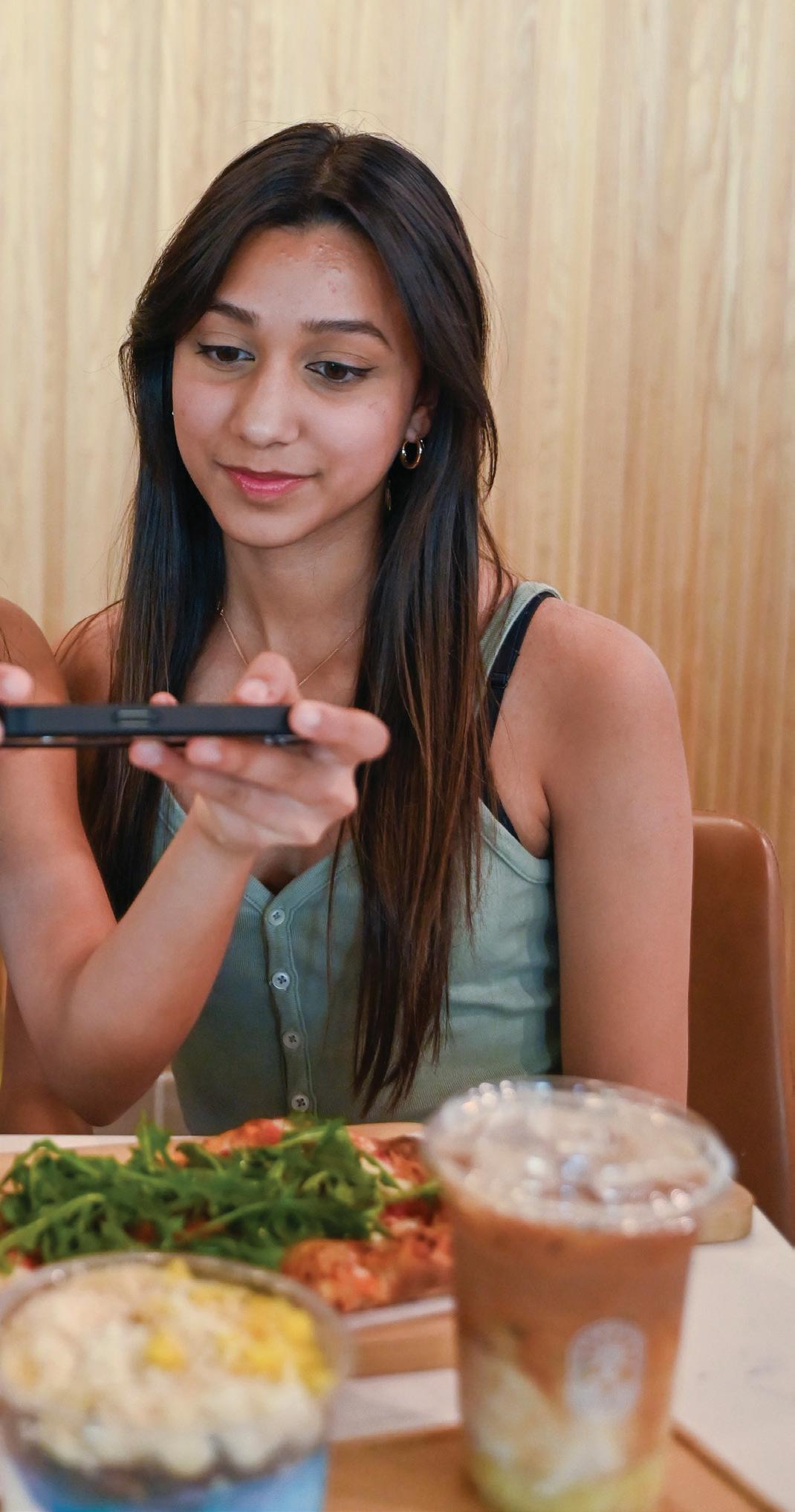





eats first undermines genuine sharing
there’s an entertainment it. Influencers, who a people look up to, their very perfect. Young impressionable people like that and feel the need show off our seemingly lives to everyone.” scrolling on social Laya’s feed overflows with influencers like Becca Bloom, a socialite whose videos showcase her wealth. like her maintain of accessibility and while carefully their content to show a near-perfect life.
“Subconsciously, everybody be like celebrities, on a smaller scale,”
“That can sometimes damaging because you’re much time and effort these things with the goal of people noticing. don’t notice, it’s to your mental health your self-esteem.” adds that social creates a harmful loop people constantly seek gratification, and when they feel satisfied with the views they receive, they posting more. This often less genuine before, as the poster their online presence in for appreciation.
“People want appreciation anything that they’re doing,” “There’s that sense

of jealousy of seeing other people doing things or being aesthetic and getting attention. That cycle has been repeated so many times that people feel the need to share this information now with others so that they can get noticed.”
There’s a sense of jealousy of seeing other people doing things or being aesthetic and getting attention.

LAYA SUNKARA JUNIOR
This phenomenon only heightened with Gen Z’s growing consciousness of how they portray themselves on social media in the digital age. As a result, every post becomes more deliberate, with many users overthinking how a single picture or comment might impact their reputation.
“I’ve seen social media go from there being no filter between what you thought and what you put on the internet because there were no consequences,” Business and economics teacher Patrick Kelly said. “Now it seems like Gen Z knows that your digital
footprint is going to stay with you forever.”
Social media influencers have transformed the purpose of social media from sharing life experiences to selecting meticulous posts backed by complex marketing strategies.
Kelly, who runs a YouTube channel with over 100,000 subscribers, points out the profitability of appearing candid on social media.
“Authenticity plays well on the internet,” Kelly said. “It’s a low-friction way to translate your real self onto the internet. It’s almost like your digital product, except your product is just yourself. The more cohesive you are with the things that you present to the world, the more your audience knows what to expect from you.”
While some social media users continue to curate the perfect posts, others take a more authentic approach. By challenging the norm, people can share their lives without pressure, seeing their social media in a more healthy light.
“It should be a social connection you have where you’re sharing your life with the people around you,” Ava said. “You don’t necessarily need to show off or try to be super cool or aesthetic. Your friends and people who are close to you don’t see you that way, so I don’t see a reason for you to paint that picture of yourself in that way online.”


Instagram expands profile customization features
Over the past several years, Instagram has gradually rolled out updates that offers users increasing control over their profile presentation.
The features are designed to give users more agency over how their content appears and how their profiles are organized. From the ability to archive posts without deleting to tools that allow

grid rearrangement, these updates reflect a broader trend in social media of moving toward a more curated personal branding on the internet.
The following timeline tracks key updates that have expanded profile customization options, illustrating how the platform has responded to users’ growing desire to control their presentation on the social media platform.
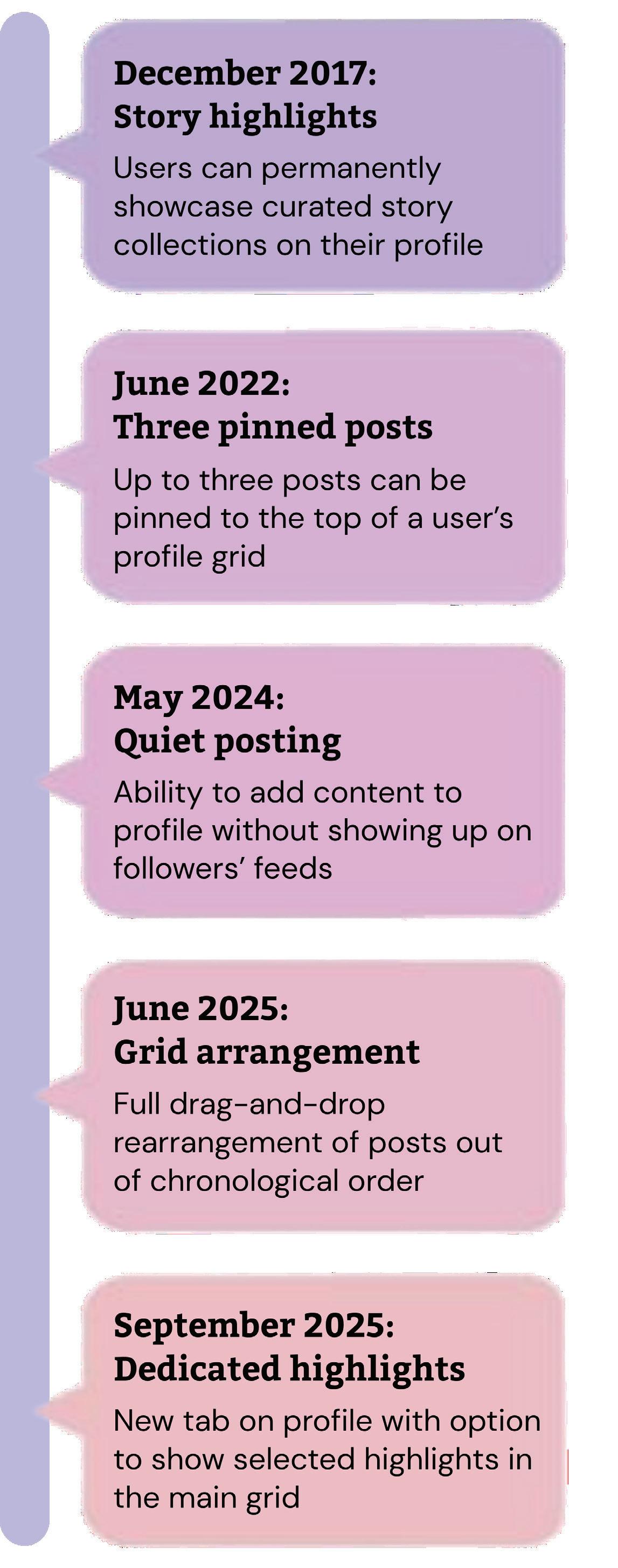
Let us grade listening, not just participation
It’s 20 minutes into the class period. Five-minute break in sight, but not quite. You’re trying to understand a fifth classmate’s impromptu monologue on Nathaniel Hawthorne’s “The Scarlet Letter” — and finally, it clicks. Your hand goes up, noticed by the teacher but not before she calls on another classmate.
“Sorry if this is unrelated, but…” your classmate launches into a tangent about a passage 20 pages back. It’s a great point, but by the time they’ve finished, you’ve lost your train of thought. Your hand sinks back down as you return to quietly pondering.
And the irony? To a busy teacher who must regulate the conversation, add their own insight and survey the classroom, the interjecting student may well earn a higher participation mark than their peers perceived as reticent. After all, with so much to keep track of, much of a participation grade ultimately comes down to how much a student was perceived to “contribute.”
With no fault to the teachers themselves, our current classroom culture often rewards the loudest voices over the most thoughtful ones. It’s time we redefine what “good” participation looks like — valuing collaborative, constructive contributions over the mere presence of comments.
But first, to begin on a note of empathy — the act of participating does indeed bring satisfaction, potentially
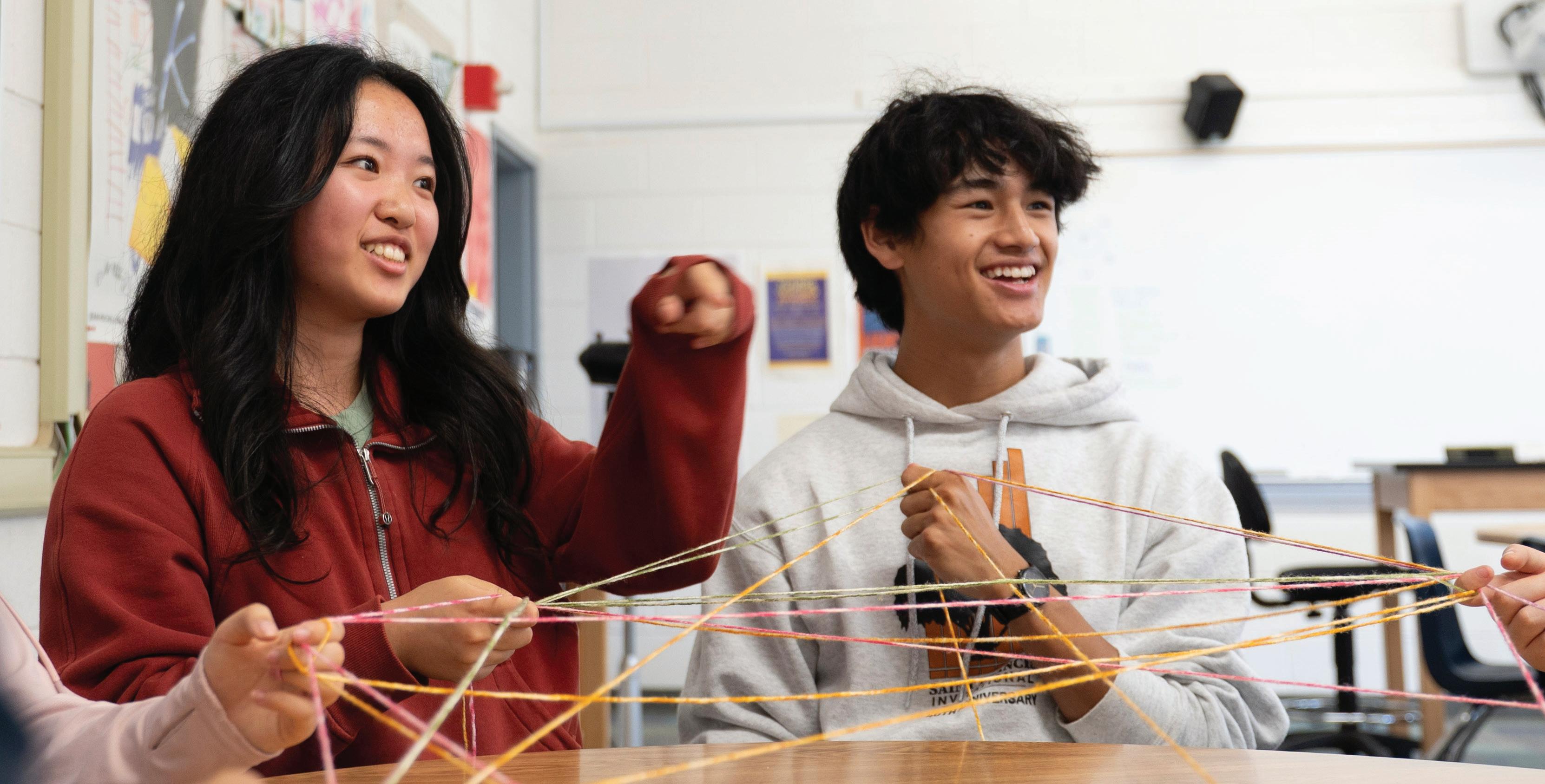
explained by a psychological principle called the Zeigarnik effect. In essence, anything uncompleted in our minds creates dissonance which is only resolved by speaking up, explaining the feeling of closure upon contributing to a discussion with your own points.
Yet regardless of the motives for participation, students must respect the classroom discussion as a collaborative effort. If students pursue the selfish expression of their own ideas without interacting with those of their peers, true discussion becomes moot.
A solution I first encountered in my sophomore
This I Believe: Lessening pressure with playgrounds
Ring! Ring! Ring! The bell signals the end of yet another long and exhausting school day. Finally, I’m freed from class, but instead of relaxing or socializing with my friends, I immediately start stressing about my huge workload. As I repeat my mindless routine of walking sluggishly to the library, I think back to my after-school experiences in lower school, when the highlight of my day was relaxing and spending time on the playground with my friends.
“
I never would have thought that being at a playground would have such a positive impact on my mental health.
”
I’ve always wondered why playgrounds are not built on school campuses after lower school. When I was in second grade, I attended a summer camp at Saratoga High School. Since high schools were so huge, I thought that the playground there would be even better than
the ones we had at the elementary school. But when I excitedly ran outside during break, expecting a grand play structure, I was instead met with barren trees, metal benches and a lot of concrete. I was immediately filled with shock and disappointment.
At the time, my only concern was not having a designated space to freely connect and socialize with others. However, I now realize that the disappearance of playgrounds represents an unspoken ideology that society forces upon students: Play only belongs to childhood, and high school is meant for actual work and responsibilities.
This idea is especially prevalent at Harker. Because of the high standards and huge emphasis on academic success, I often fall victim to this false belief. I cram my free time with studying and homework to the point where even my weekends are filled to the brim with unfinished assignments.
On one of those particularly exhausting weekends, I was walking at night with my friends to one of their homes when we spontaneously decided to go to a park. As soon as we arrived, I saw the huge swings, slides and monkey bars, and all the stressful thoughts that had previously
year was the Harkness method. Strictly adhered to at the Phillips Exeter Academy in New Hampshire, the Harkness
“
Our current classroom culture often rewards the loudest voices.
”
method emphasizes genuine conversation. Students experience greater freedom in the discussion, as they no longer have to raise their hand and may chime in whenever they

PERFECT PLAYTIME Though work piles up in school, taking time for ourselves is important.
flooded my mind immediately disappeared. In the dark, my friends and I screamed, laughed and chased each other, that childhood joy melting away my worries about school and extracurriculars. The moment felt surreal. I never would have thought that being at a playground, carefree, would have such a positive impact on my mental health.
Though work continues to pile up, taking time for ourselves should remain as important as it was in our childhood lives.
see fit. However, this increased freedom is complemented by a system of conversation diagramming, where each student is represented as a “node” and lines are drawn to signify peer-to-peer interaction
Harkness organizes thoughts in real time, as threads of conversation physically materialize on the page. Should a student speak for the sake of speaking — that is, break off a thread to interject an unrelated comment — Harkness helps the discussion recover. Students can retrace the threads to jog their memory of past, unfinished points made, while teachers can more clearly distinguish


As I walk into Lion Market, my mind is locked on one target. Hurrying into the candy aisle, I immediately spot the brightly colored packaging of Popin’ Cookin’. Since last year, my friends and I bought one of these Japanese gummy powder food kits every Friday, and we would spend the next lunch period taste-testing, laughing at the ridiculous snacks we made.
5. Tanoshii Sushi Tanoshii means fun in Japanese, and this kit lived up to its name. The roe in the sushi box looked like popping boba, a texture uncommon among Popin’ Cookin’ food items. However, the sushi kit did not provide enough rice powder to keep the sushi upright, giving it the fifth spot in my ranking.
4. Tanoshii Hamburger Popin’ Cookin’s Hamburger
wayward comments from the rest of the conversation.
But sometimes, discussions simply reach natural pauses. This is where more vocal students might raise their hand quickly and begin new threads of conversation. However, should students allow the silence to sit, more reserved students might feel more encouraged to start threads of conversation.
Thus, “bad” participation can be summarized as the interjection of tangential ideas into an unfinished conversation, as well as the over-eager onset of new conversation threads, leaving a clear action plan for both teachers and students.
set captures the nostalgic feeling of a McDonald’s Happy Meal. Sandwiched between the orange-flavored gummy bread was a patty of chocolate pudding. The pineapple-flavored fries were crunchy and chewy at the same time.
3. Tanoshii Donuts
The donut kit was the first to give us decent results, so it already has a place in my heart. The process surprised us with how smooth it was. As we piped chocolate drizzle, smeared vanilla frosting and placed our sprinkles, the gummies resembled miniature donuts from a cozy bakery.
2. Tanoshii Ramen
The ramen kit includes dumplings, spring rolls, mango pudding and ramen, like a true meal at a restaurant. The dumplings, spring roll and soup resembled the actual food. Even though the mango pudding just looked like a lump, I’m giving it a pass because I enjoyed making this kit the most.
1. Tanoshii Waffles
Waffles is the ideal Popin’ Cookin’ set. Aside from the aesthetic results closely matching the packaging, the waffle molds defined every ridge on the waffle. I’d recommend Tanoshii Waffles as a start for its delightful visuals and beginnerfriendly equipment.

Editors-in-Chief
Ashley Mo Tiffany Zhu
Managing
Jonathan Szeto Emma Li
News
Opinions
Elizabeth Zhang Risa Chokhawala
Features
A&E/Lifestyle Editors
Cynthia Xie Chelsea Xie
Claire Tian STEM Editors Caden Ruan
Sports Editors
Wenjie Zou Lily Peng
Copy Editor William Jiang
Multimedia
Adviser Whitney Huang, CJE
Aquila
Lily Shi
Eva Cheng
Aquila
Managing Editors
Suhani Gupta
Janam Chahal
Mihir Kotbagi
Charlie Wang Kairui Sun
Editors-in-Chief
Humans of Harker
Ella Guo
Disha Gupta
Humans
Mendy Mao Vivek Moorjani
Heather
Reporters
Emma Lee
Aahana Sharma
Dyuthi Vallamsetty
Kanav Gupta
Shreyas Karnam
Sarah Wang
Charlene Li
Grace Wu
Saria Lum
Ashley Zhou
The Winged Post is the official student newspaper of Harker’s upper school and is distributed free of cost to students every four to six weeks except vacations by the Journalism: Newspaper and Advanced Journalism: Newspaper courses at The Harker School, 500 Saratoga Ave., San Jose, California 95129.
Editorial: Intentional scheduling aids students
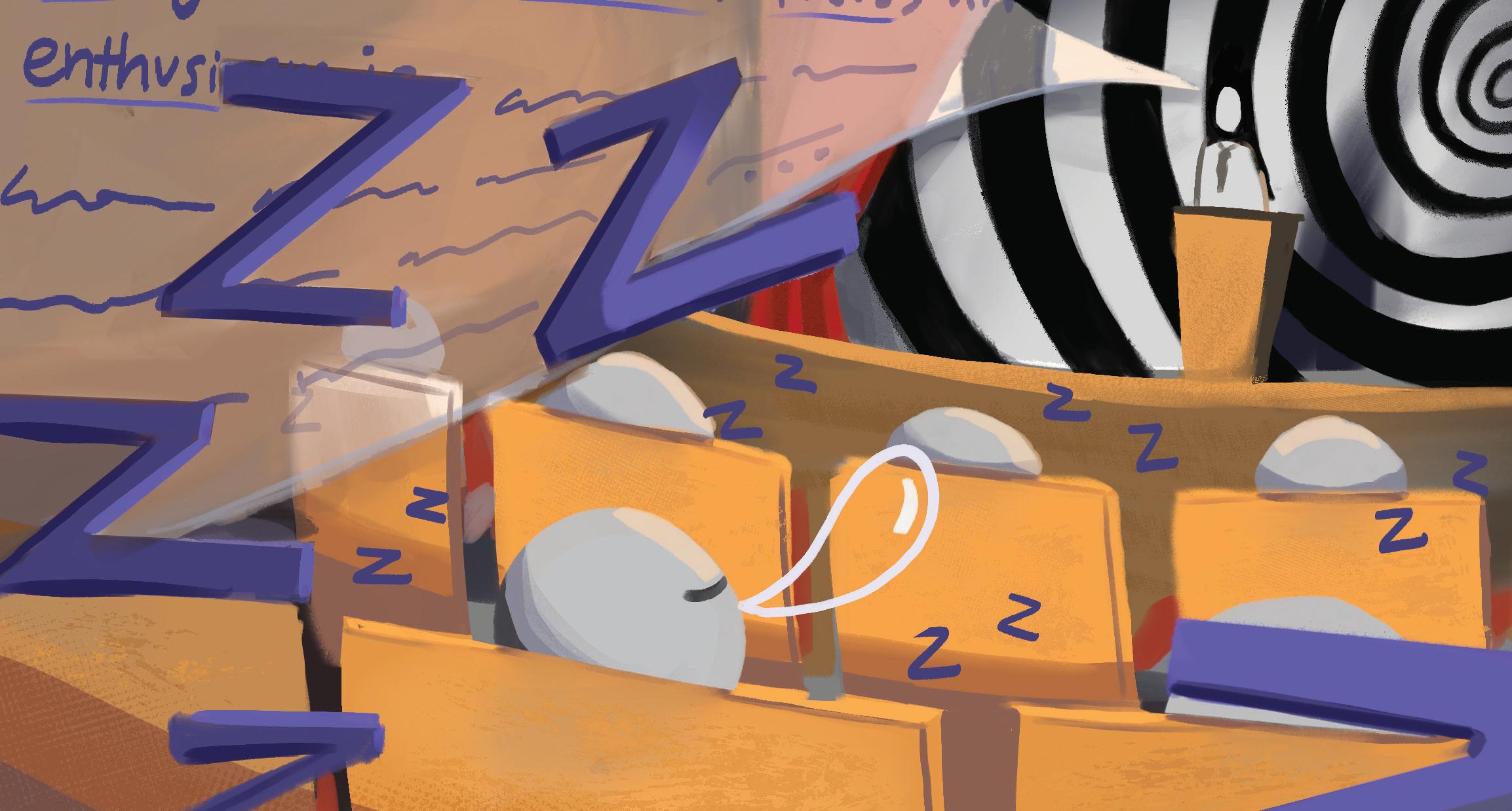
During the average week, we spend around an hour and a half sitting in mandatory assemblies, often at the expense of office hours and the short chunks of free time we have during the week. The limited time in each school day is a precious commodity, and assemblies and meetings too often disregard it. Although these gatherings serve important purposes and address our community needs, we need to work to restructure these events to be more meaningful to students without sacrificing content.
Two weeks ago, juniors attended a LIFE meeting while sophomores and seniors spent time with their Eagle Buddies. That meeting discussed the impacts of unhealthy coping mechanisms, a crucial topic for many high schoolers, like many of the subjects LIFE assemblies tackle: mental health, sleep, time management. But it excised a portion of our lunches, normally a time to breathe and relax, for a mandatory meeting, making it
difficult to be present. Eventually, we start to drown out the cookie-cutter suggestions that we always hear — sleep more, stop participating in so many extracurriculars, be productive and stay off social media.
LIFE meetings should move beyond reminders toward actionable advice. For instance, LIFE speaker Dino Ambrosi from last year shared his personal experience with screentime addiction and offered as a solution concrete tools like apps ClearSpace and ScreenZen, which many students downloaded and began using that day. He showed that, as listeners, we want to hear information through the lens of easily implementable actions: solution-oriented rhetoric is more appealing to students.
School meetings also offer an important space for our community to learn about new initiatives. But few schools mandate repeated meetings that have all students and faculty in attendance. And even fewer hold them every week. At the

We aim to publish balanced stories following professional standards while serving as a public forum for Harker students. All content decisions are made by student editors. Opinions and letters represent the viewpoints of the writers and do not necessarily reflect the opinions of The Winged Post, Harker board, administration, faculty or journalism advisers. Editorials represent the official opinions of The Winged Post editorial board. Letters to the Editor may be submitted to Manzanita 70 or emailed to harkeraq@ gmail.com and must be signed, legible and concise. The staff reserves the right to edit letters to conform to Winged Post style, and letters will be published at the discretion of editorial staff. Baseless accusations, insults, libelous statements, obscenities and letters that call for a disruption of the school day will not be considered for publication.
Students hold the copyright to work published in Harker journalism publications.
NSPA Pacemaker Winner: 2019-20, 2017-18
NSPA Pacemaker Finalist: 2024-25, 2023-24, 2020-21,2018-19, 2016-17
CSPA Gold Crowns: 2025, 2024, 2023, 2019, 2018, 2016
CSPA Silver Crowns: 2022, 2021, 2017


We all have our “center field:” the exposed position where we feel unqualified or vulnerable, where every play we make can show that we don’t belong. For some, it’s the class that intimidates them, and for others, the role they never imagined taking on.
For me, it was joining the sports section in journalism.
When I entered the journalism Sports team two years ago as Assistant Sports Editor, I’d only played a competitive sport for one season in middle school. Other sections like STEM and Arts & Entertainment felt safe. But suddenly, I was standing in “center field,” right in the middle of unfamiliar territory.
I could’ve stayed paralyzed with that uncertainty, but the rest of the Sports team didn’t let that happen. They welcomed me with open arms, and instead of expecting me to already know the game, they invited me to learn it alongside them.
In my new position, as I spent hours under the beaming
same time, school meetings tend to run long and impinge upon office hours, once again siphoning away valuable free time from the school day. It should be the responsibility of the students to keep track of initiatives they want to participate in. What actually benefits from being said out loud? What can be written in an email or posted on Schoology? Because most clubs announce initiatives by mailing list, filtering these announcements allows more attention to fall on news that can’t be distributed online.
New, stricter ASB guidelines for in-person announcements are a step in the right direction, but the vast majority of club announcements still don’t need to be said aloud: many of those reminders are reposted after school meetings on Schoology anyway, which students need to plan their schedules regardless. It’s this repetition that makes school meetings run long.
ReCreate Reading, too, struggles to live up to its intent
: Claiming center field
sun alongside golf players and chatting with coaches about their hopes for their season, I started to understand something: center field isn’t about mastering every play. It’s about being present and observant in the moment.
With our recent homecoming game in this Winged Post issue, I was reminded of my role in last year’s live coverage, or what felt like my biggest test as CoSports Editor. We published minute-by-minute updates from the bleachers, and the majority of our team had never done this before, including me. There was no practice run. Photographers who’d never shot a football game chased plays across the field. Writers who’d never reported on sports before kept typing away.
That night taught us we don’t need years, or even months, of experience to stand in center field. We just need to show up and learn the game. Journalism has taught me to embrace the unfamiliar. The best stories come from reporting outside

STEP UP The best stories come from reporting outside our comfort zones and chasing harder angles.
our comfort zones, chasing harder angles and tackling difficult topics. I’ve learned to stay curious, ask questions and always remember what it feels like to be a beginner. With this Winged Post issue marking my third cycle as an Editor-in-Chief, I feel more confident with the process. But
to foster genuine interest in reading. Every year, many students openly admit to not finishing their books, and discussions often feel like halfhearted affairs. The structure and focal points of ReCreate reading can be simplified to refocus on its core goal.
The solution to these issues isn’t to eliminate schoolwide gatherings entirely. Rather, we should approach them with a critical eye.
While students have a say in the agendas of many assemblies, intentional scheduling only works when the students in attendance listen and engage actively. Consider the higher purpose of gatherings. Participate meaningfully. Not doing so wastes the time of organizers, speakers and students.
Be intentional about how we structure these gatherings, and how we receive them. Remember that less is more. That principle can help us ensure that every assembly enriches our school community.
OPINIONS 10: Last sentence is cut off on commuter perspective. Sentence should finish with “earlymorning run.”
STEM 13: Attribution for pull quote should be Youth director of the nonprofit Silicon Valley Youth Climate Action Katherine Park.
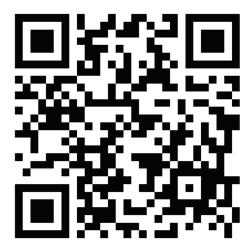
CORRECTIONS POLICY: Our staff strives to represent our community fairly and conduct accurate, truthful storytelling. We list all errors of an issue, along with the page number of that error, in the next issue’s
I’m determined not to get too comfortable. Growth happens when we step into positions we’ve never played, so I challenge my fellow journalists to say “yes” to the assignment that scares you, the section you’ve never covered and the story you don’t yet know how to tell. So, I encourage readers to look for your own center field. Find the position you think you’re least qualified for and try it anyway.
Waymo plans SJC, Silicon Valley operations

SELF-DRIVING SERVICE Senior Lily Shi sits inside a Waymo vehicle in San Francisco, which she called using the Waymo One app. Waymo received permission from SJC to test and operate at the airport before large sporting events draw crowds in 2026.
Autonomous vehicle pioneer Waymo will expand its driverless ride-hailing services to San Jose Mineta International Airport (SJC) later this year.
Waymo received permission from SJC on Sept. 3 to test
and operate at the airport in anticipation of the 2026 World Cup and Super Bowl LX, events expected to draw hundreds of thousands of visitors to the city.
“It’s the perfect time for Waymo’s autonomous vehicles to begin to roll into San Jose, the Capital of Silicon Valley,” San Jose Mayor Matt Mahan said
SENSING SUCCESS Waymo cars are equipped with a suite of sensors, including LiDAR, radar, cameras and microphones to vizualize their driving environments.
in an SJC press statement. “For decades, our region has shaped the future — and Waymo embodies our region’s spirit of innovation.”
The company already offers driverless services in several Bay Area cities. Waymo began full commercial operations in San Francisco in 2024, and a slow rollout operation for Silicon Valley cities
from Menlo Park to Mountain View is gradually enabling ridehailing services for residents through the Waymo One app. San Jose currently remains in a preliminary testing phase.
“The expansion, if the technology is good, can only be a good thing,” Waymo rider Liam McGrath (11) said.
“Fewer human drivers would be better because [self-driving cars] are less prone to mistakes. They wouldn’t be influenced for reasons like ‘I’m going to run this yellow because I’m late for work.’”
In a survey of 116 students and faculty, many
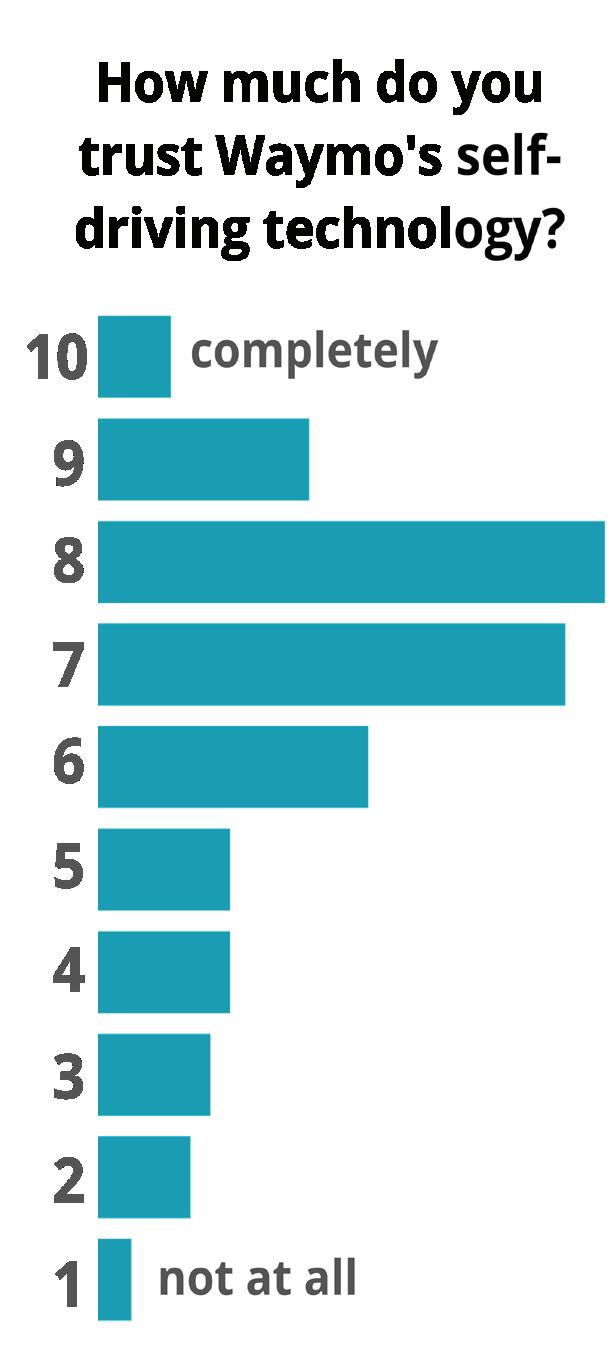
members of the Harker community expressed interest in self-driving technology, though many also voiced doubts about its reliability. Survey respondents rated their trust in Waymo’s vehicles at an average of 6.4 on a scale from 1 (“not at all”) to 10 (“completely”). Those with reservations cited only trusting human drivers, safety concerns, the newness of selfdriving technology and highprofile self-driving failures.
“Going into a self-driving car, you’re putting a lot of expectation and pressure on the technology to make sure that you’re safe,” frosh Maggie Hu said. “There are better ways to test new technology than risking people’s lives for it. I would be open to hearing more about what they do, but personally, I still wouldn’t get in that car.”

Inside the safety record of Waymo vehicles
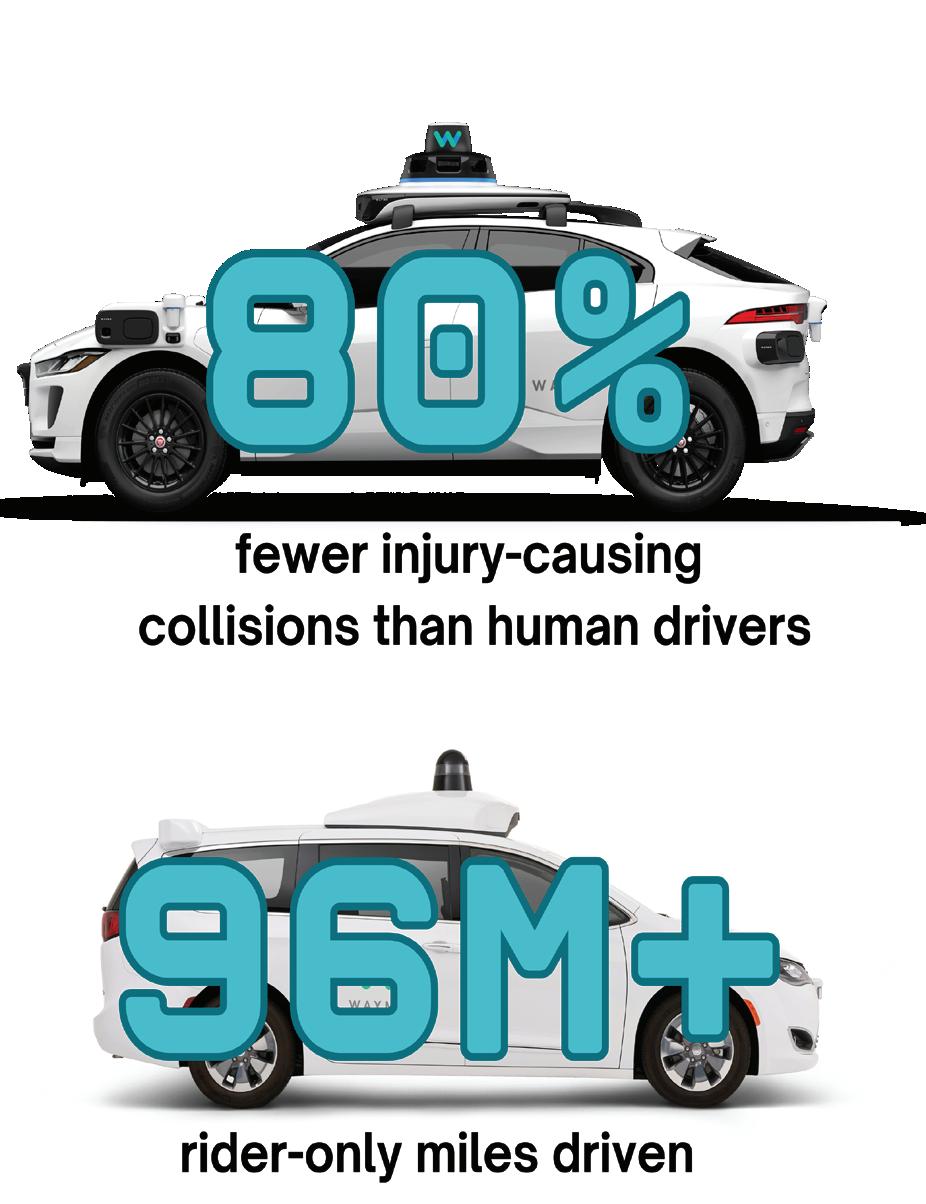
Waymo reports an 80% lower rate of injury-causing crashes than human drivers. The company cites its extensive training process, comprehensive system of sensors and safety records as evidence that its self-driving cars are already making roads a safer place.
Automated vehicles’ AI models are trained from vast datasets gathered from mapping streets, detailed crash reports and videos, and custom simulations. At his self-
driving startup HIGHWAI, AI expert Raul Diaz worked with various car companies, though not including Waymo, to realistically simulate various scenarios under different weather and driving conditions.
“I have a lot of confidence in self-driving cars because I know how they were trained,” Diaz said. “For every mile that they are actually driven, they’re trained on about a billion synthetic miles, probably more these days.”
Waymo spends years preparing before opening commercial operations in every new location. They first perform preliminary mapping, where a team of manuallydriven Waymo vehicles use LiDAR sensors to capture threedimensional representations of
street environments.
After a period of road testing with safety specialists in the driver’s seat, the company gradually increases the number of self-driving cars and riders until they are ready to serve the general public. Each step requires approval from the DMV and local regulatory body for public services.
San Francisco resident Tracy Sena joined Waymo’s trusted tester program in 2021, three years before the company’s full commercial launch in the city in 2024. Receiving free rides twice a week for 18 months, she submitted reportw xs documenting her experience and reported noticed errors.
“I remember one dangerous incident: there was a particular intersection with a fast
turning light that I reported,” Sena said. “The very next day, driving in my own car, I saw two Waymos going back and forth testing the intersection, which is amazing.”
Over the years, Waymo has improved at sharing roads with human drivers. Early on, its cars sometimes confused human drivers with “ultracautious” behavior and struggled in traffic scenarios requiring human communication, like four-way stops — but this is no longer an issue according to Diaz.
“They’re adapting to human parameters,” Diaz said. “They do things a human would do, not because they need it, but because they know that other humans need it.”
West Coast breaks with CDC on vaccines
New West Coast Health Alliance for scientific vaccine guidance
The West Coast Health Alliance (WCHA), providing regional health guidance as an alternative to the CDC, released seasonal vaccine guidance to support broader COVID-19 vaccine coverage on Sept. 17. The CDC finalized its removal of blanket COVID-19 shot recommendations on Monday.
Comprising California, Washington, Oregon and Hawaii, the WCHA formed on Sept. 3 as a regional response to sweeping changes to the CDC under U.S. Secretary of Health and Human Services Robert F. Kennedy Jr., who has promoted discredited anti-vaccine theories. The alliance issues science-based public health recommendations to inform state policy.
The FDA has approved this year’s COVID-19 vaccine only for people over age 65 and those with underlying conditions. On Monday, the CDC controversially withdrew its blanket COVID-19 vaccine recommendations, introducing hurdles to vaccine access nationwide. California will still offer insurance-covered COVID-19 shots under the AB 144 bill coinciding with WCHA vaccine guidance, though many states will not.
Harker Director of Health Services Debra Nott has been following U.S. vaccine policy closely and oversees Harker’s immunization clinics, which offer vaccines including the COVID-19 shot.
“Our clinics are run through Walgreens pharmacists, who say they are willing to immunize anyone who says they want a shot,” Nott said. “Theoretically, that person should have some kind of risk factor if they are under the age of 65. The pharmacist I work with told me
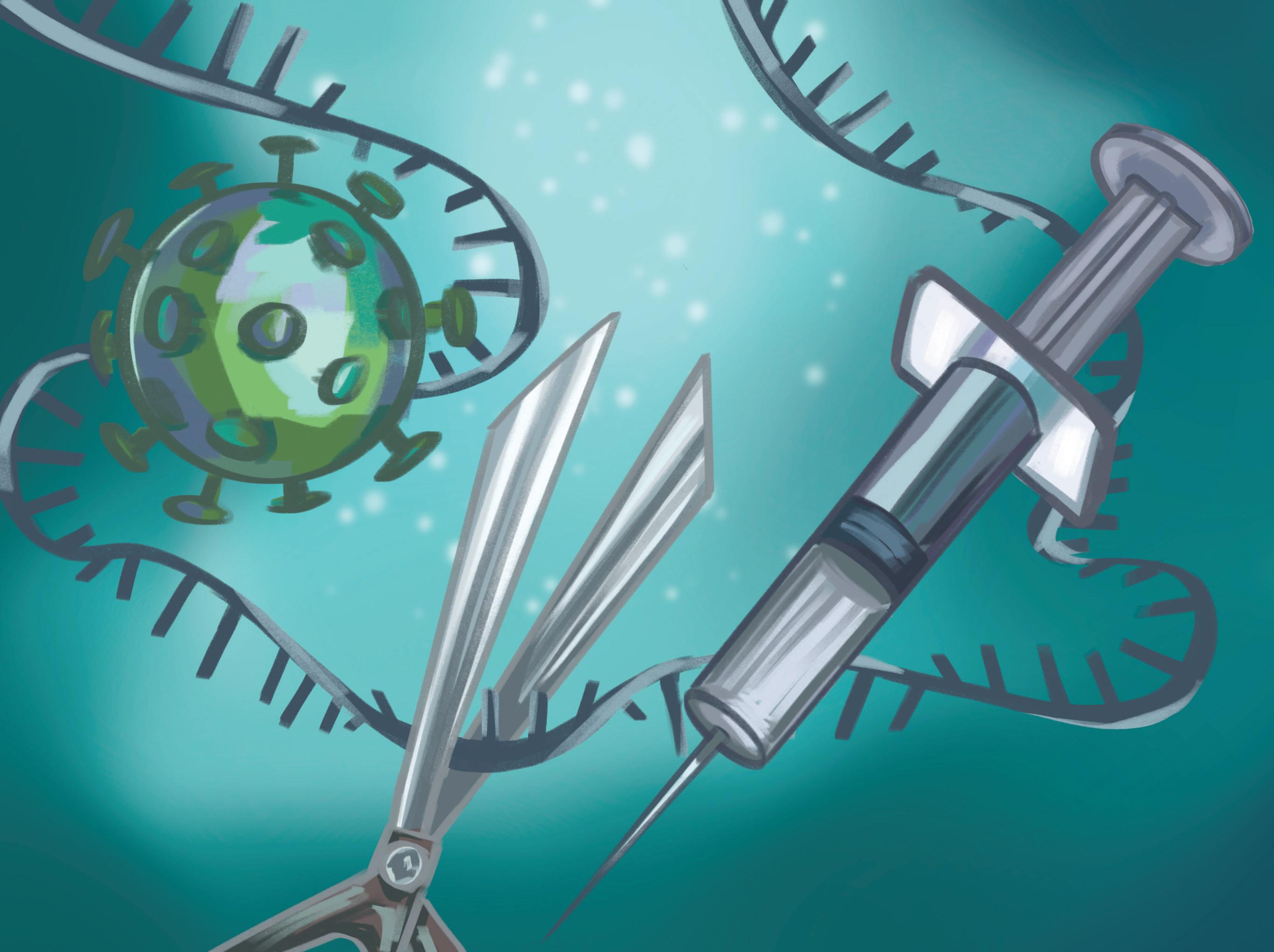
they’re not going to ask you to say what that risk factor is.”
Without federal financial support for vaccines, manufacturing companies may hesitate to fund their production. Biology and research teacher Mike Pistacchi hopes that the WCHA can help continue to push vaccine production for the states in the alliance to maintain the local supply.
“[The CDC] is having a huge chilling effect on the ability and the willingness of companies to manufacture the vaccines and also for insurance companies to pay for vaccines,” Pistacchi said. “The states can apply back pressure if states get together and say, ‘No, if an insurance company wants to operate in our state, they have to pay for these vaccines regardless of the CDC’s guidance.’”
Despite changes to the CDC, some health insurance providers have pledged to
continue covering vaccines for the foreseeable future, like Aetna, Kaiser and Anthem Blue Cross. Nott explained that some firms, however, may be incentivized to stop paying for optional immunizations.
“I don’t know how many insurance companies are going to follow suit and do the right thing because, as you can imagine, they are quite motivated by profit,” Nott
said. “Sometimes they’ll look at the bottom line and say, ‘What would it cost if we didn’t immunize healthy people under 65?’ If they save more money by not immunizing the people who would get COVID but not get that sick, it’s a matter of deciding which choice is going to cost them less.”
The WCHA’s vaccine recommendations may help protect the West Coast region.

Math club presents puzzles and poker in games meeting
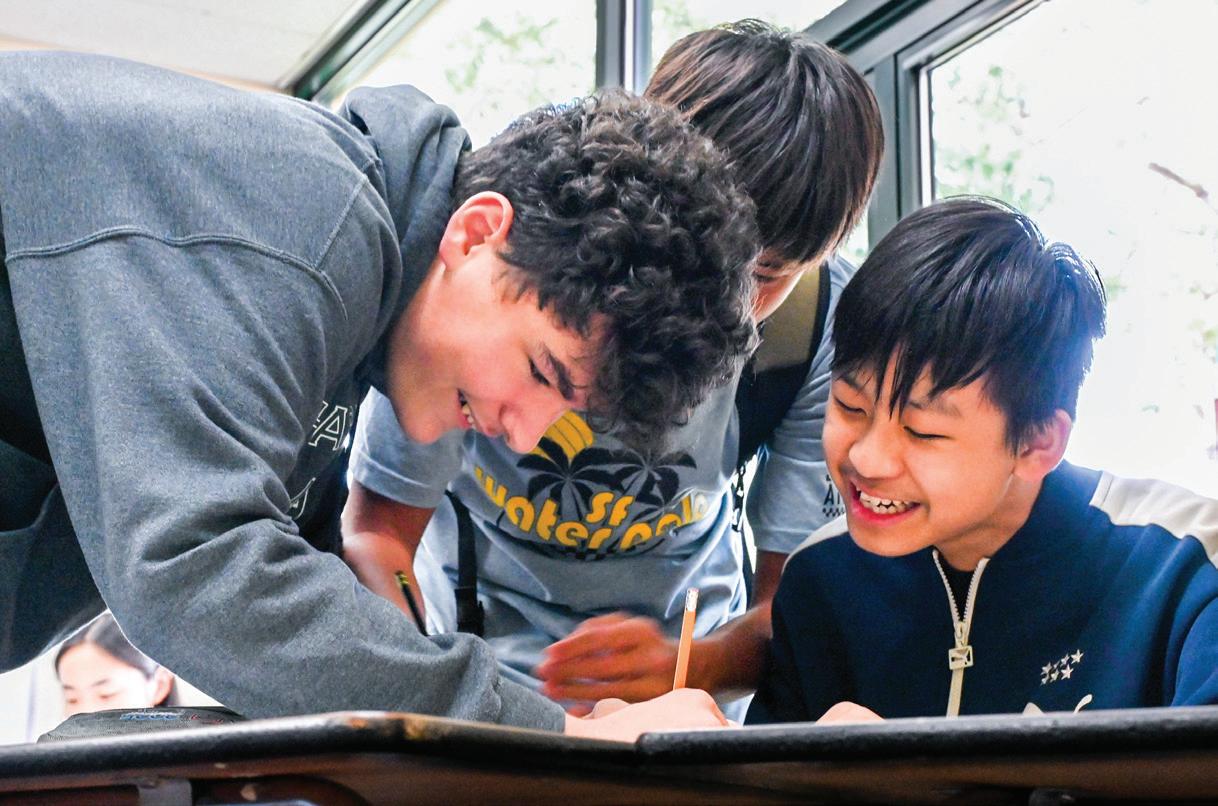
play any game of their choice.
Math Club hosted a “Puzzles and Games” meeting featuring poker, the card game Set and logic puzzles during lunch on Sept. 29.
Officers taught the rules and basic strategies of the games to members, who were free to
The puzzles encouraged logical thinking, pattern recognition and systematic problem-solving skills as opposed to specific mathematical concepts.
“I like math puzzles since they are similar to figuring out a complicated proof or problem; you treat the puzzle in parts and
get to apply logic in a similar way to some geometry problems,” attendee Michael Petrov (10) said. “I also like to see how different people approach the same problems.”
Math Club Co-President Heather Wang (11) curated several grid-based math puzzles similar to the popular game Sudoku, while Vice President Anika Rajaram (12) organized a game of Set, a pattern-finding card game. Co-President Jonathan Li (11) arranged and led a game of poker.
“Compared to other Math Club initiatives, such as lectures, competitions and events, meetings with puzzles or games are more interactive and relaxed,” Jonathan said. “They also tend to be more beginnerfriendly, so they’re often some of the most popular meetings that we host.”
Club officers organize puzzle sessions regularly to encourage new members to join
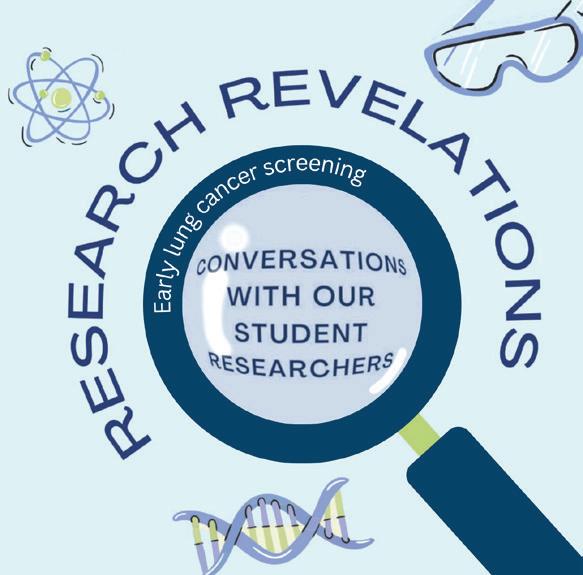
Exploring Early Lung Cancer Screening with Ananya Pradhan
Exploring early lung cancer screening with Ananya Pradhan
caden ruan
Q: What is your research about?
A: “My research focuses on how we can use genomic data from circulating cell-free DNA, incorporating both genetic and epigenetic features, to build models that will be able to predict in very early stages for people whether or not they have lung cancer and also estimate their tumor fraction.”
Q: What was your research process?
A: “The first part of my workflow was extracting features that are biologically relevant that hopefully the model would use. The second main phase of the project was model development, which is still ongoing, building different kinds of models that will help with this early cancer screening.”
Q: What were some major challenges or setbacks?
casual, entertaining meetings without requiring an extensive background in mathematics. They offer opportunities for members to bond and work together over games.
“I like mathy puzzles since they are similar to figuring out a complicated proof or problem.

MICHAEL PETROV (10) MATH CLUB MEMBER
“I like poker because it’s a social game, and even beginners can win with some luck,” attendee Elaine Xu (11) said.
“My favorite puzzle is the simple loop because it seems simple at first, just drawing a loop, but it’s actually so difficult.”
A: “A really big challenge, especially in genomic research and the computational side of things is taking all this raw, unstructured high volume data and trying to extract meaningful information from it both computationally and biologically. It’s challenging but it’s one of the most rewarding parts of the process.”
Q: What is one piece of advice you would give to someone starting research?
A: “Thinking outside of the box while collaborating and asking hard questions and having that kind of dialogue and discourse with your mentors is really important.”
Blooming from the STEM: Pioneering platforms
Meghana Dhar (’06) bridges business strategy and technology
elizabeth zhang & lindsay li
Juggling technology, law and business might sound like three different careers, but for Meghana Dhar (’06), the combinations of those fields have defined her path. Now a Silicon Valley executive and founder of Tea in Tech, she sits at the forefront of conversations about artificial intelligence.
In 2017, Dhar became the first hire on Instagram Shopping’s go-to-market team and led a global team for the platform. She later joined Snap Inc. as Global Head of Partnerships, working with brands and creators like Kim Kardashian and Coachella to “make Snapchat cool again,” she joked.
“That’s where I really fell in love with tech platforms, the future of social media, buying and selling,” Dhar said. “Everything at the time was going online and towards being mobile and adaptable, understanding where the needle is moving and thinking about how to drive value. Those are the skills that I actually used in my jobs.”
After recently returning to Silicon Valley, Dhar developed a keen interest in AI, whose potential in businesses, she notes, has mostly been exclusive to the area. Now, as a strategic adviser for venture capital startups and businesses, she aims to meld the two fields, with companies like General Motors reaching out to discuss implementing AI into their own products.
Fittingly, Dhar recently launched a passion project Tea in Tech, a media brand and newsletter that provides insights on AI and, as the name suggests, technology. Across platforms, Tea in Tech has reached an audience of 55,000.
Between starting out with an interest in policy and law to a career in business and AI, Dhar’s career has made many turns. However, she has made the most out of her experience, being named a member of the Forbes 30 under 30 list and finding work that she both finds passion in and is impactful.
At first, her experience at Harker from K through 12 did not focus on technology. Her experience as the captain of the debate team and the mock trial team inspired her to become a criminal defense or civil rights attorney. Entering college at the University of California, Berkeley, with her sights set on law school, Dhar passed the LSAT and
My mission was about democratizing access and justice and bringing information to people.

MEGHANA DHAR FORBES 30 UNDER 30 RECIPIENT
”
earned admission to several law programs after graduation. However, a rotational role at Visa introduced her to the fast-

world of business, where she discovered that she loved strategy and innovation.
“I kept deferring and going, ‘One more year. One more year,’” Dhar said. “Finally the law school said, “You gotta make up your mind,” and I realized I didn’t want to go to law school anymore. What’s funny is, I was working with corporate lawyers, and I realized how boring their jobs were. Mock trial was fun, but the reality of the law was really different.”
From working at Visa, Dhar then moved onto eBay before enrolling in Harvard
Business School’s two-year program. That decision paved the way for her entry into consumer technology, a field encompassing everything from smartphones and laptops to social media platforms, e-commerce sites and digital payment systems.
“My mission in life, even when I wanted to be a lawyer, was about democratizing access and justice and bringing information to people,” Dhar said. “There’s no one really talking about AI from a strategic lens or from a business lens, and so that’s my mission. I’m really enjoying
it, and it’s allowing me to tap into my creativity and think critically about bigger themes.”
Throughout her life, Dhar has traveled from coast to coast. Raised in the Silicon Valley, traveling to Harvard, then to New York and LA before returning home, Dhar realized how pervasive AI has become.
“Especially in a world of AI, things are changing really quickly,” Dhar said. “You need to be able to be creative, think critically and find a path. Pivot and then keep moving. That’s what makes really successful business people, and that’s a skill you learn at Harker.”
Doomscrolling traps media users in cycles of stress

aileen
Doomscrolling, or the compulsive consumption of negative online content, has become a hallmark of digital age anxiety. With news of crisis and conflict dominating screens, this habit exposes people to a constant flow of troubling news that takes a psychological toll.
“Doomscrolling is addictive because of the immediate gratification of being able to get content, whatever that content that is we’re getting,” academic counselor Jonah Alves said. “It’s easy — you’re just flipping up or down and constantly getting new videos.”
According to the Pew Research Center, 48% of teens feel overwhelmed by the news,
as social media algorithms like TikTok and Instagram evoke negative emotions like fear, anger or sadness to keep users engaged. For instance, once a user clicks on a video about a disaster, the app may begin recommending more stories about tragedies, political scandals or public health crises. The ease of accessing these media platforms makes it
effortless to scroll for hours.
Psychology teacher Julie Turchin explained that doomscrolling hooks users through operant conditioning, the same principle that underlies habits like gambling.
“The systems are set up to find things that you find really interesting, and send you more of them,” Turchin said. “They’re continuous, so there’s no end to it. Focusing on negativity reinforces neural pathways. That’s how someone ends up always looking for the negative.”
The behavior of doomscrolling activates in the brain’s threat-detection system, where the amygdala, or fight-orflight sensor, drives us to keep scanning for potential dangers. When the amygdala is on high alert, our nervous system releases an immense amount of stress hormones like cortisol and adrenaline. Our brains are able to handle short bursts of stress, but doomscrolling keeps the nervous system activated far longer than it can tolerate.
Over time, this sustained stress can heighten anxiety, worsen mental well-being and contribute to popcorn brain, which occurs when your brain
becomes accustomed to the overstimulating nature of social media and struggles to focus on the slower pace of real life.
Like any other addictive behavior, doomscrolling also triggers the brain’s reward system, causing dopamine spikes that leave users drained when those levels drop back to normal. Neuroscience Club Vice President Aubrie Su (10) noted that she also struggles to control her scrolling habits.
“I’ve noticed that every time I finish scrolling, I feel incredibly guilty,” Aubrie said. “Harker is a very high pressure environment, and as a result, people will try to alleviate this stress through doomscrolling.”
Doomscrolling is not just addictive — it damages attention spans and sleep cycles. Exposure to high volumes of negative content before bed is linked to delayed melatonin production, resulting in worse sleep quality. In turn, sleep deprivation worsens memory retention, creating a feedback loop of cognitive fatigue.
“Oftentimes we’re found doomscrolling at night,” Alves said. “Even when you put your phone away, you worry more.”
Transitioning to upper league
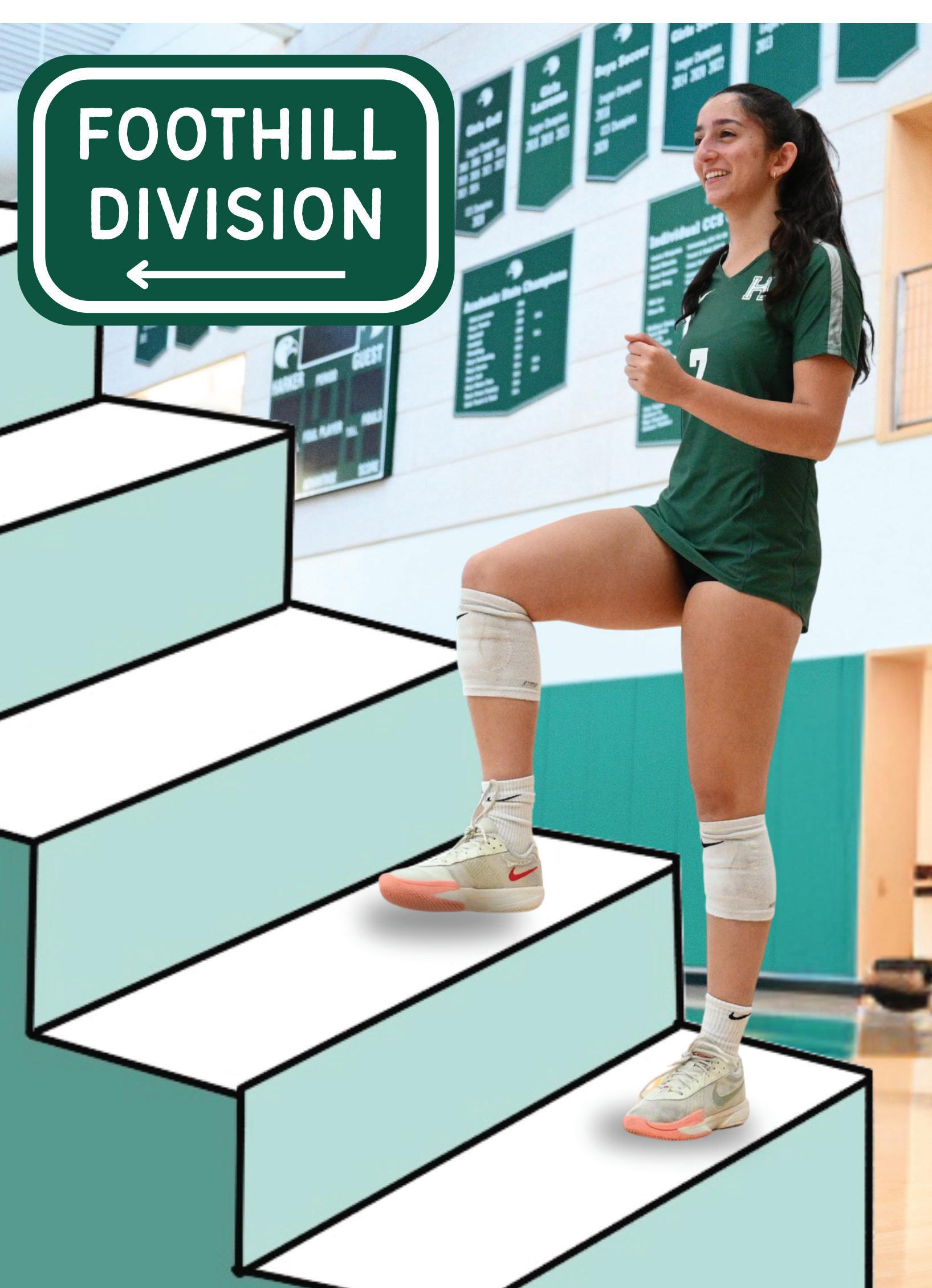
Varsity girls basketball and volleyball earned promotions to the Foothill Division, the highest tier in the West Bay Athletic League (WBAL), after winning their leagues last season.
Moving up to Foothill means the teams will be competing against much more challenging opponents.
Alum and varsity girls basketball coach Daniza
Rodriguez (’13) believes that the promotion to the Foothill Division is a testament to the program’s growth.
“It’s exciting because as an alumna, we didn’t compete when I was a student,”
Rodriguez said. “We were always in the lower division, and even then, we always took second place. To know that the girls not only put up a banner last year, but are also able to compete with some of the top teams, it’s really great for hardcore basketball.”
Underregulated sports betting harms fans and athletes
Death threats. Career-ending scandals. Ruinous addictions.
While these concepts might seem a far cry from casual sports fans participating in beer fantasy leagues or placing $10 wagers to make inconsequential games more engaging, they have all arisen directly from the sports betting industry’s explosive growth over the last decade.
Sports betting has become incredibly popular in the U.S., with hundreds of billions of dollars wagered each year on sports from baseball to bowling. Although banned in California, it is currently legal in 38 states, and online betting is allowed in 30. All major American sports leagues have partnered with sportsbooks, and teams across the country have established sponsorship agreements to promote gambling platforms.
Despite the ban in California, the San Francisco Giants and Golden State Warriors have deals with PrizePicks and Betway, respectively; these deals
Both teams’ coaches have implemented new training strategies to prepare for the new level of play. The varsity girls basketball players have been lifting weights and attending open gyms in the off-season to build the physical strength and techniques needed to compete against stronger and more experienced opponents.
Meanwhile, the varsity girls volleyball team has been training with players from the junior varsity boys team to simulate the stronger hits and higher jumps of their new opponents. This adjustment is already showing results, as the girls swept Crystal Springs Uplands in their first match in the new division and fought until the fifth set against Notre Dame Belmont.
“We approach each and every practice with enthusiasm and a willingness to work hard so that we can compete at this level,” varsity girls volleyball coach Theresa Smith said. “We are trying to be the best team we can with the players that we have. We have a really special team this year. We have seven seniors, and our captains have admirably set the tone for the season.”
Harker competes in the WBAL as a Division V school in the Central Coast Section (CCS). The WBAL comprises private schools in CCS with similar athletic and academic programs. For girls sports, the WBAL is split into two tiers: the lower Skyline Division and the upper Foothill Division.
Varsity girls volleyball cocaptain Nat Tan (12) emphasized the importance of embracing the increased challenge in the Foothill Division.
“It’s really just about believing that at whatever point
we’re at and whatever lineup is on the court, we need to want and believe that we can win this,” Nat said. “At the end of the day, volleyball is a game of who wants the game more, and the team that wants the game more will most likely win.”
Regardless of the outcome, Rodriguez view the promotion as a way for the girls to focus on testing themselves against tougher opponents.
“It’s about believing that we can win at whatever point we’re at and with whichever lineup is on the court.

NAT TAN (12)
VARSITY GIRLS VOLLEYBALL CO-CAPTAIN
“For this upcoming season, my goal is for the girls to really enjoy playing at a competitive level,” Rodriguez said. “Sometimes, when you’re playing against teams that aren’t as competitive, it tends to get boring. What we’re looking forward to is getting them out there and letting them have fun and enjoying playing at a competitive level.”
Smith echoes this sentiment, regarding each Foothill Division game as an opportunity to get better.
“We measure success through our ability to compete at this level,” Smith said. “Win, lose or draw, we want to compete and make it a good game. Most of all, it’s the experience that the girls and coaching staff share together while we do our best to compete.”
Dear Jeremy
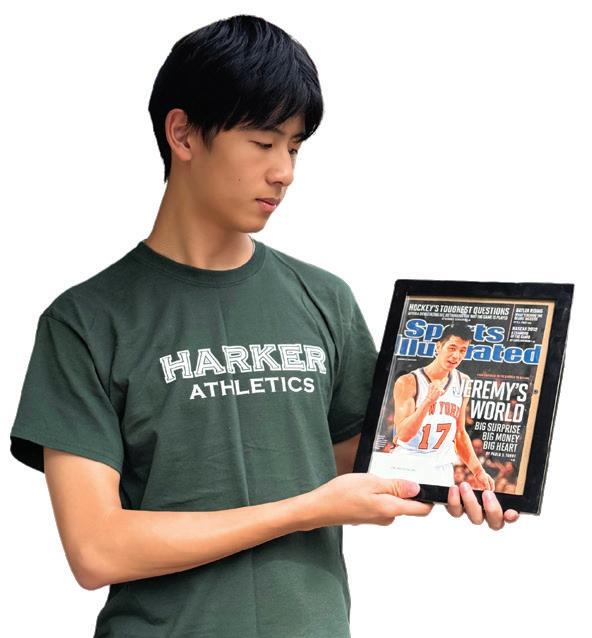
kairui sun
ZHU I opened Instagram on Aug. 30 to ESPN proclaiming in bold: Jeremy Lin officially announces retirement.
I’ll admit, I teared up as I stared into my phone. I reminisced on the hours I spent as an incredibly bored 10-year-old, scouring Youtube for “Jeremy Lin highlights” or “Linsanity reactions.”
The prevailing narratives about Lin never fail to mention his Asian ethnicity, and understandably so. I’m an Asian athlete who has spent the last five years flying across the country to volleyball tournaments. At times, I’ve felt aware that I’m one of, if not the only, Asian on the court. But this awareness always disappears within seconds, not quite enough to feel a connection with Lin’s experience in the NBA.
What will continue to resonate about Lin’s story, however, was the mental war he fought with himself.
What will continue to resonate about Lin’s story was the mental war he fought with himself. ”
are possible because California considers daily fantasy legally distinct from sports betting. The aforementioned partnerships have helped to normalize sports betting, just a few years after leagues like the NHL and NFL expressed that it threatened competitive integrity.
Indeed, the perverse incentives and behavioral risks associated with sports betting means that it must be more tightly regulated. The amount of money in this space pushes both players and fans to engage in unethical and even criminal acts, and the financial consequences of gambling addictions have devastated many families.
Athletes receive death threats, demands for money and social media abuse from disgruntled bettors, and the anonymity offered by online platforms makes it challenging to resolve this problem.
Before the landmark 2018 Supreme Court decision in Murphy v. National Collegiate Athletic Association, which allowed states to sanction sports
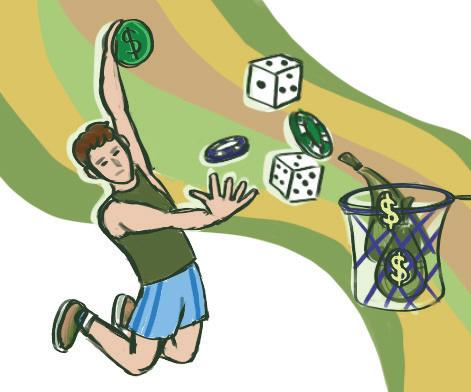
betting, the Professional and Amateur Sports Protection Act essentially outlawed sports betting in the U.S.
Despite the ban, exemptions for states with existing sports lotteries and for sports like dog racing meant that sports betting didn’t entirely disappear, and underground organizations popped up to meet unmet demand for other events.
Professional sports leagues must rethink their acceptance of sports betting. Government
regulators must clamp down on the industry with policies that limit the spread of sports betting while respecting states’ authority to establish their own policies. Unchecked, gambling transforms from an entertainment product to an addictive epidemic. Existing regulations in sports betting don’t go far enough to limit the incidence of problem gambling, remove incentives for athletes to matchfix and ensure the integrity of sports.
Visit harkeraquila.com for more.
On Dec. 9, 2011, the Warriors waived Lin. Two weeks later, on Christmas Eve, so did the Rockets. In January, the Knicks relegated Lin to the Development League.
There was no hiding the truth: Lin’s basketball career was dying. Yet every day, Lin focused on correcting his flaws. He devoured game film by demanding to see his turnovers and missed jumpers, not his highlights.
On Feb. 8, 2012, the Knicks led the Celtics on the road, 74-69. Heading into the fourth quarter, the Knicks stretched the lead to as much as 10. But when the buzzer sounded, Ray Allen had led the Celtics to a 91-89 comeback. There’s no denying Lin’s stroke of luck. But he delivered — a testament to the unseen hours he had poured into basketball. Hard work doesn’t guarantee a miracle, but ensures that miracles don’t pass by uncaptured.
Since I first heard this story several years ago, it’s stuck with me as a show of Lin’s humanity. Far from a machine, the Lin before Linsanity was just a young man on his brother’s couch, wrestling self-doubt and fear of failure.
Visit harkeraquila.com for more.
Wall on water:
Senior Alejandro Cheline leads water polo team as goalkeeper
Sixth-seed Harker varsity boys water polo clings to a one-goal lead against third-seed Bellarmine, a chance to rewrite the team’s history on the line. As goalie Alejandro Cheline (12) rises in the cage, all eyes at the Central Coast Section Open Division quarterfinal are on him.
Whistle.
Alejandro resets himself as the Eagles face a five-on-six disadvantage after a teammate’s ejection. He immediately braces himself for a strike at one post. But instead of shooting, Bellarmine’s attacker whips the ball across to their most dangerous player, who fires a shot towards the open side. In milliseconds, Alejandro lunges and deflects the shot wide. Two more strikes follow — he blocks both.
Whenever you do something, believe you’re the best and that you can absolutely do it.

“If I hadn’t made those saves, we would have lost the game,” Alejandro said. “It was the first time that Bell didn’t even make it to the semifinals. A coach polled before the game asking who everyone thought was going to win, and around 97% said that Bellarmine was going to win, and 3% said Harker. It was a shock.”
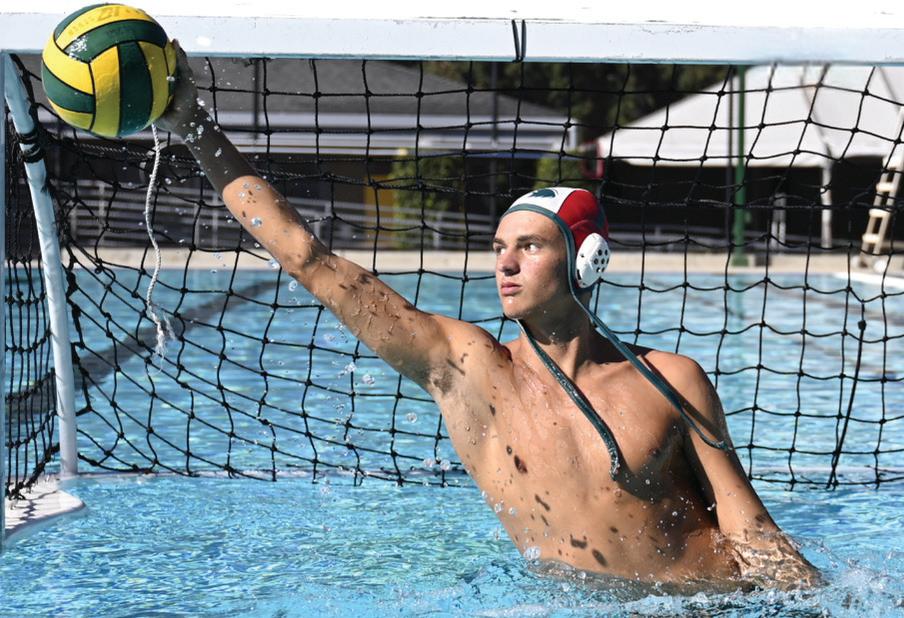
In this game, Harker claimed its first victory in CCS Open Division playoffs, representing the culmination of years of effort and faith in the team.
Alejandro’s journey in water polo began at five years old, when his mom signed him up for San Jose Express, a new club founded by Coach Victor Adler. As a varsity player now, he spends six to seven hours a week in the weight room. In the summer, he doubles up on pool practices, consistently training for over 20 hours a week.
“[Goalies] definitely train our legs a lot more than the field
players,” Alejandro said. “You need to have complete control of your body in the water at any angle and be fluid in the water. I really like doing hand speed drills to work on reaction time: whatever heavy object you can find, lifting it in the pool, doing lunges at each corner of the cage.”
This past summer marked Alejandro’s 11th appearance at the Junior Olympics, the largest annual youth water polo tournament in the country. Playing for Stanford Water Polo Club in the 18U Platinum Division, the tournament’s highest level, Alejandro recorded 9.8 blocks
per game, the top mark of any goalie nationwide. He participates in private sessions with Olympic goalies Viktor Nagy, Sean Nolan, Jack Bowen and the Stanford Men’s Division I squad. Their mentorship pushed him to refine details of his positioning, fueling his rise to a D-I commit. Junior Akash Dubey, who has played alongside Alejandro since middle school, highlights his ability to read the game.
“He has a lot of game IQ,” Akash said “He knows when to block a certain part of the cage versus another. If there’s a shot from farther out, he’ll know
Athlete-influencers form communities
Heavy breathing, squeaks of shoes and witty banter echoes through a gym as two basketball players match up. One is FlightReacts, a basketball influencer with nearly 5 million subscribers on YouTube, and the other is Harker alum Roy Yuan, a former Division I basketball player for Stanford. This showdown captures the intersection between content creation and traditional athletics.
Yuan attended Harker from eighth to ninth grade from 201516 and played on the basketball team. He later enrolled at Stanford, not as a basketball recruit, but as a student. To pursue his goal of playing Division I basketball at Stanford, he became team manager and spent free time practicing in his the gym. Gradually, the coach noticed Yuan’s skills and in sophomore year, offered him a spot on the team.
However, Yuan never set out to become a content creator. Last
year, he filmed a one-on-one basketball game with a friend and casually uploaded the video to Youtube. His video quickly went viral, garnering over 700,000 views. Currently, he has 48.9K and 14.7K followers on YouTube and Instagram, respectively.

“It gives me a reason to continue playing basketball and gives me more motivation,” Yuan said. “A lot of people like to reach out, and it’s fun meeting new people and doing collaborations through social media with other creators.”
His talent and social media presence allowed him to play one-on-one with content creators like CashNasty and FlightReacts. However, after Yuan graduated and began working, his goals for social media shifted to documenting his life and connecting with other players.
“As I think more and more about what I want to do, doing more vlogs centered around basketball rather than just playing seems more interesting,” Yuan said. “I want to explore what the hoop scene is like in other places of the world is like.”
Frosh Faye Gu launched her journey as a dance influencer in middle school after partnering with the popular dancewear brand AK Dancewear. Though she shared a few videos
when to prioritize being further outside of the cage or right inside the cage. He just always knows where he needs to be.”
Aside from his training in and out of the pool, Alejandro devotes time to help his teammates sharpen their skills. He attends their private practice sessions and volunteers to play as a goalie.
“I want to help my teammates,” Alejandro said. “The better they are, the better I get. The practice is good because you want to be getting better every minute you’re in the pool. Whenever you’re not getting better, it feels like a waste of time.”
through content
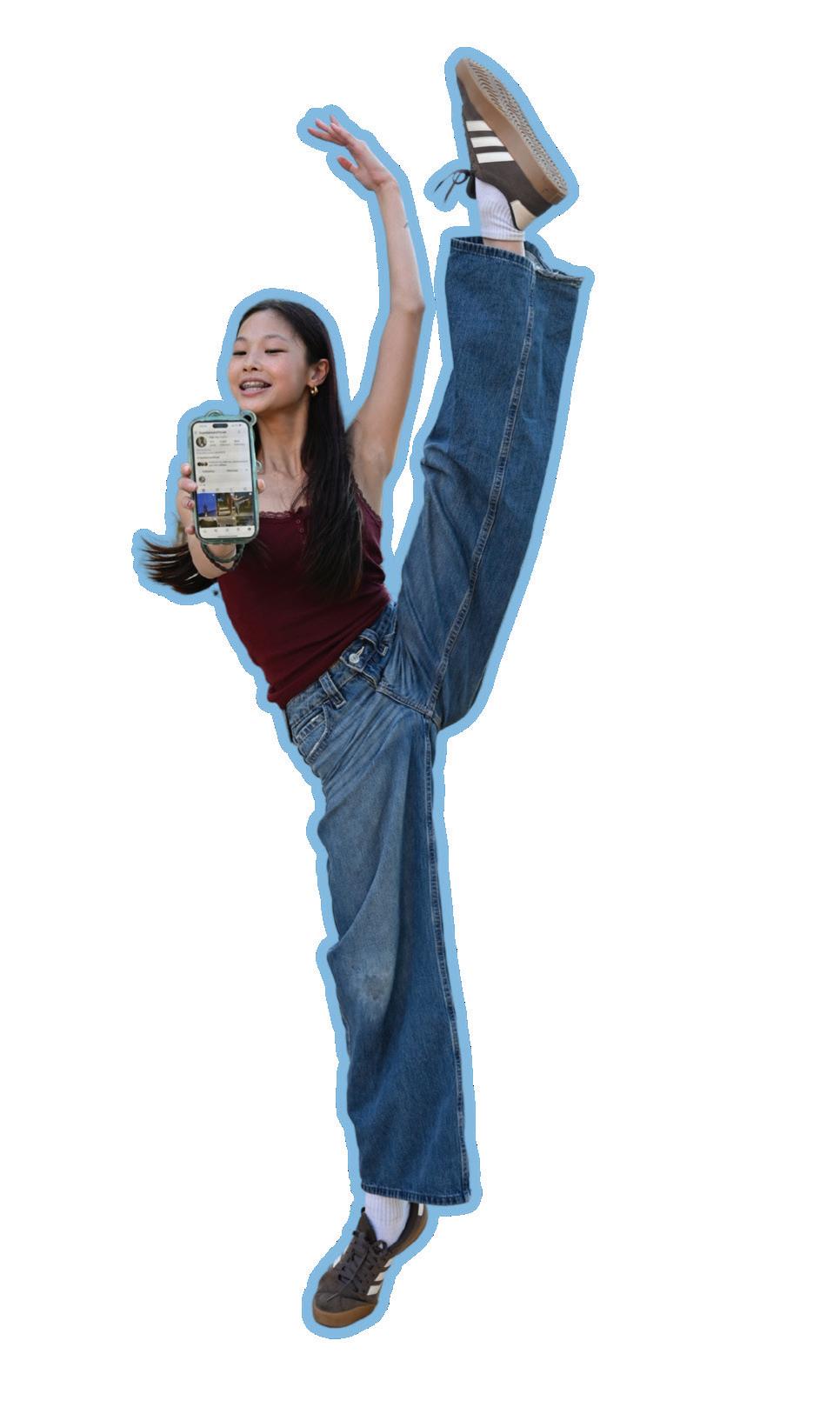
on her Instagram account before, that collaboration encouraged her to
“I applied to be an AK ambassador after I saw their loving community and their really amazing dancewear,” Faye said. “After I became an ambassador, I loved their community and I started posting a lot more. I usually do dance moves to trending songs and edit them together to Harker’s varsity girls volleyball team also runs an Instagram account, and they film casual videos of trends and post-game recaps. Senior Eden Kelly, who edits and posts videos on that
account, shared that filming improved team camaraderie and morale and emphasized that the purpose of the account is mainly to attract students to watch their games.
“It’s more about, ‘Guys, please come to our game,’” Eden said. “Even if the reel gets only 20 likes, but five of those people show up, I would much rather have that than getting 100 likes and only two of those people show up. It’s more about having people support us.”
Yuan shared his advice for student-athletes navigating their commitments and posting content online.
“There’s a lot of pressure in everyone’s lives, but ultimately it’s just about deciding what you want to do,” Yuan said. “If I had time and if there’s an opportunity, I would go do it, but I would never prioritize that over things like school or player duties.”

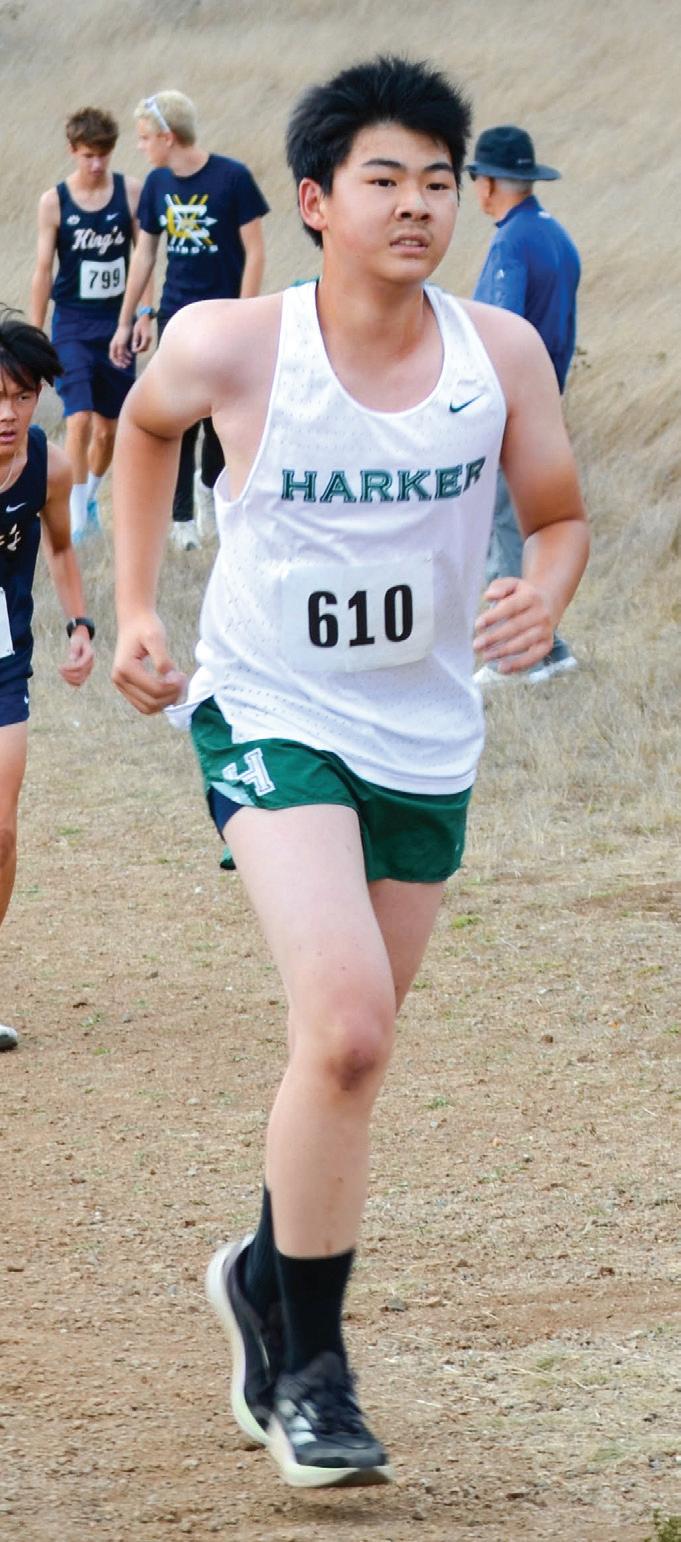

TOUCHDOWN TURNAROUND (TOP LEFT) Varsity football running back Pedro Castro III (11) cuts outside after a handoff. The Eagles defeated BASIS 74-6 on Sept. 11. READY SET RUN (ABOVE) Cross country runner Bryan Ma (10) competes in the Knights Joust Invitational. The team scored multiple records. OPEN ON OFFENSE (MIDDLE) Varsity girls water polo player Isabel Yang (10) extends her arm to shoot. The team won their Harker Day game against Cupertino 12-3. EYES ON THE HOLE (TOP RIGHT) Varsity girls golf player Kimaya Mehta (12) prepares to putt. The team holds a record of 8-0. STEADY SWING (MIDDLE RIGHT)
Varsity girls tennis player Alyssa Lee (9) aims at the ball. Alyssa and partner Claire Xu (11) won their match, securing the team win. THERE FOR THE TIP (RIGHT) Varsity girls volleyball opposite hitter Nat Tan (12) tips the ball during the season opener against Branham. The match extended to five sets, with Harker winning. LIFTING TO LAUNCH (BOTTOM RIGHT) Varsity boys water polo player Ossi Carrico (10) prepares to shoot. The team won against Menlo 9-6. with an “attention grabber” in CAPS,
PURPOSEFUL PLAYS:
Fall athletes make key decisions, turn tides
Wlily peng
ith the fall season underway, fall athletes have pushed through obstacles and put efforts into fruition. From tiebreaking shots to overwhelming victories, decisive moments have shaped the season so far.
Despite setbacks in roster and cancellation of the homecoming game, varsity football persisted, conquering BASIS in their season opener 74-6. For cross country, several runners hold top-20 times in the state as they break personal and school records.
“We both actively changed that mindset to become more communicative, and with that positivity, we were able to win the tie.

ALYSSA LEE (9)
VARSITY DOUBLES
TENNIS PLAYER

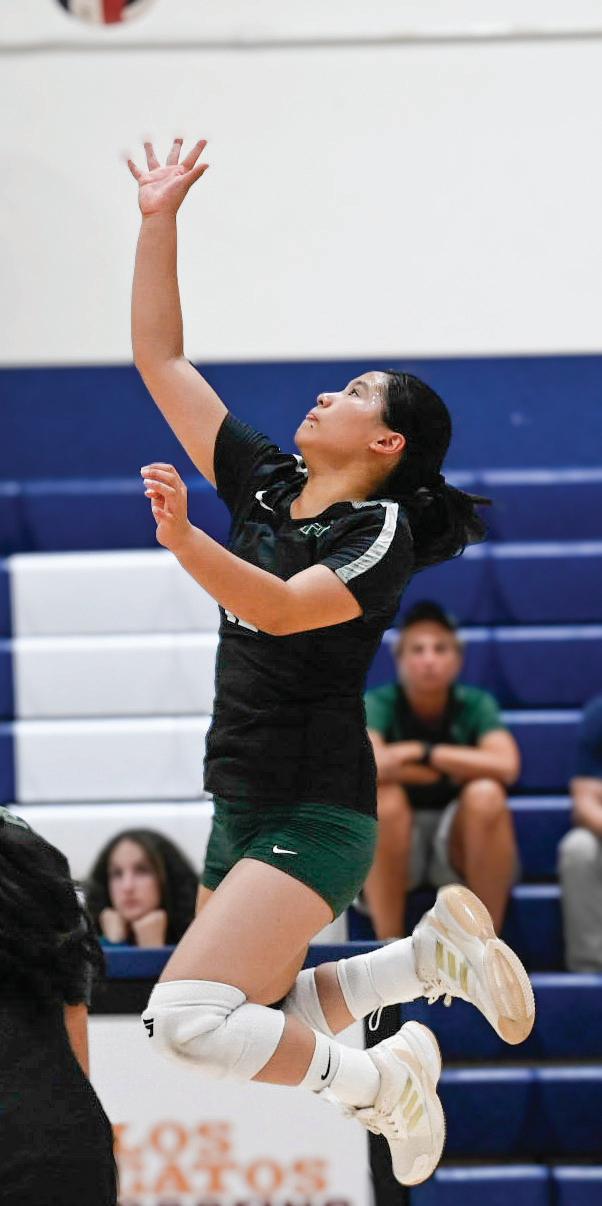
Varsity girls water polo held multiple tight matches, clinching by 6-5 in the third overtime period against Los Gatos. Girls golf has maintained their spotless record of 8-0, with frosh players performing well.
After dominating in their first two games 7-0, the girls tennis team managed to scrap together a 4-3 win against Menlo after the final doubles team secured their victory. Varsity boys water polo came back from a defeat to seize Harker Day 15-10. Even after moving up a division, the varsity girls volleyball team prevailed, winning their season opener in a narrow five-set victory.


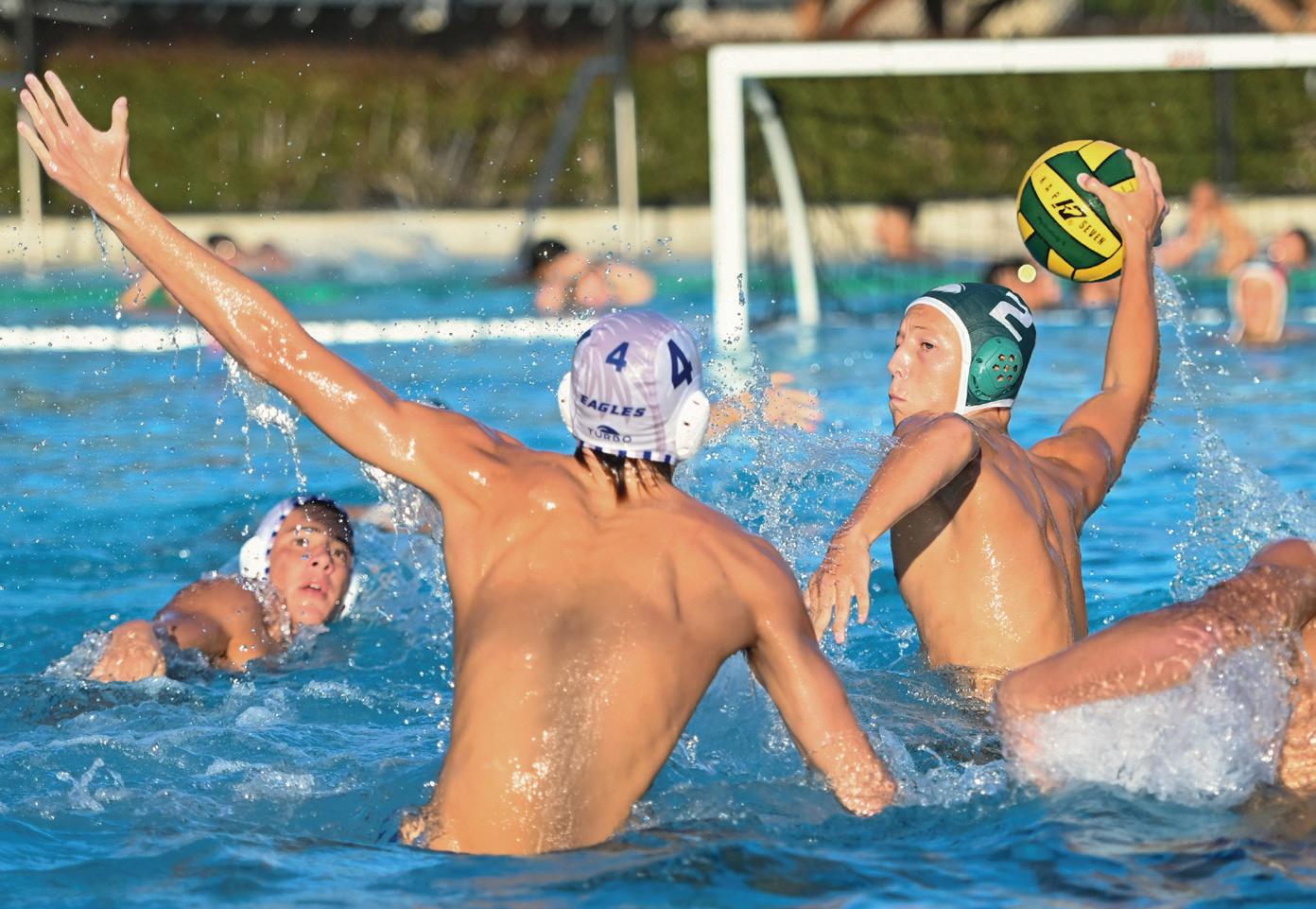

Classes gear up for showdown at Spirit Week
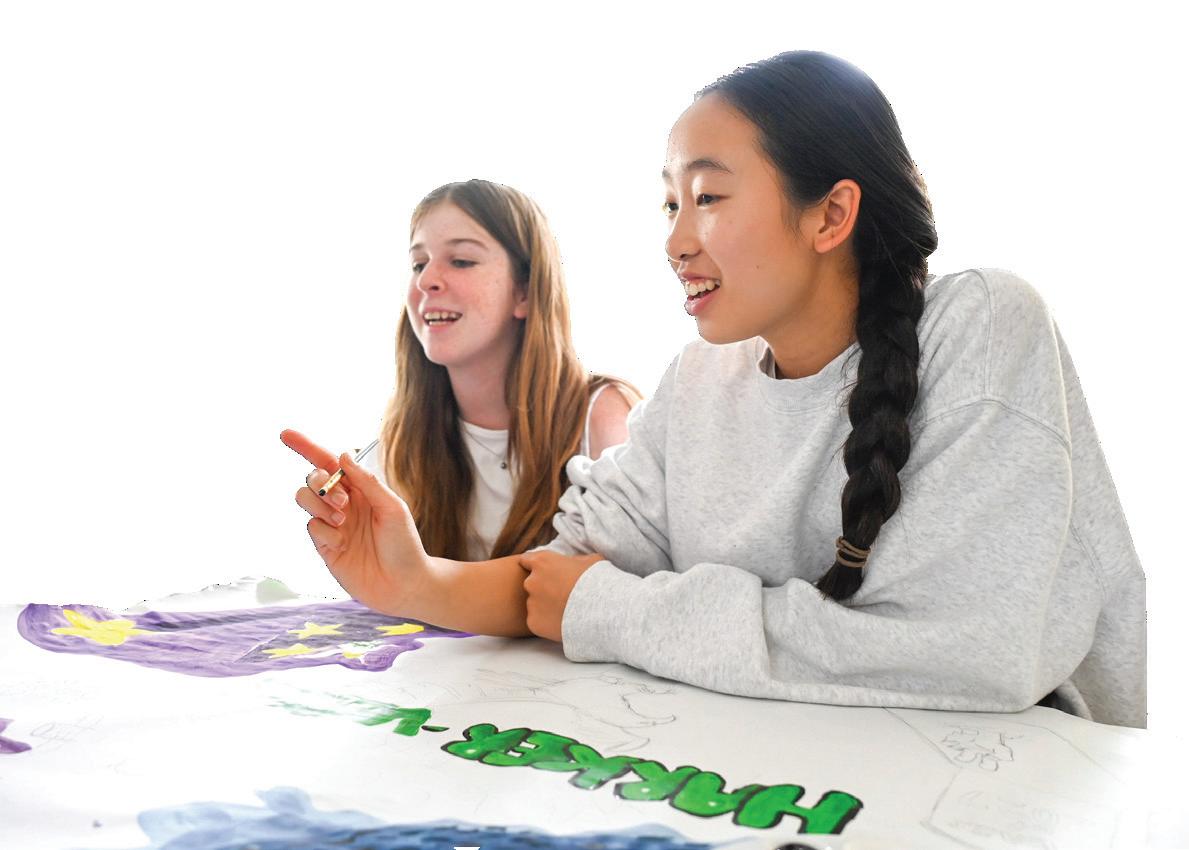
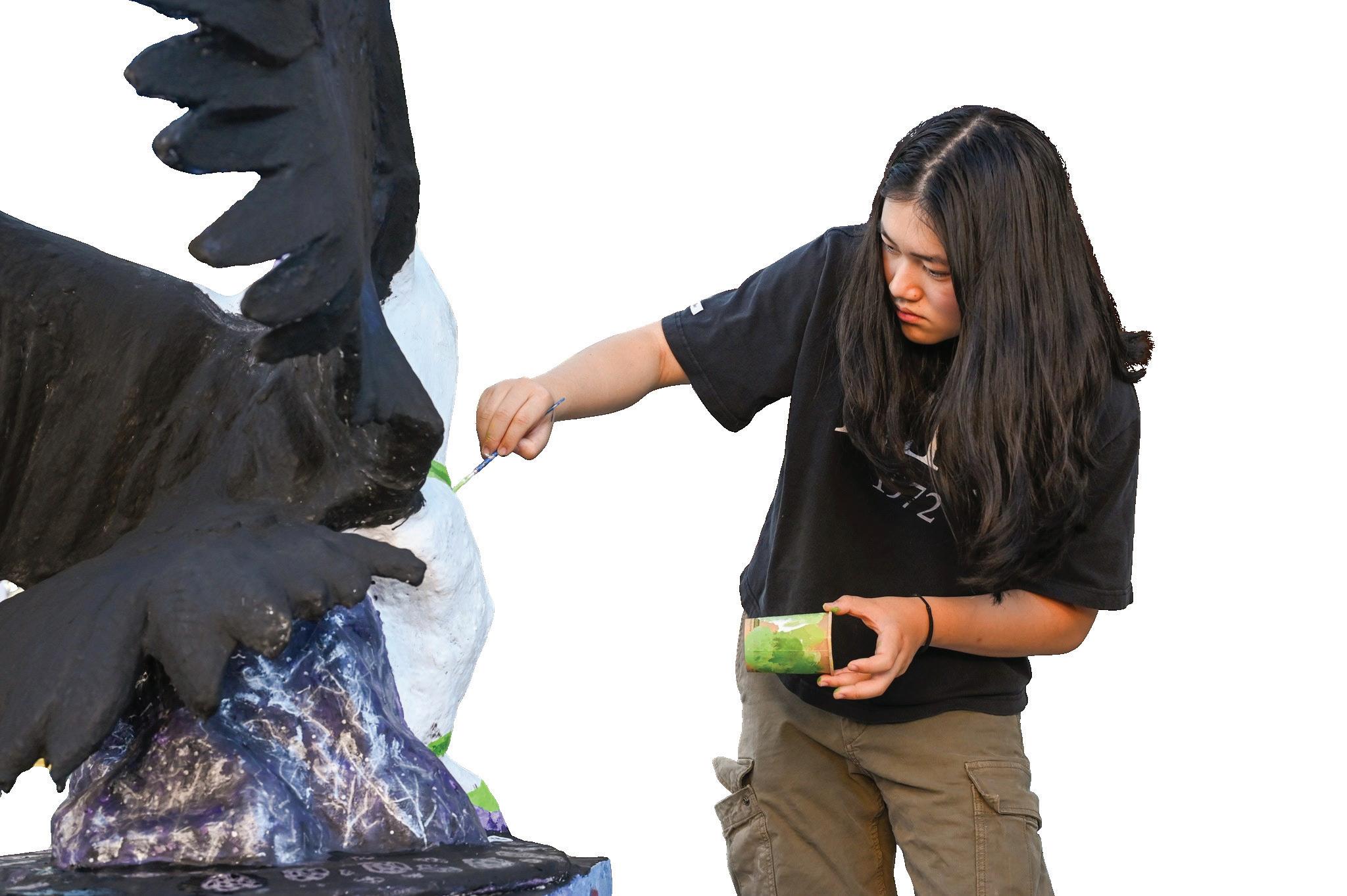
Eagle painting
Classes continued the annual tradition of painting eagle statues to compete for spirit points.
Eagle painting is different than doing art alone — you need to check your ideas and work with others.

PHAM (9) EAGLE PAINTER
Each class designed and painted their eagle based on their spirit theme: Magical Harker for seniors, Harker Zombie Apocalypse
for juniors, Harker in Outer Space for sophomores and Harker Under the Sea for frosh. Students also participated in a live eagle painting outside Nichols Hall during Harker Day.
“For eagle painting, you need to check your ideas with others and work with other people,” frosh eagle painter Madeline Pham said. “Oftentimes it’s different from working alone. There are more things you need to work out in terms of communication.”
Harker Spirit Leadership Team (HSLT) and each class’s SAB organized spirit events and activities leading up to Spirit Week.
HSLT sought to improve event fairness by updating scoring rubrics. For dress-up days, representatives enforced stricter guidelines while providing examples of what counted.
SAB managed lip sync logistics and encouraged participation in events.
& SAB prep


Seniors, embracing their magical theme, included characters like the Genie from “Aladdin,” Gandalf from “The Lord of the Rings,” and Harry Potter. Sophomores, following their space theme, painted their eagle as Buzz Lightyear.
Eagles will be scored based on creativity, quality, cohesion, spirit, and cleanliness. Completed eagles are due on Oct. 10 at 5 p.m.

IN STYLE Junior
Sync participants Isabelle Niu and Hannah Jiang strike poses as they rehearse for the lip sync. Juniors designed their lip sync based on their class’s theme of zombies. HSLT created a rubric with scalebased scoring, which judges will use to rank performances at
Lip sync rehearsal
Each class choreographed and rehearsed lip syncs in preparation for Spirit Rally performances on Oct. 16. Lip syncs, which include a faculty cameo and at least three songs, are graded on flair, complexity, storyline and overal impression.
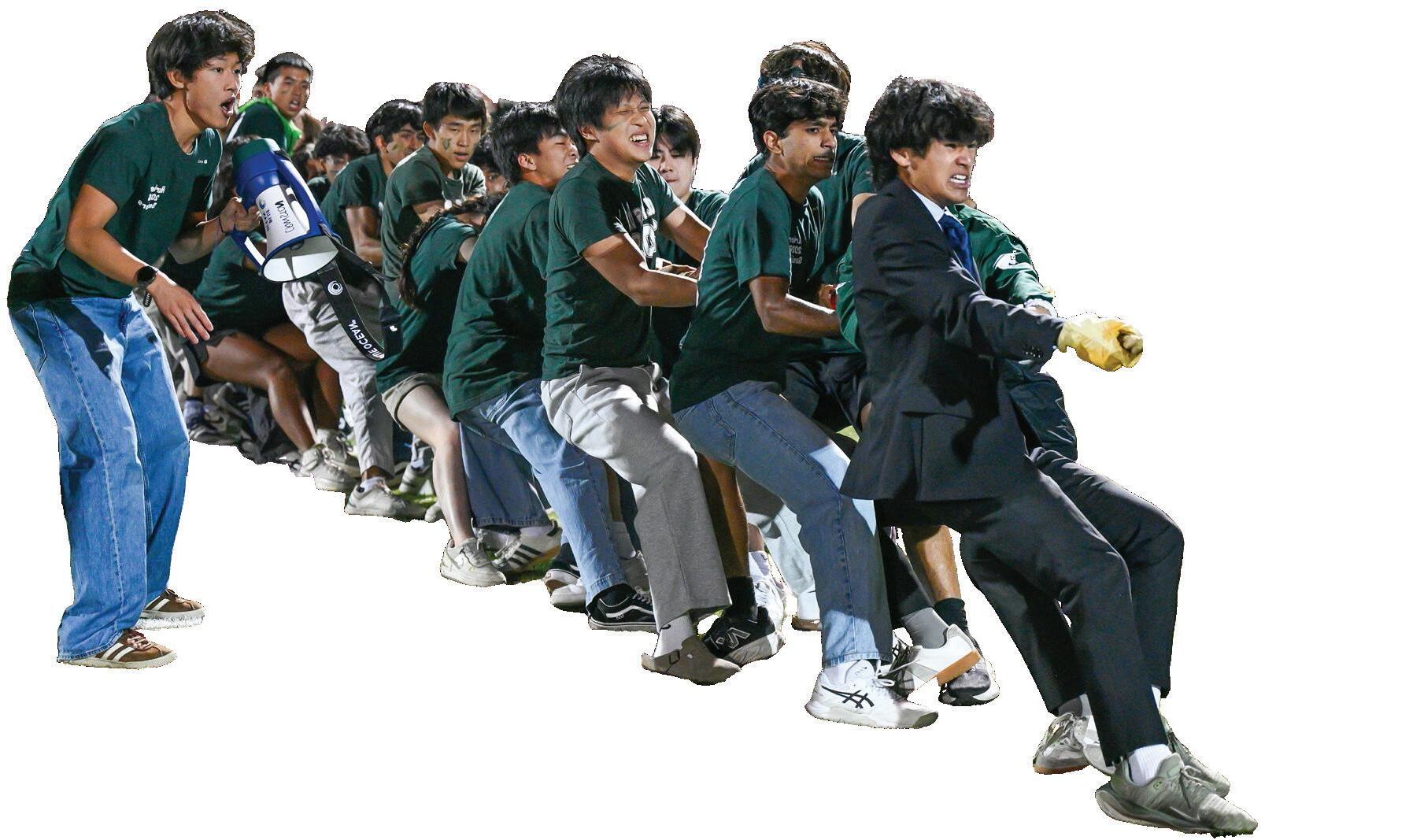




Juniors and seniors defeated the frosh and sophomores respectively in the preliminary tug-of-war rounds at homecoming on Saturday.
“The thought that we might not finish on time is really scary,” junior choreographer Cynthia Wang said. “But all that nervousness just builds up to a better performance in the end.”
Frosh fought the juniors before the game and lost in 10 seconds. At halftime, the seniors won in 44 seconds after a brief struggle. The advancing teams will vie for first place, and the losing teams for third, on Oct. 14 after the Spirit Parade.
“It was exciting to beat the frosh,” junior Jonathan Li said. “But we know we still have a championship match.”
